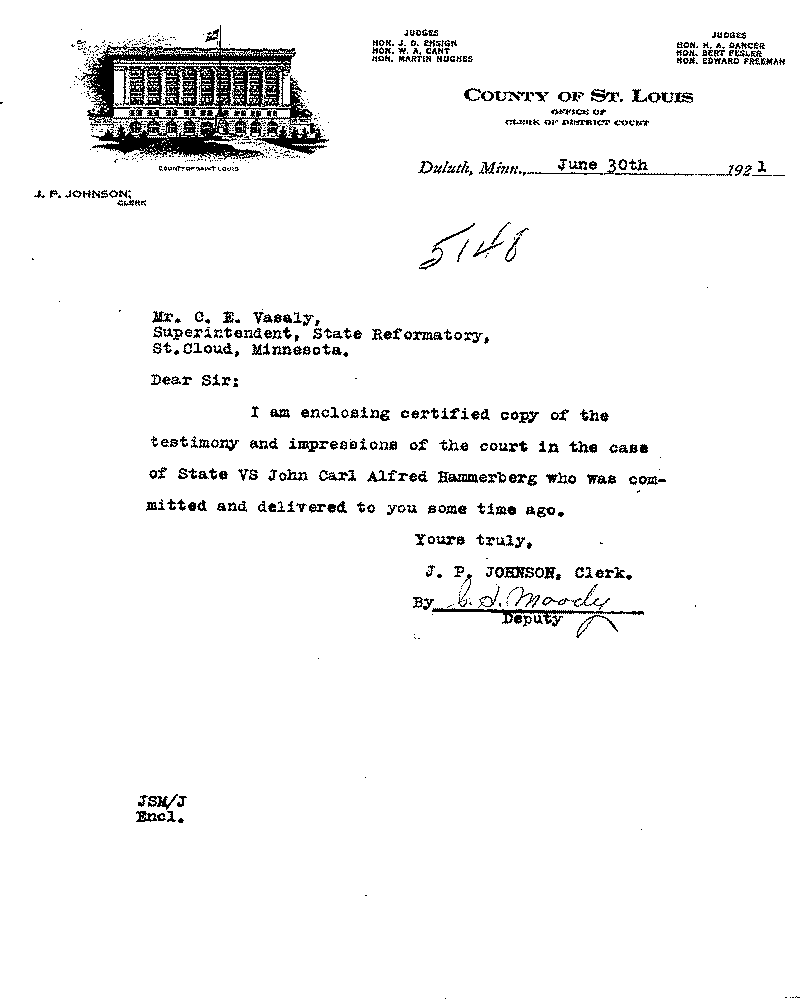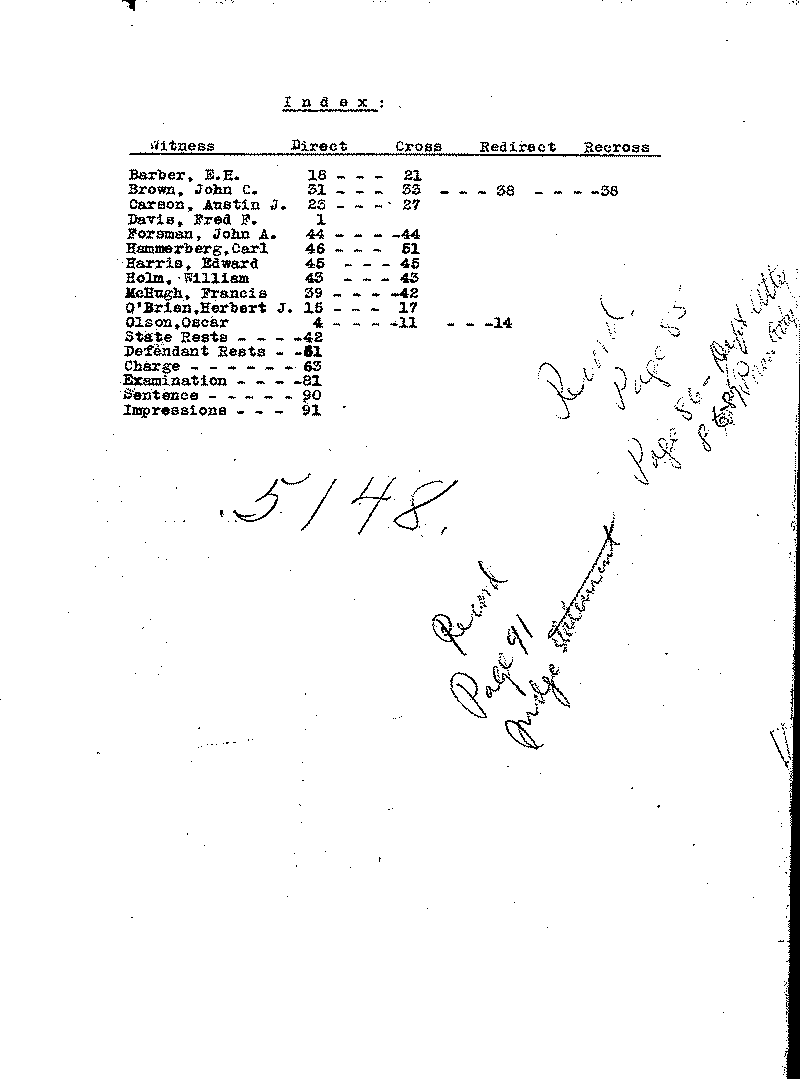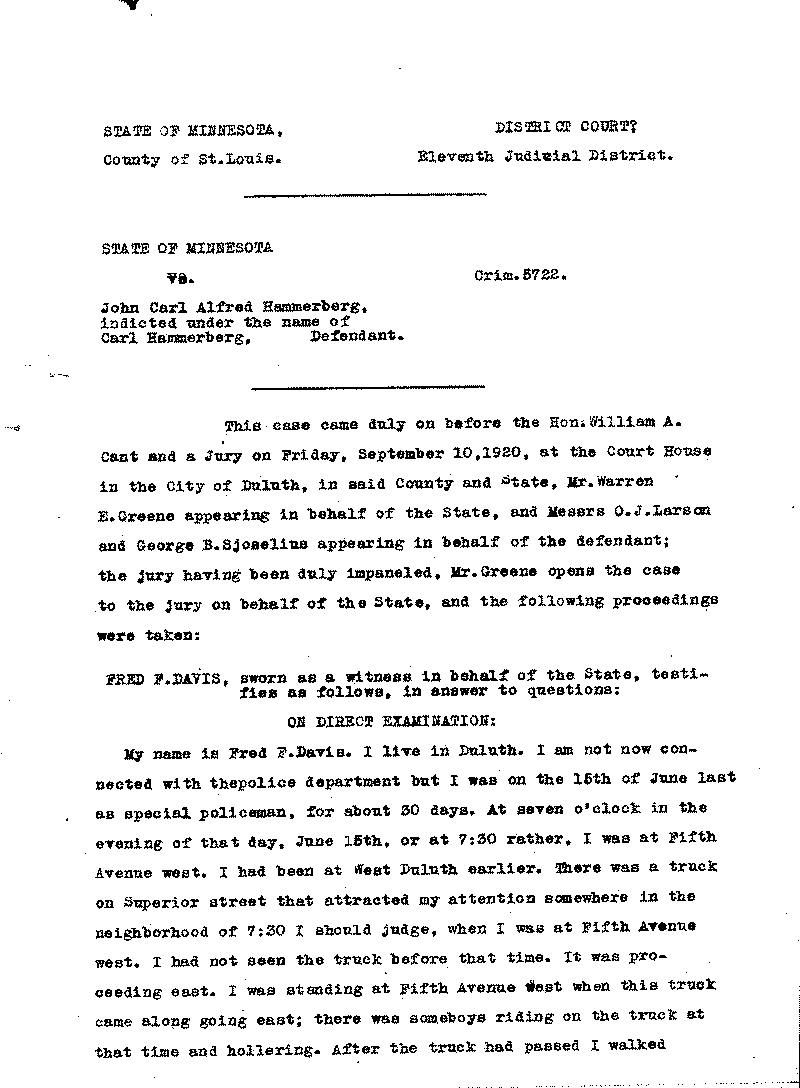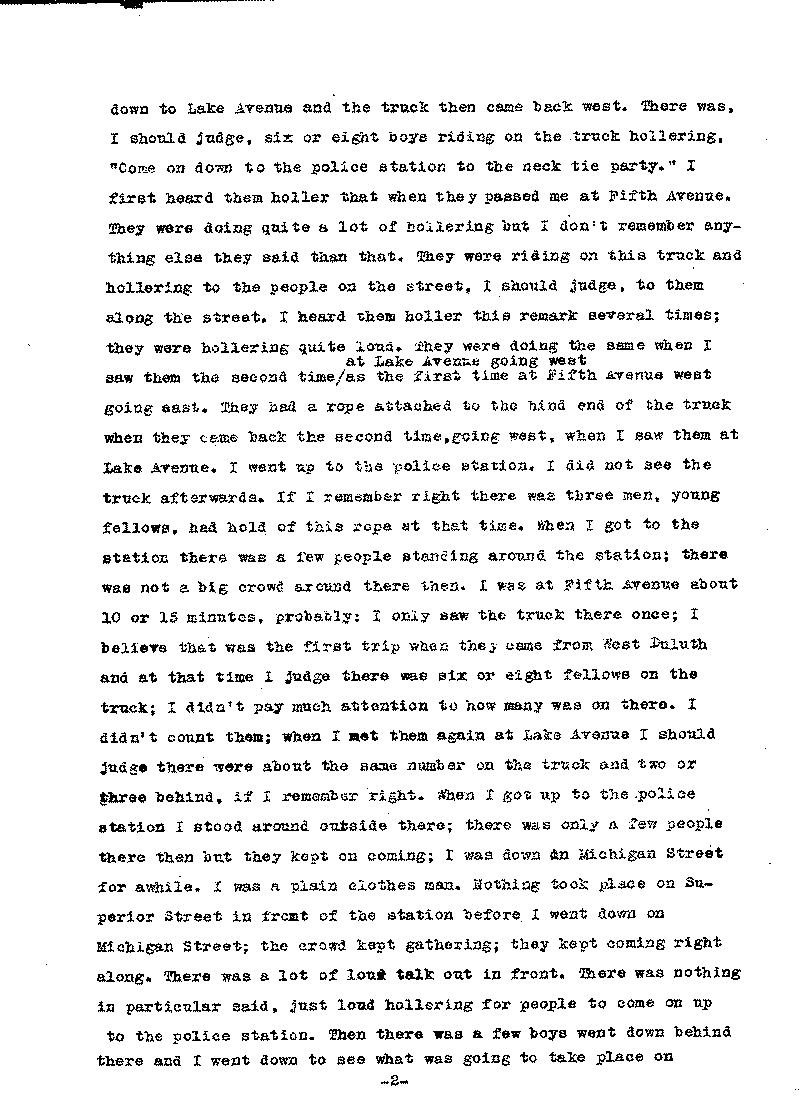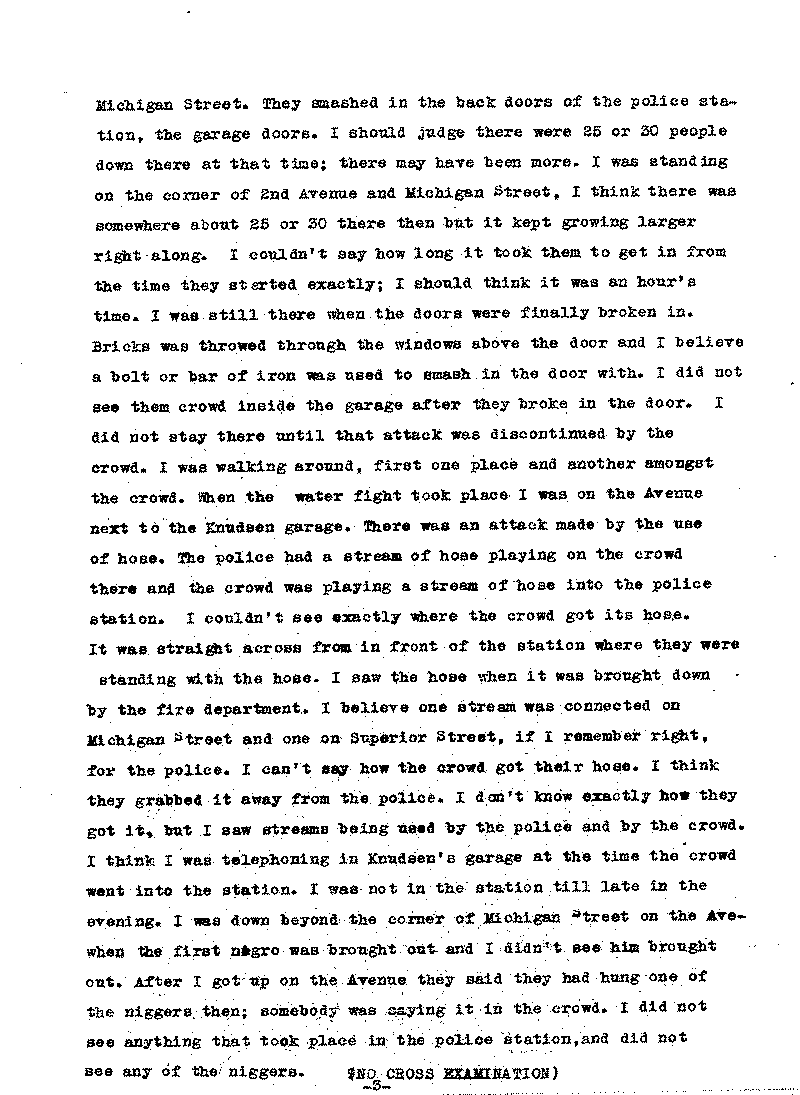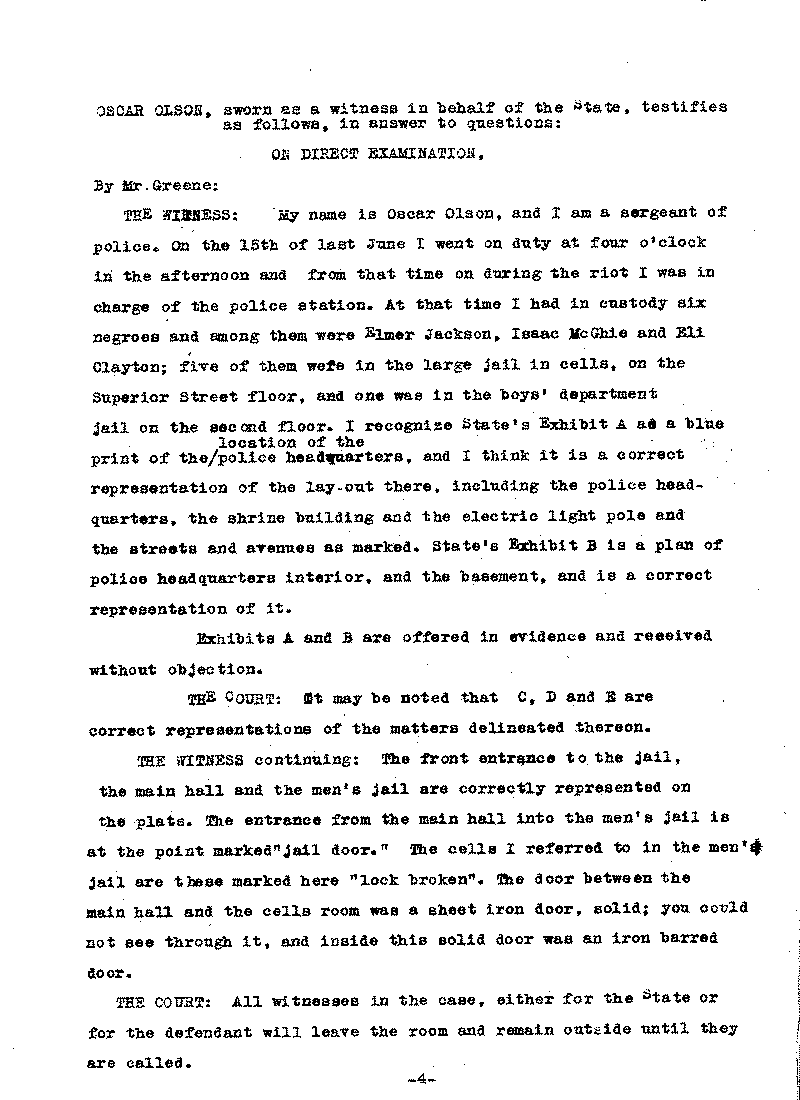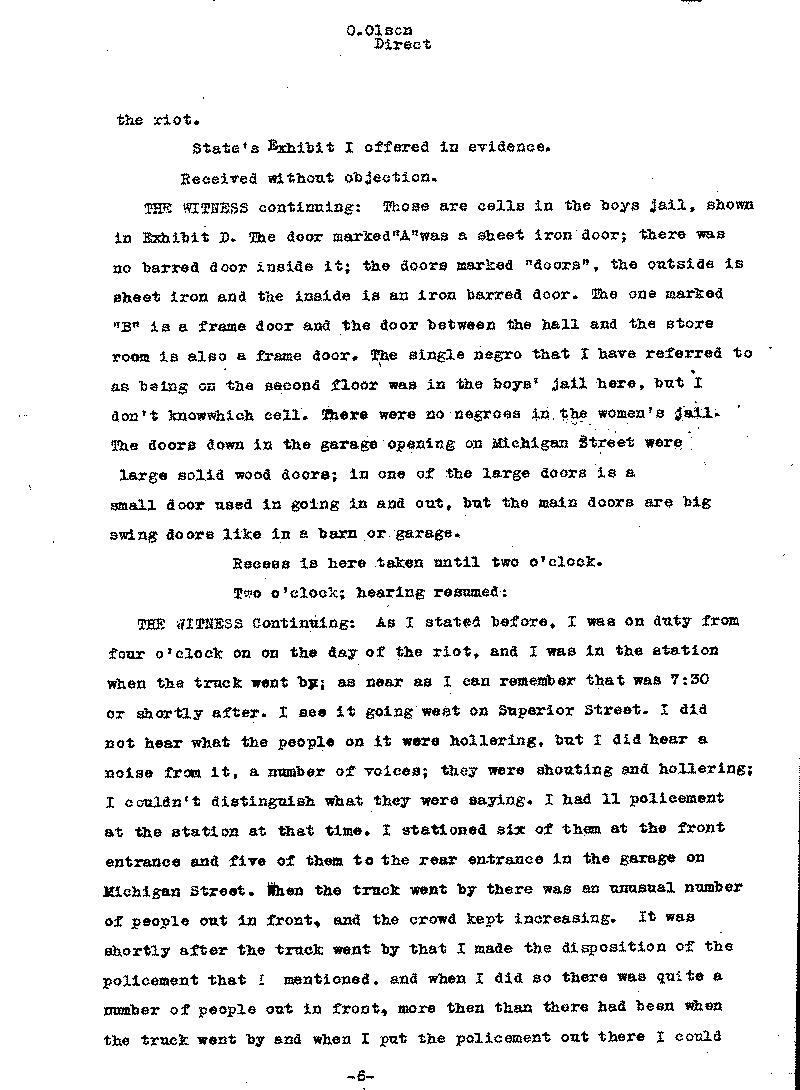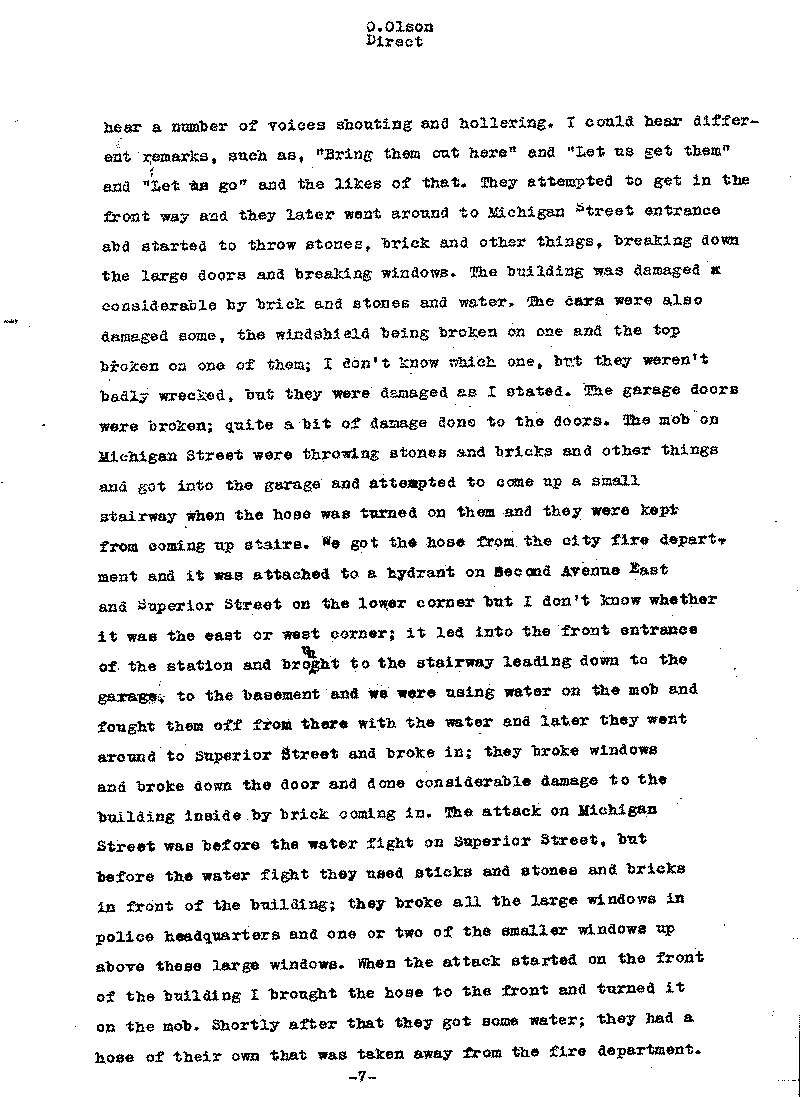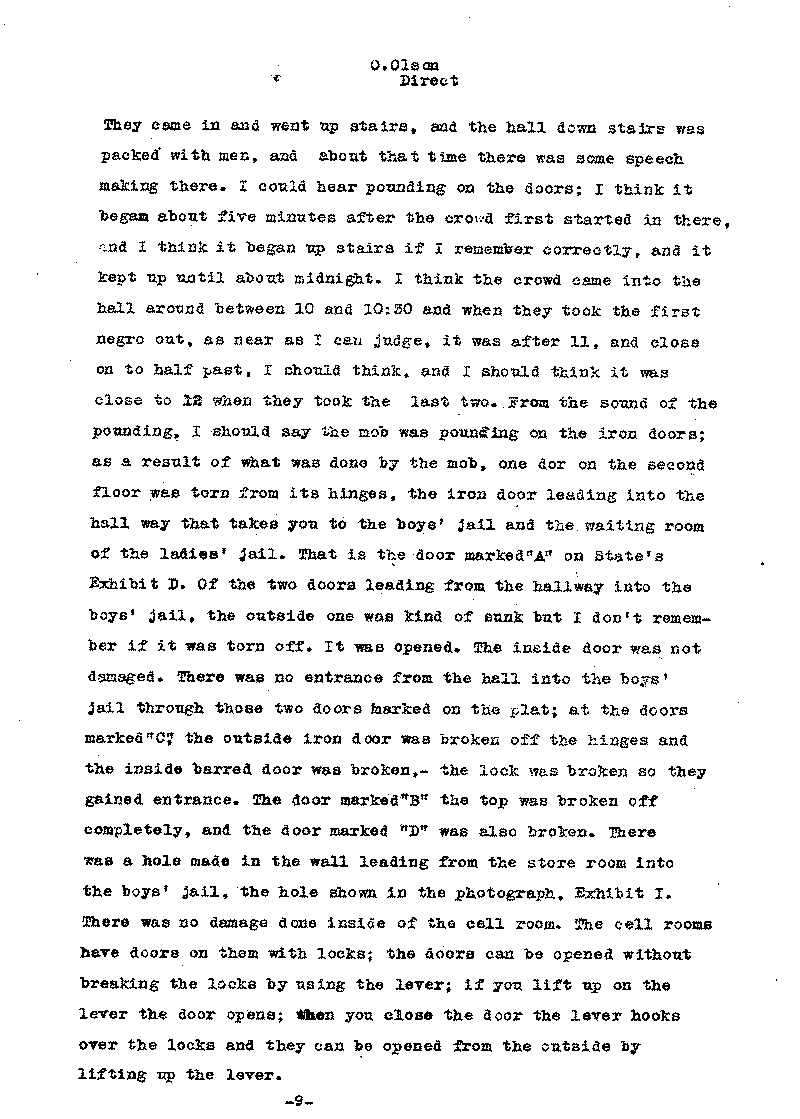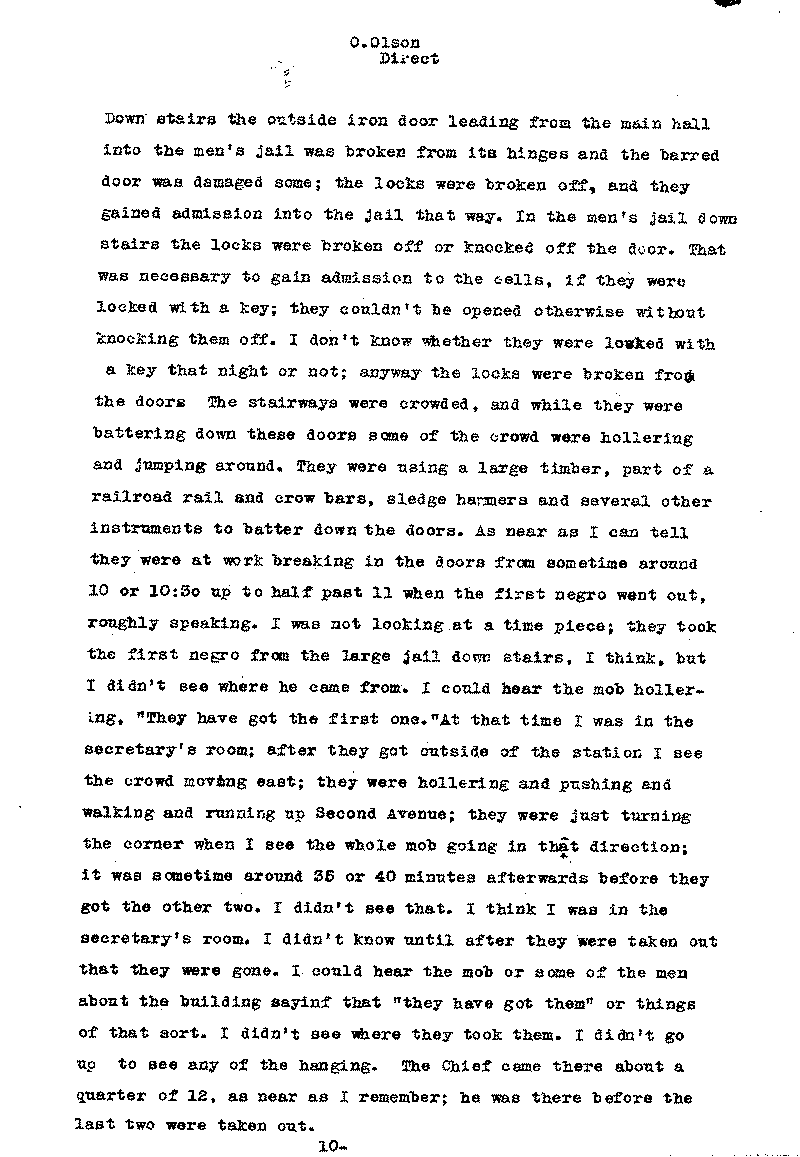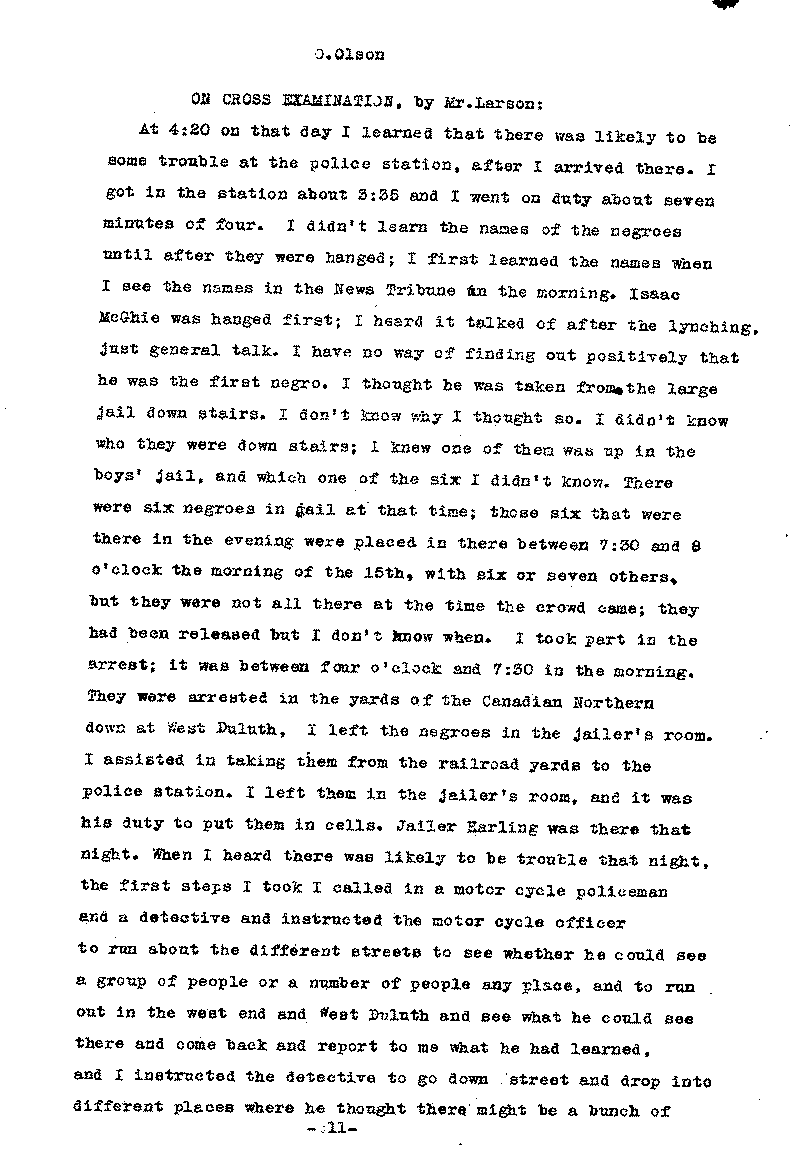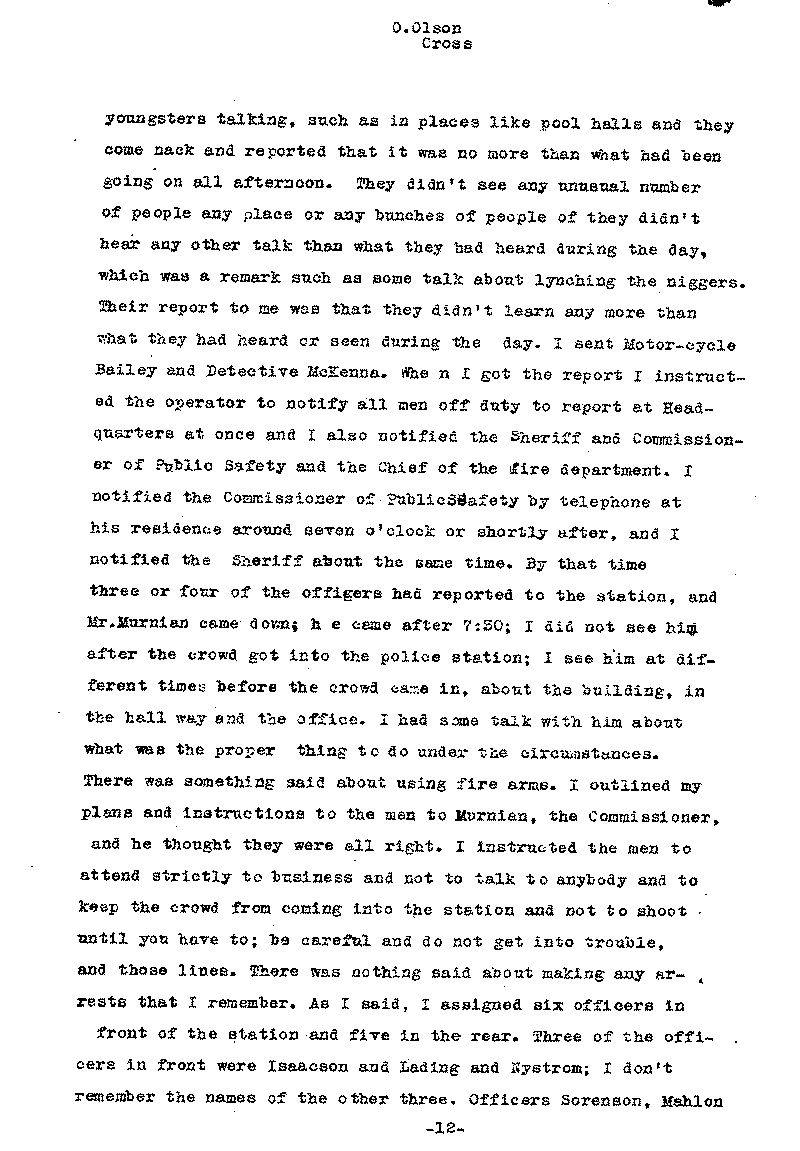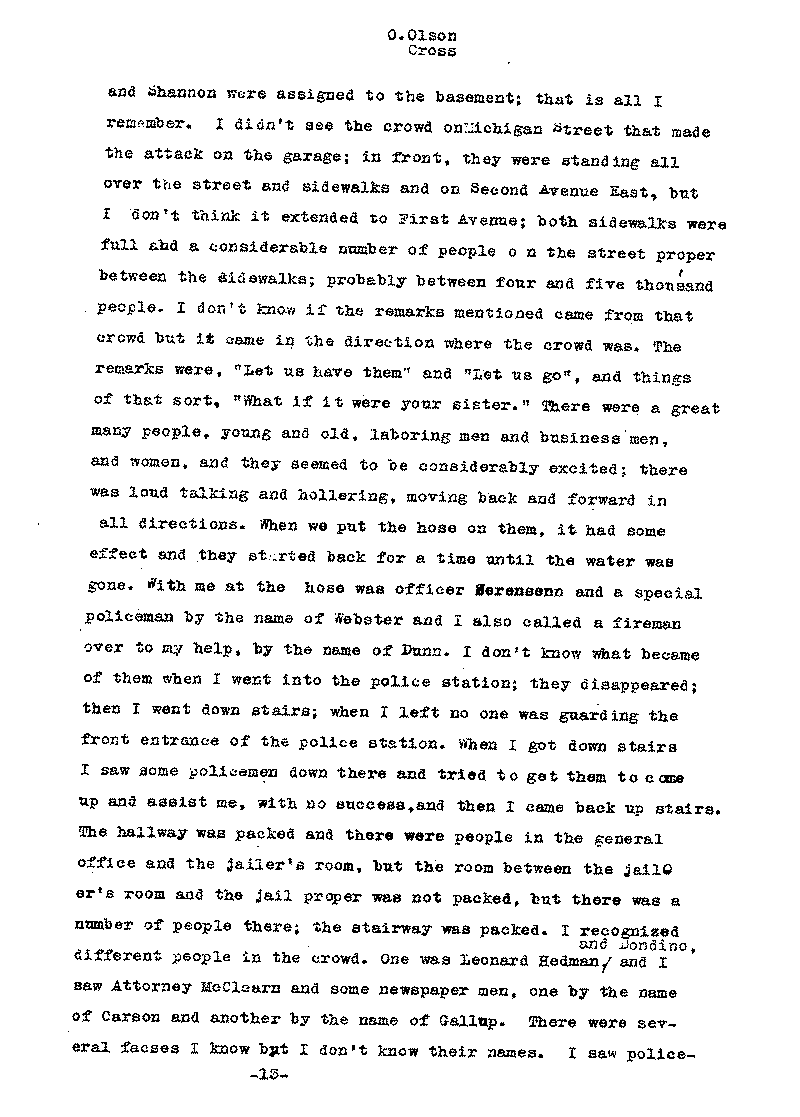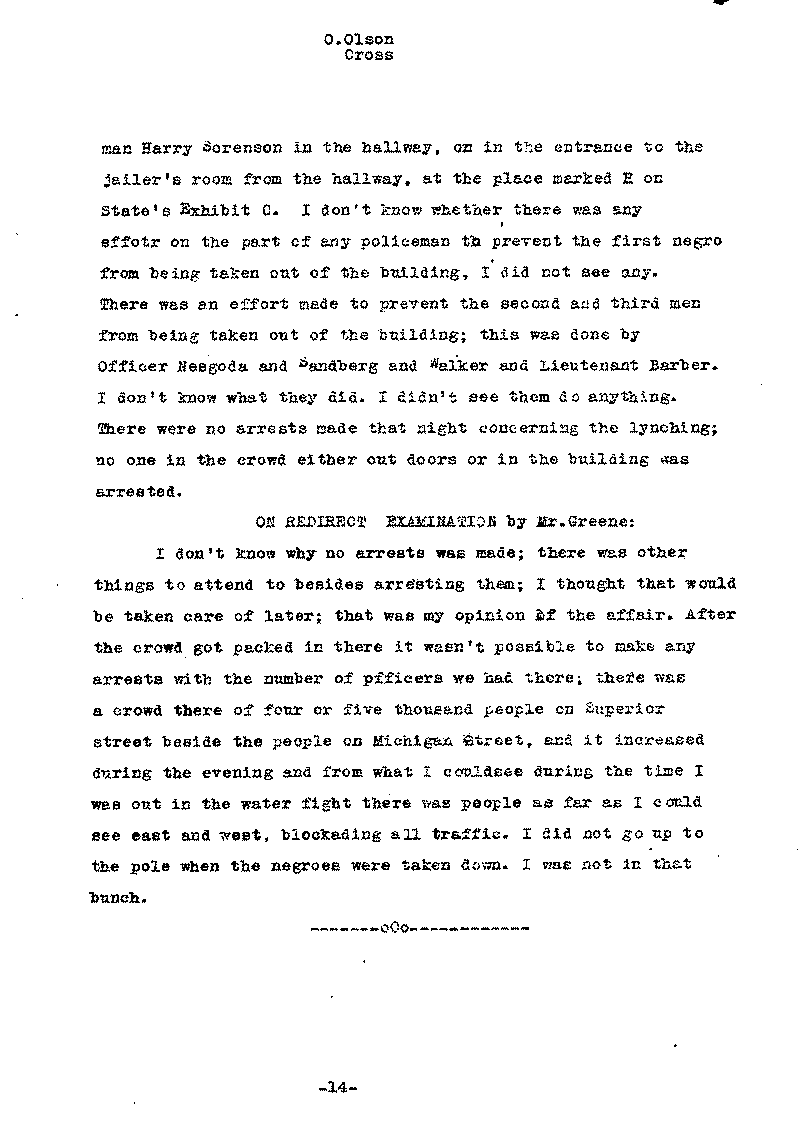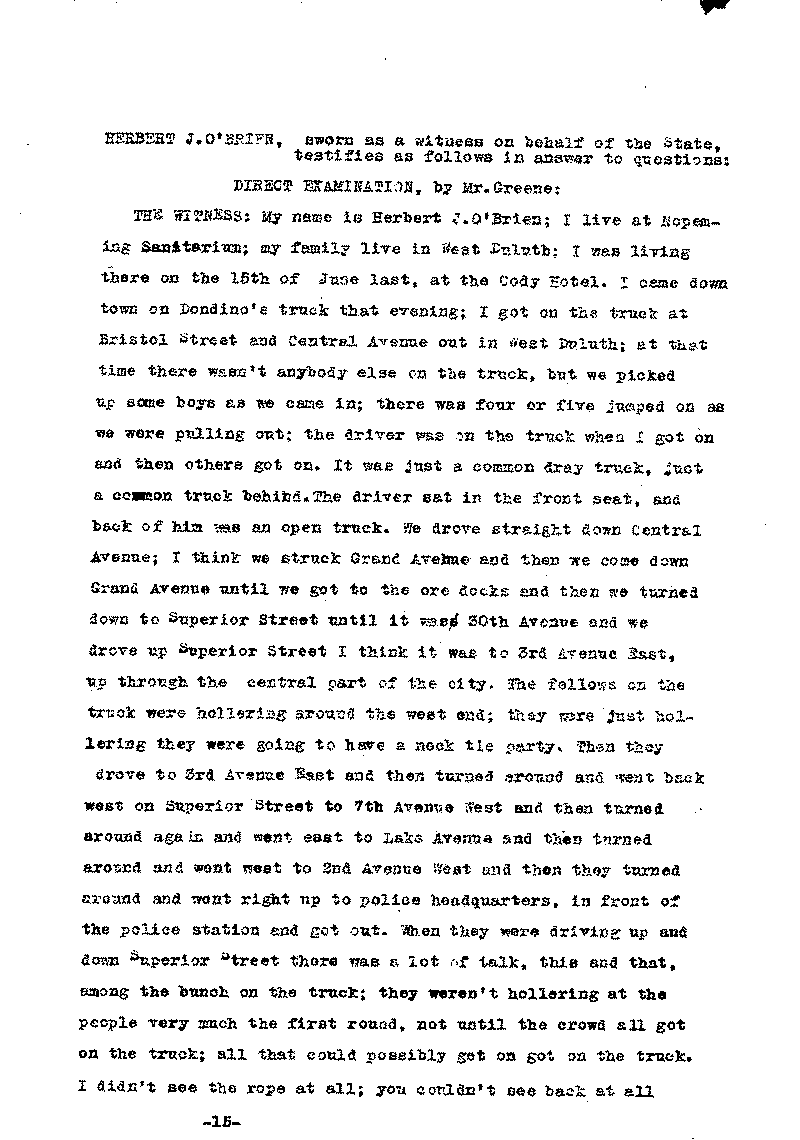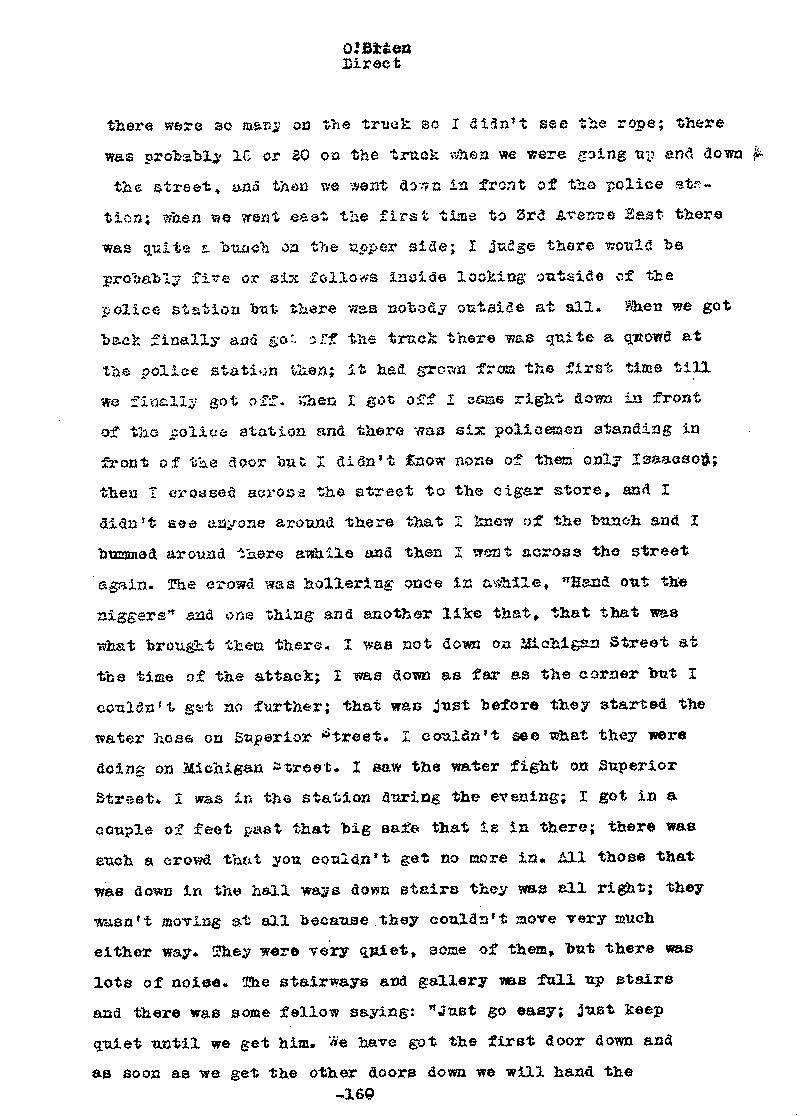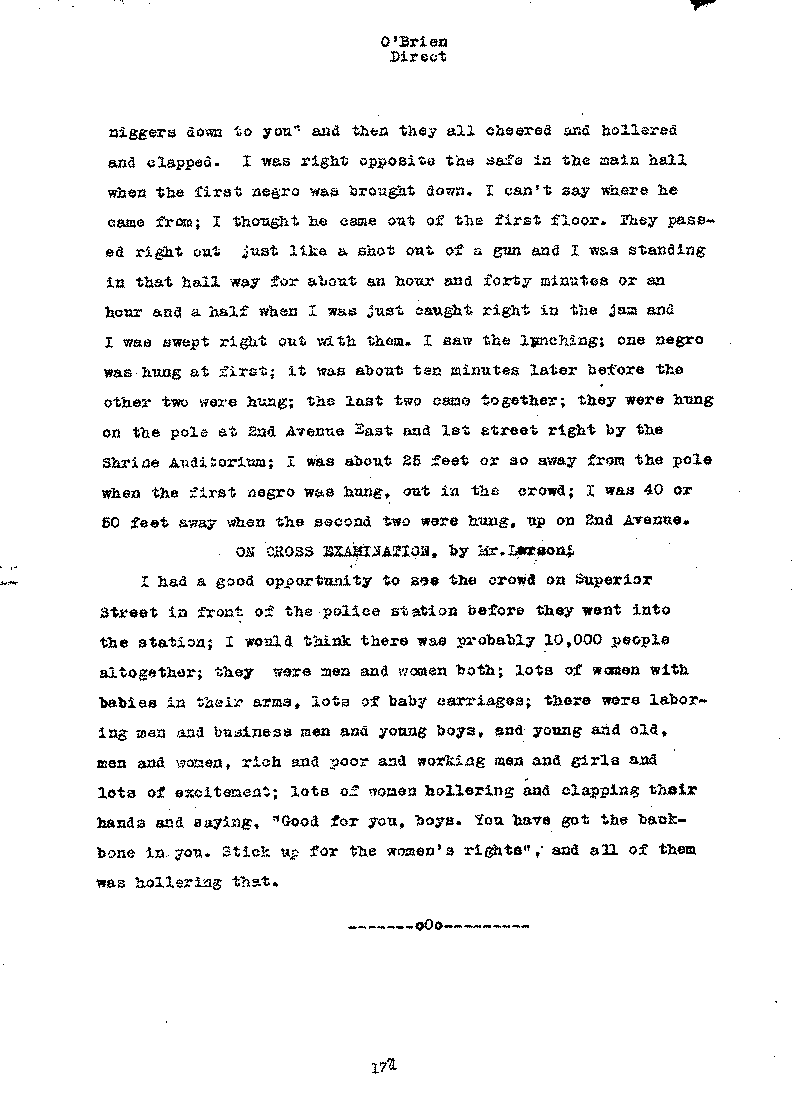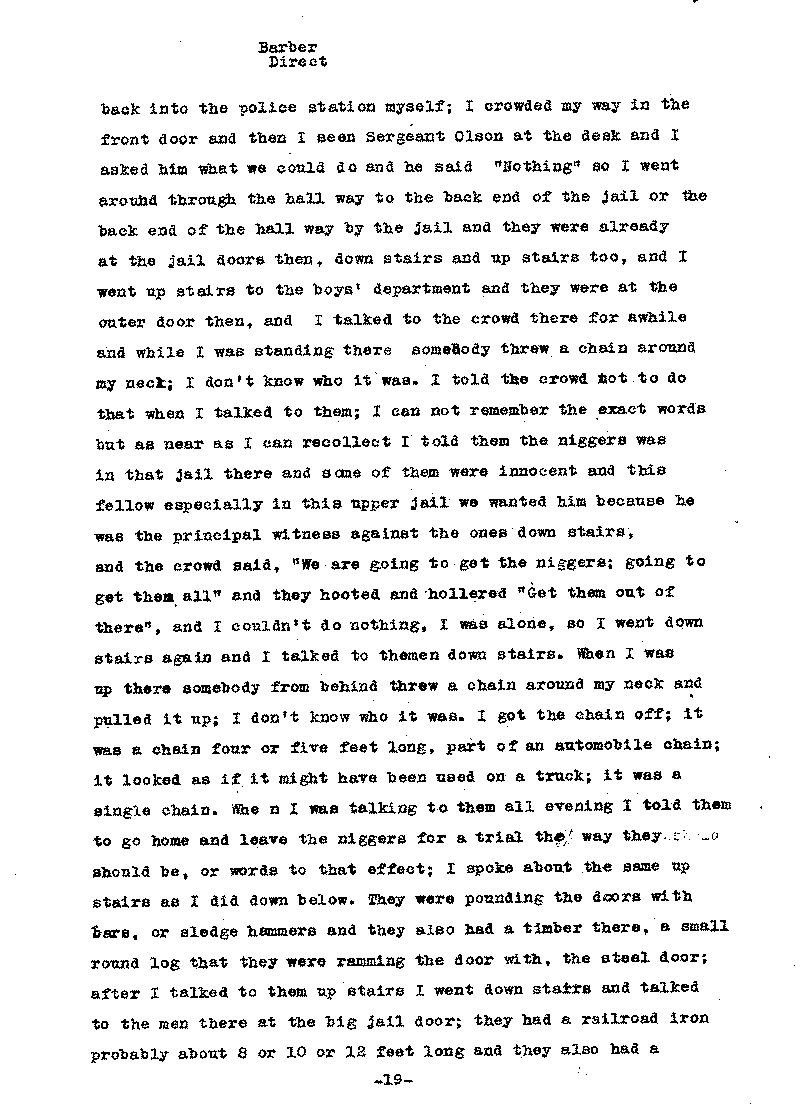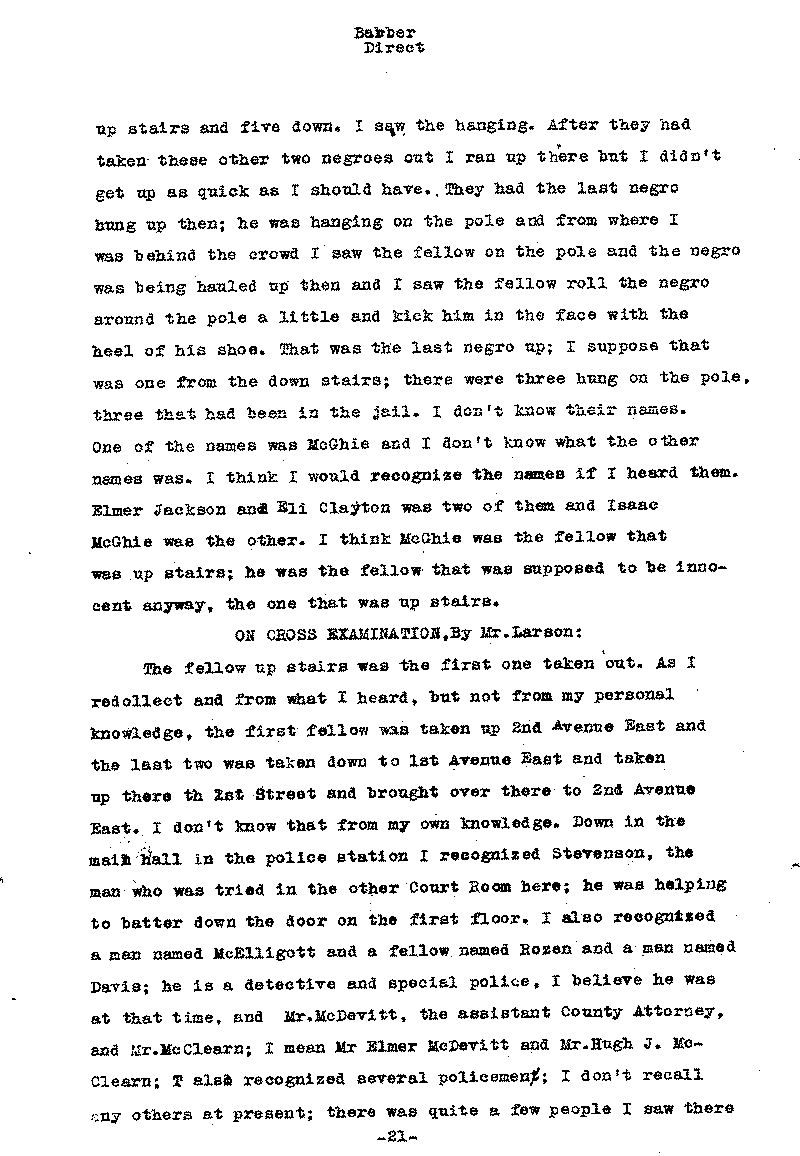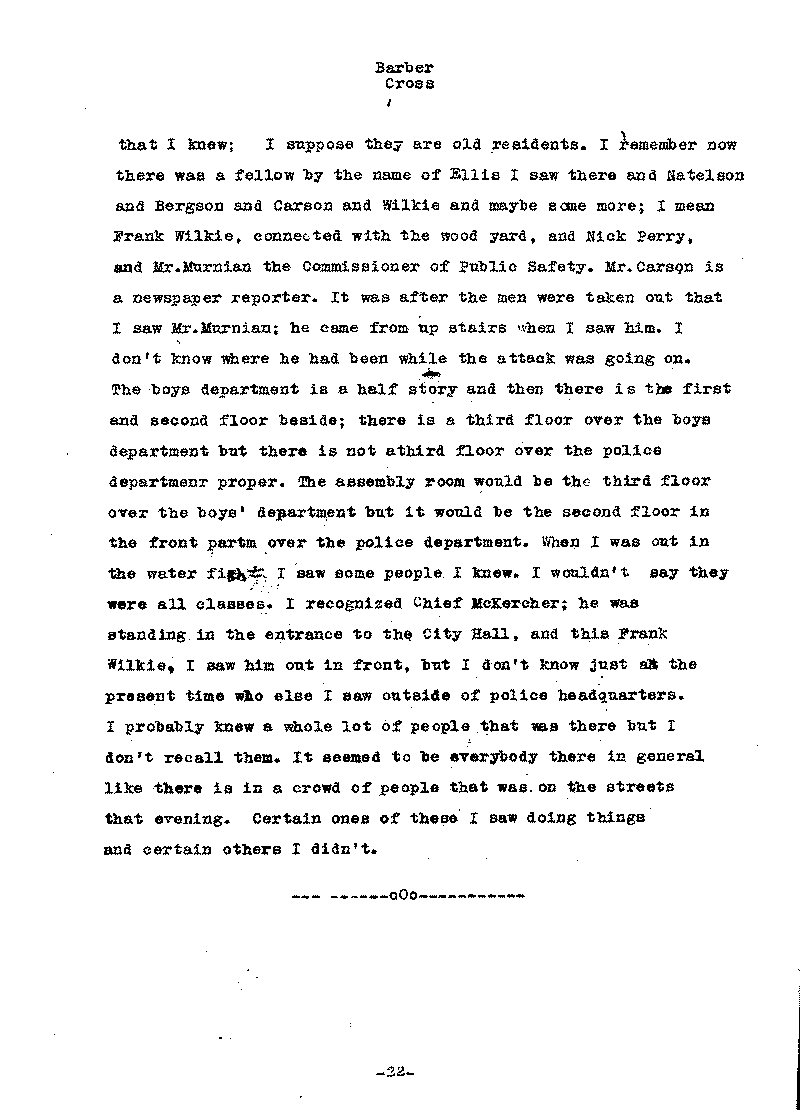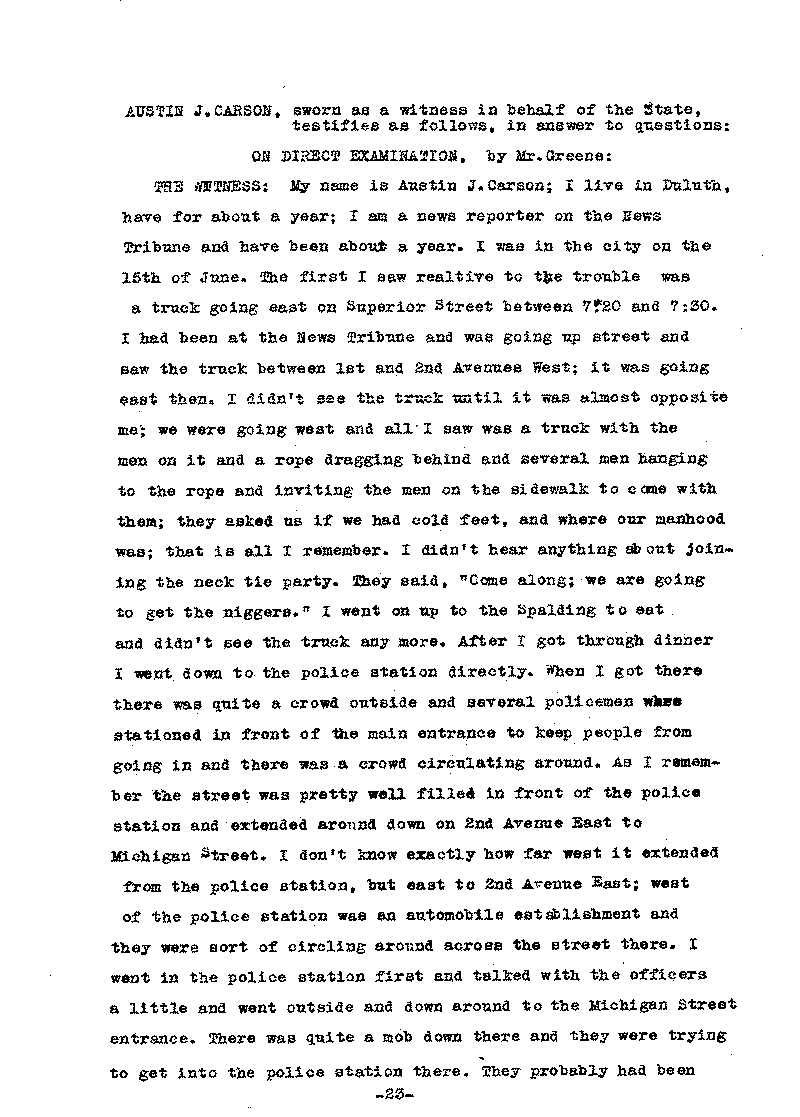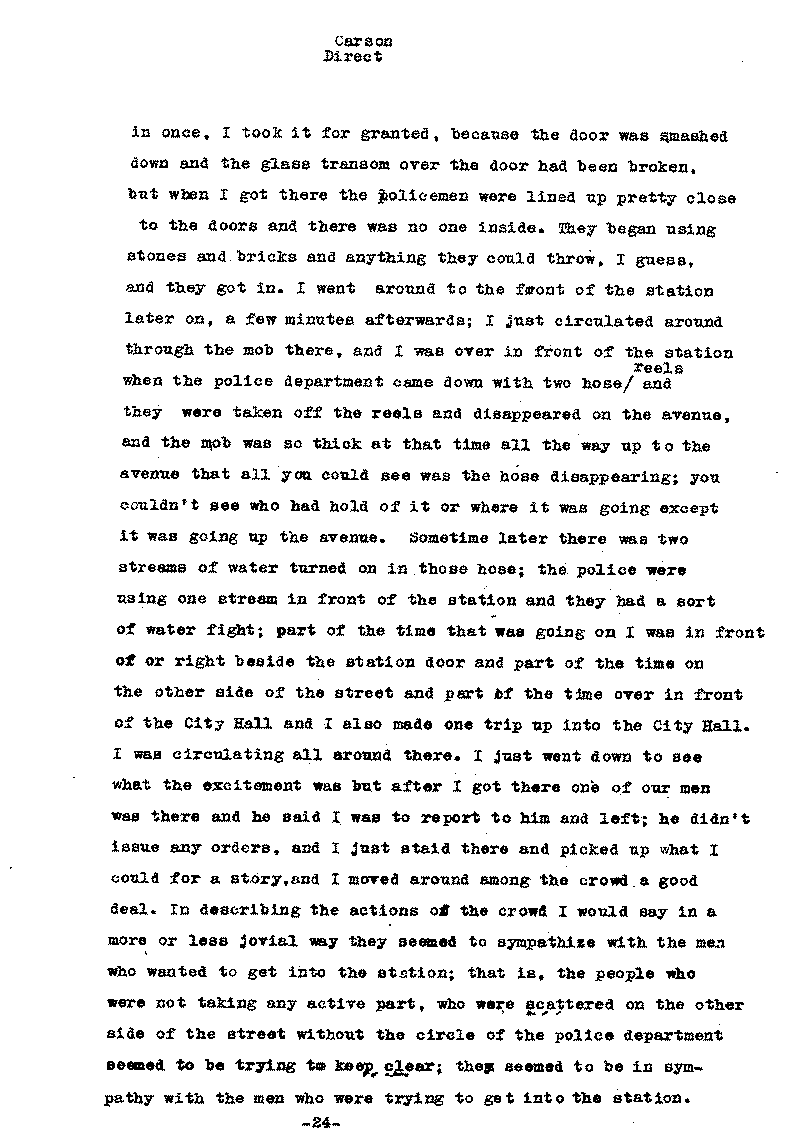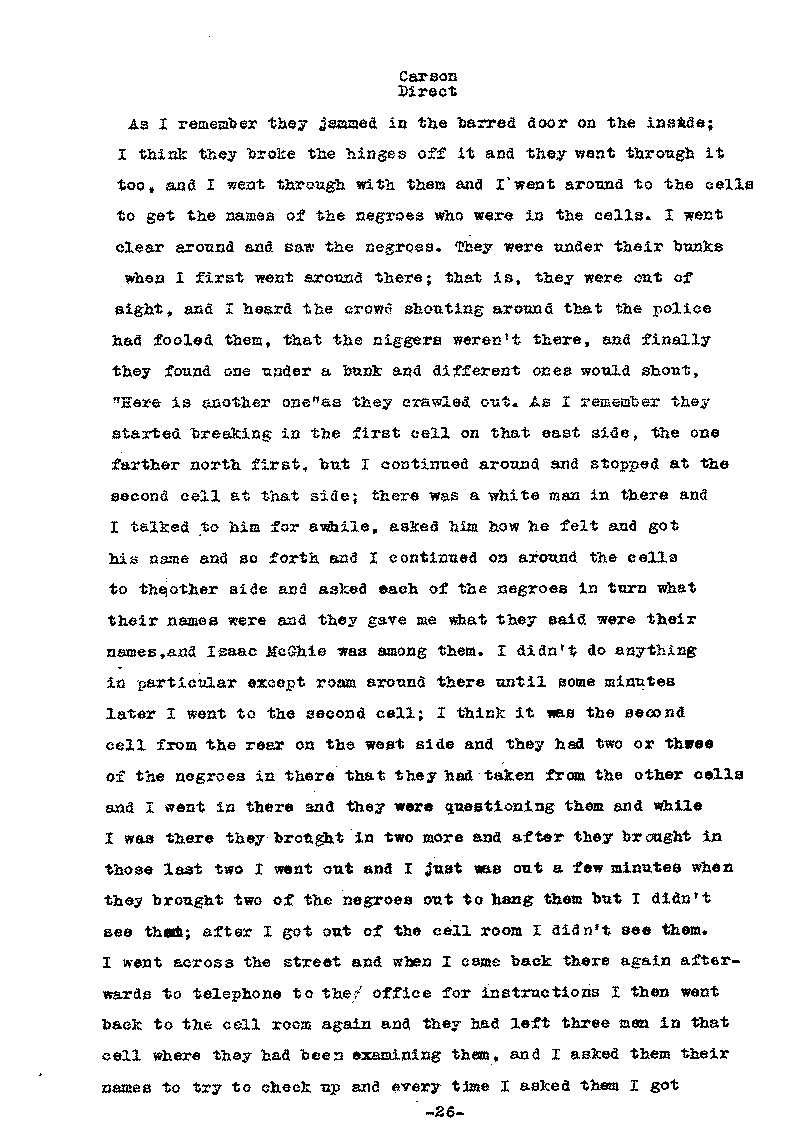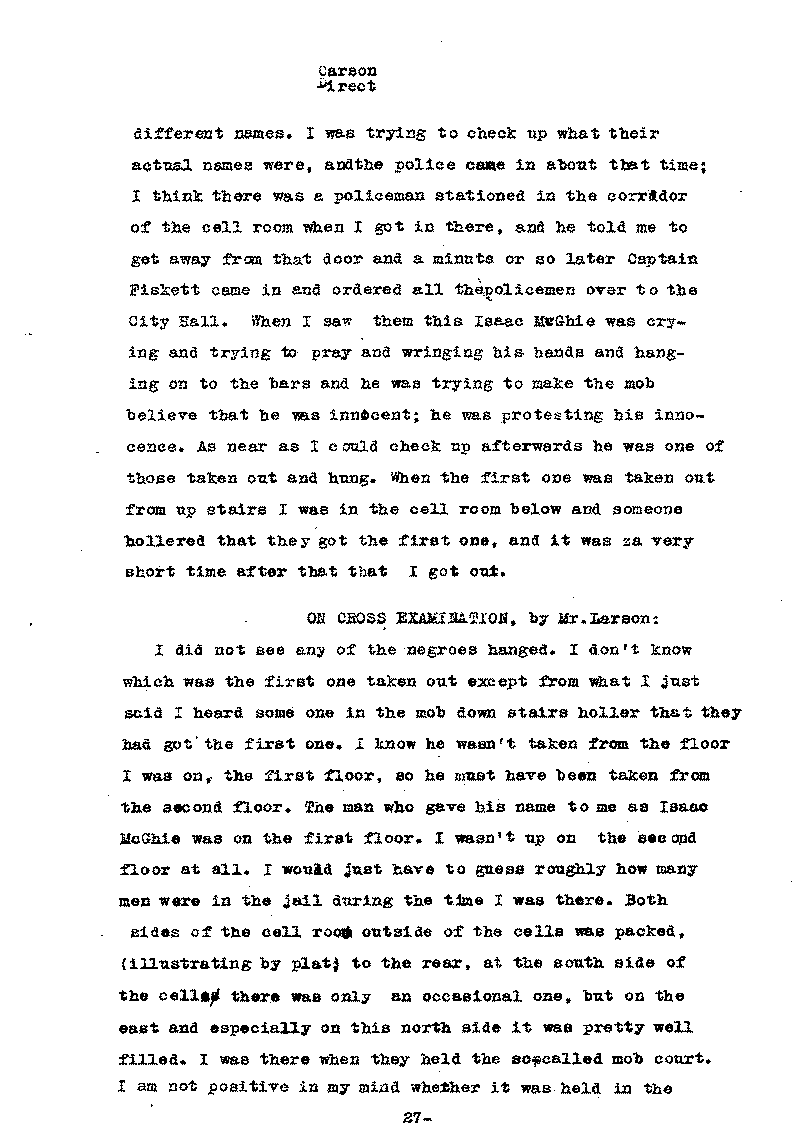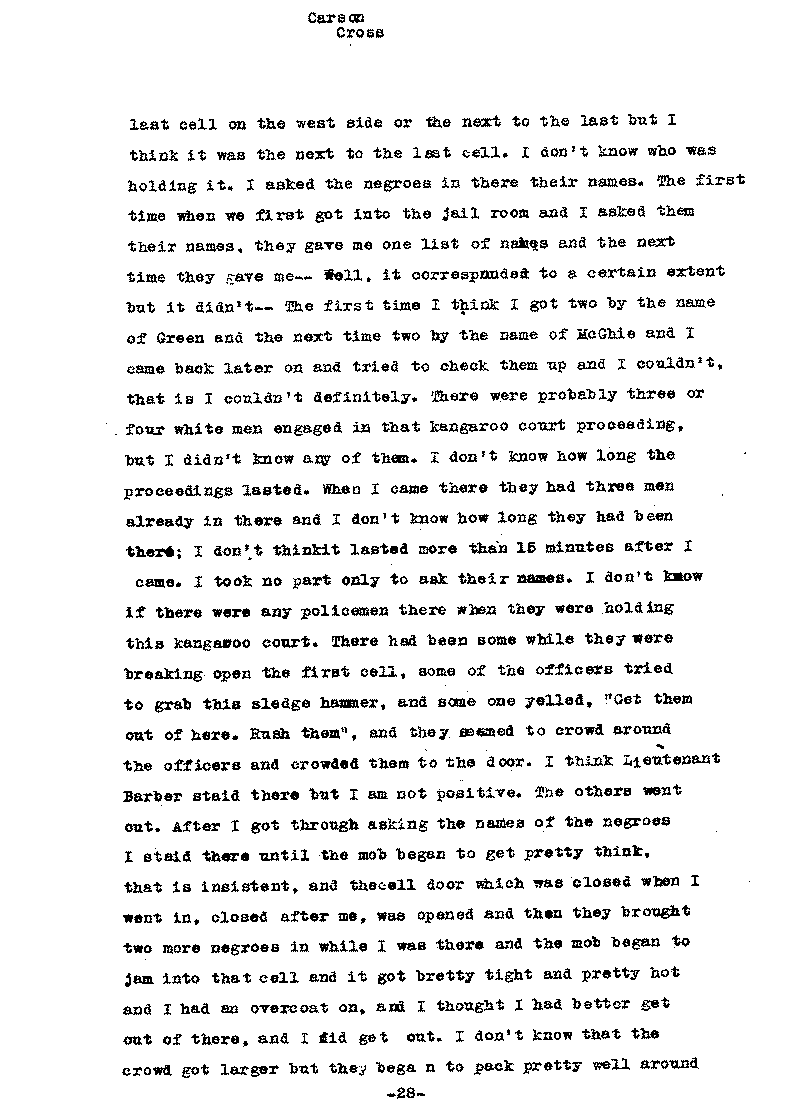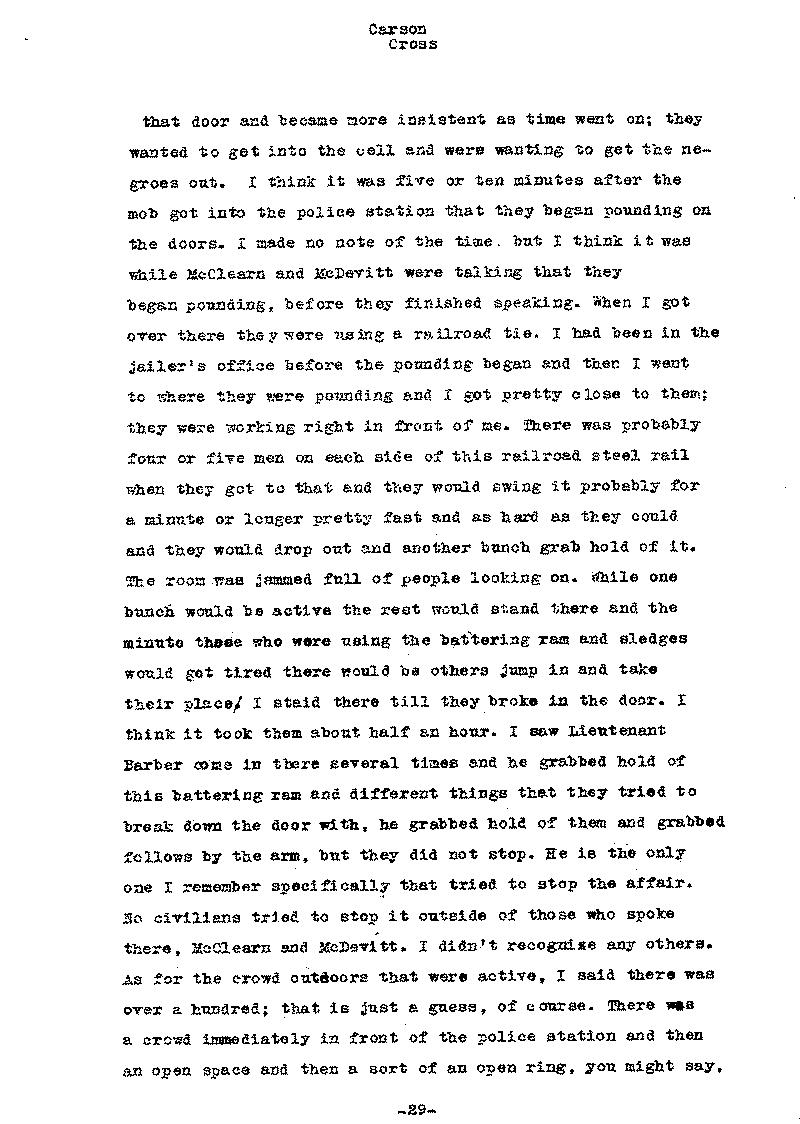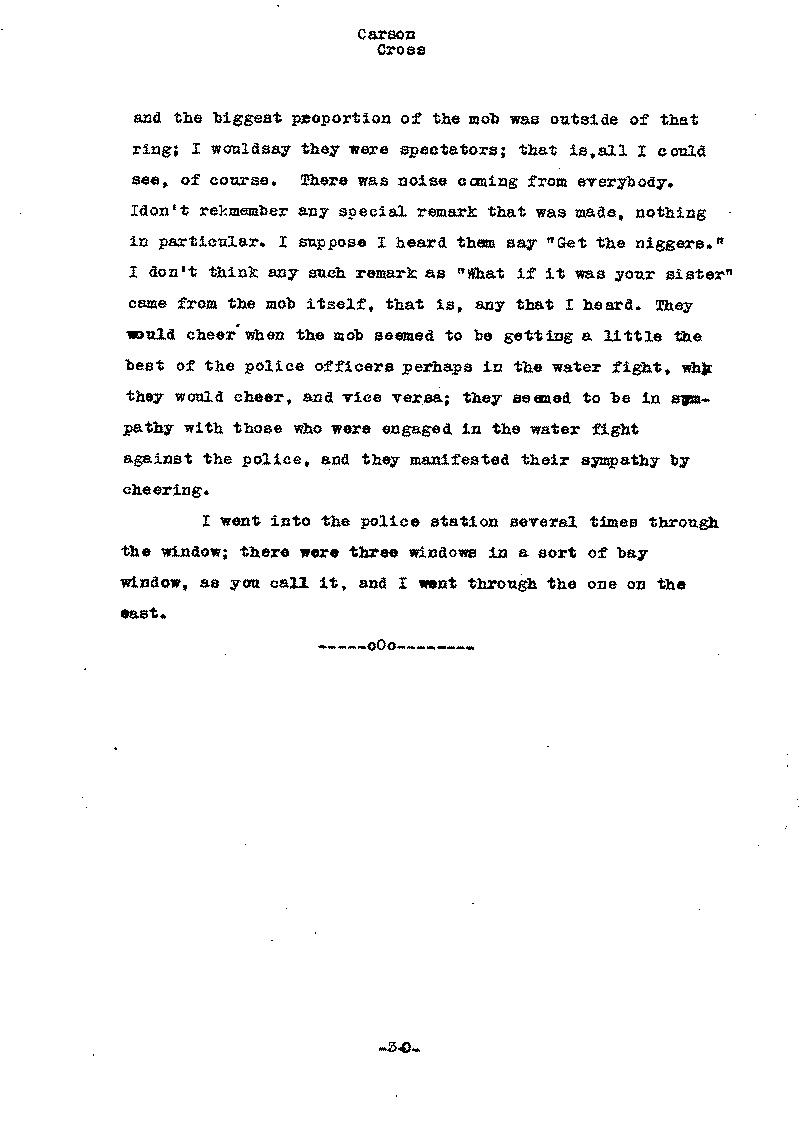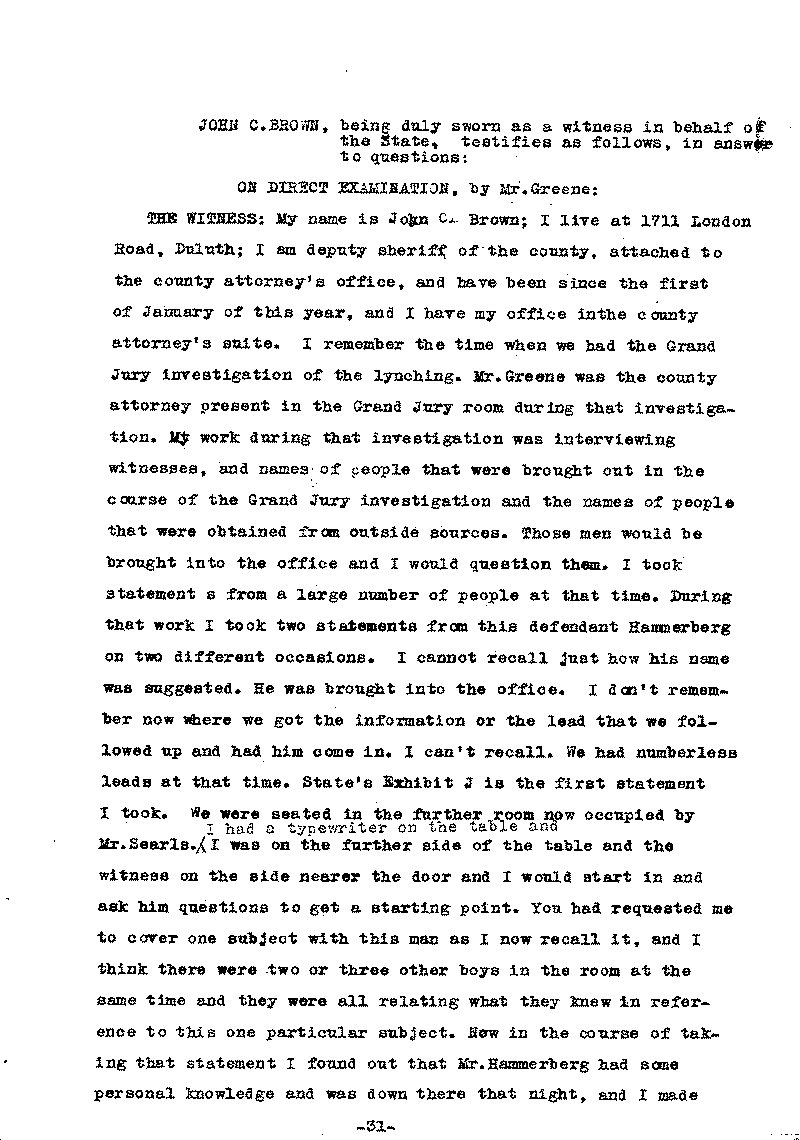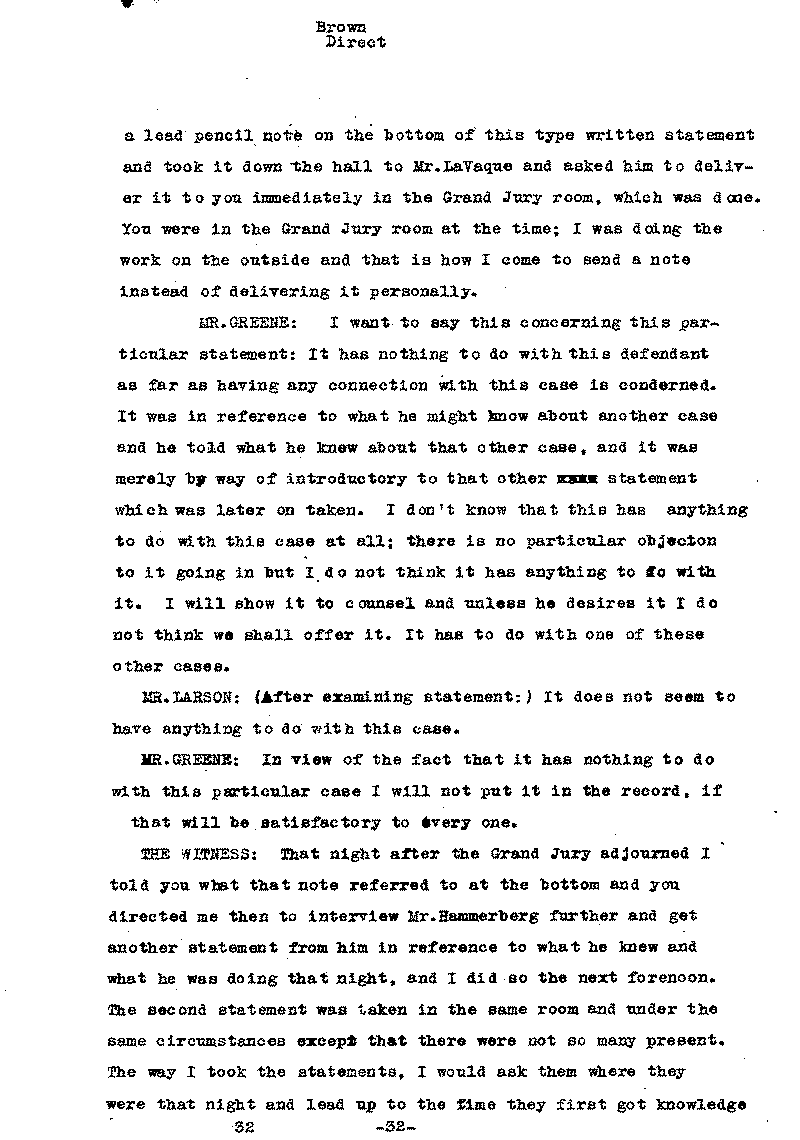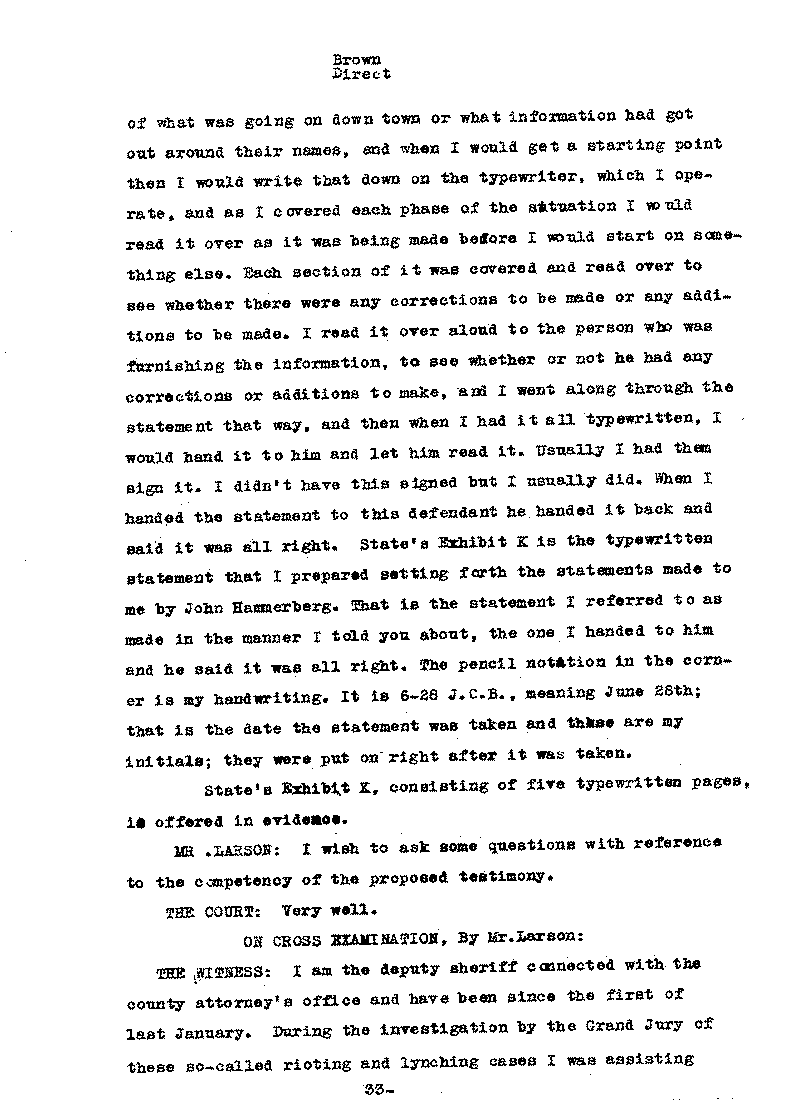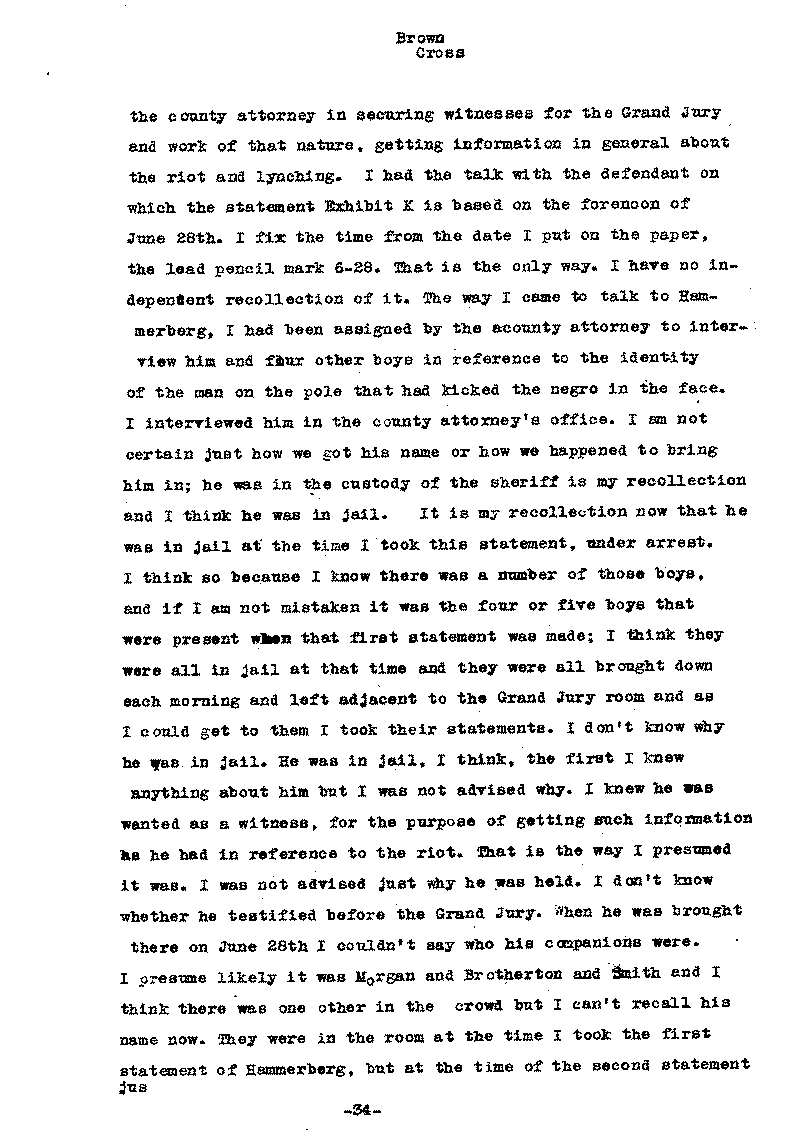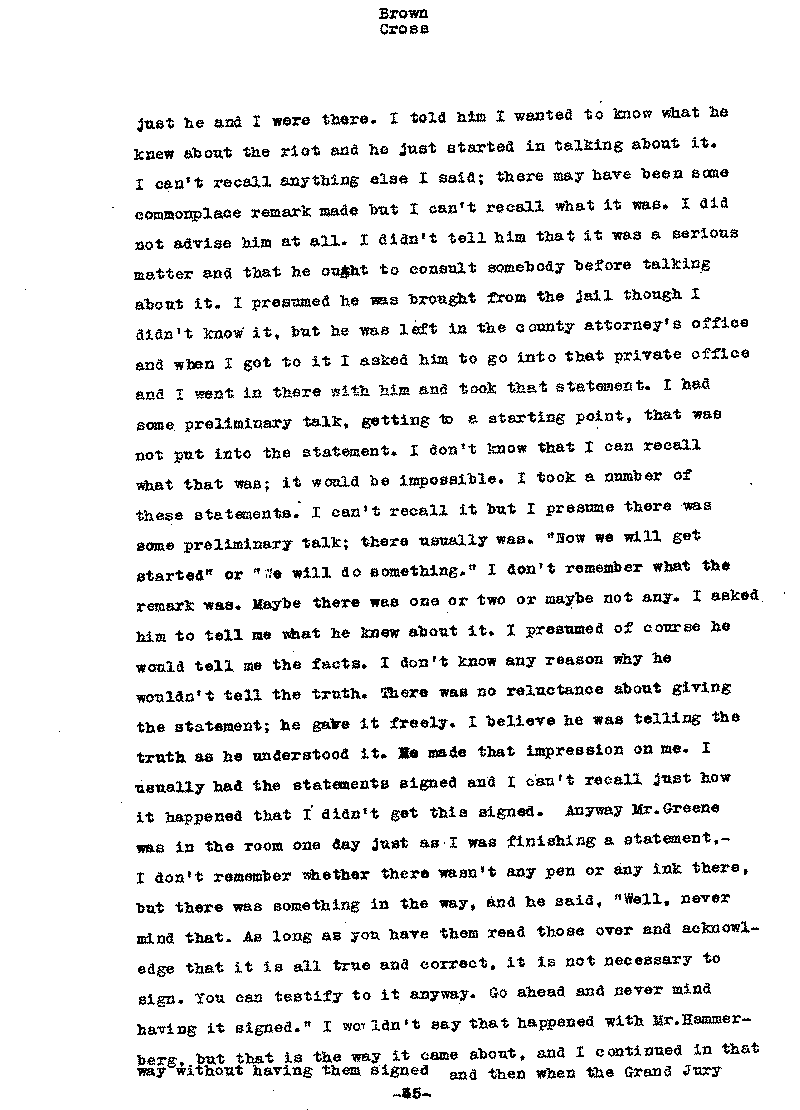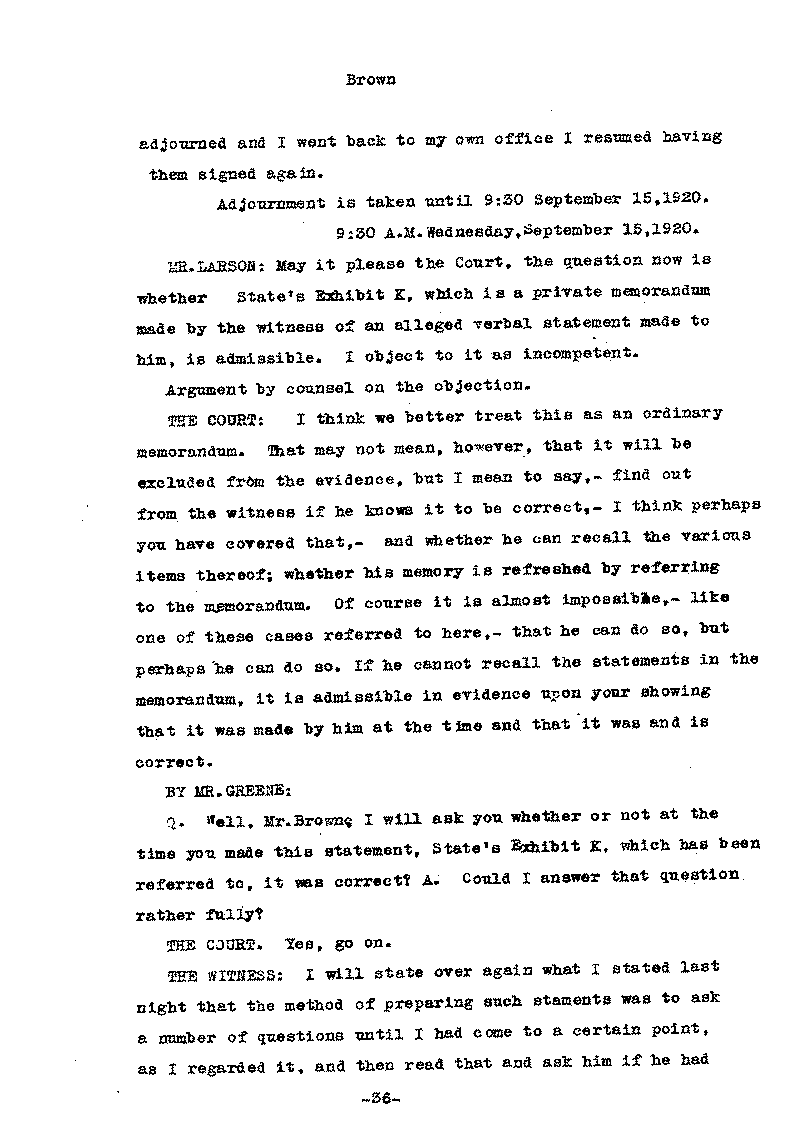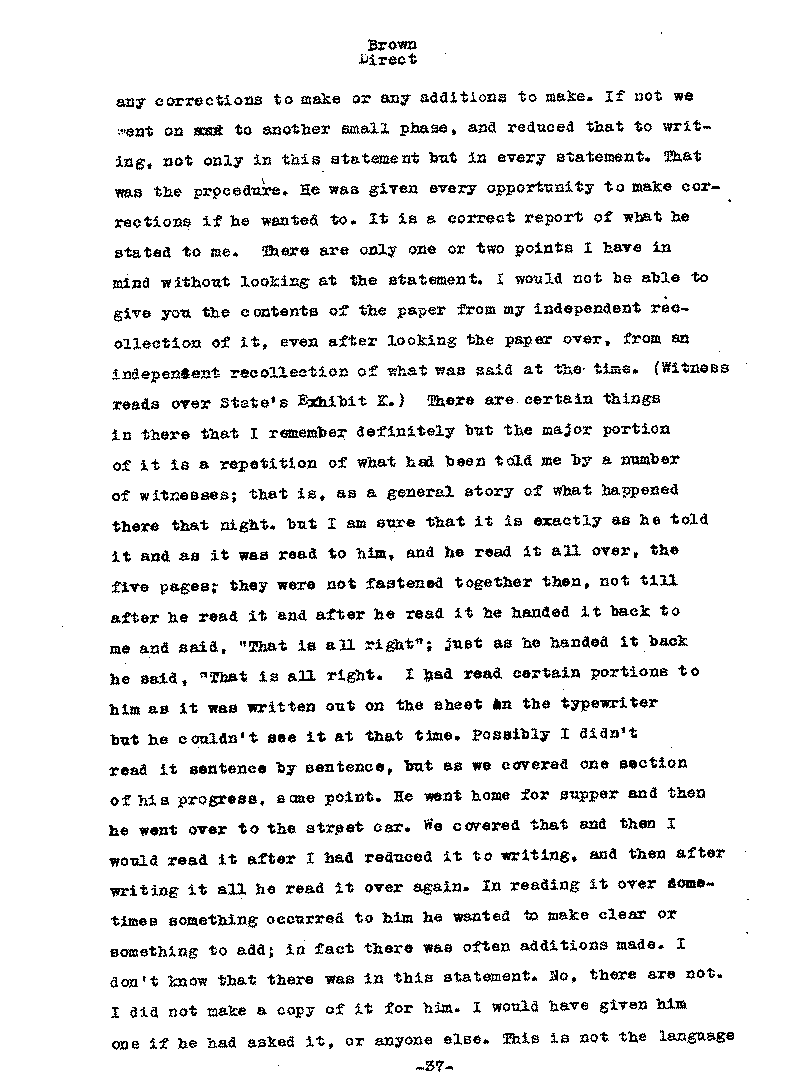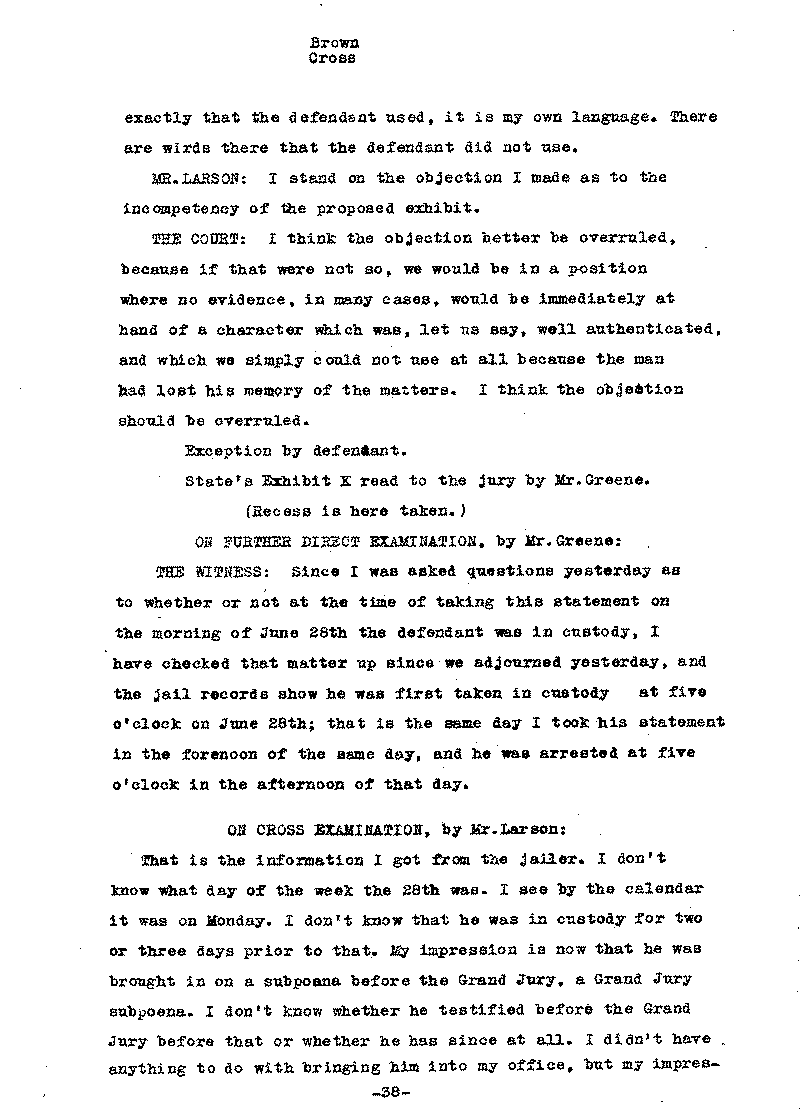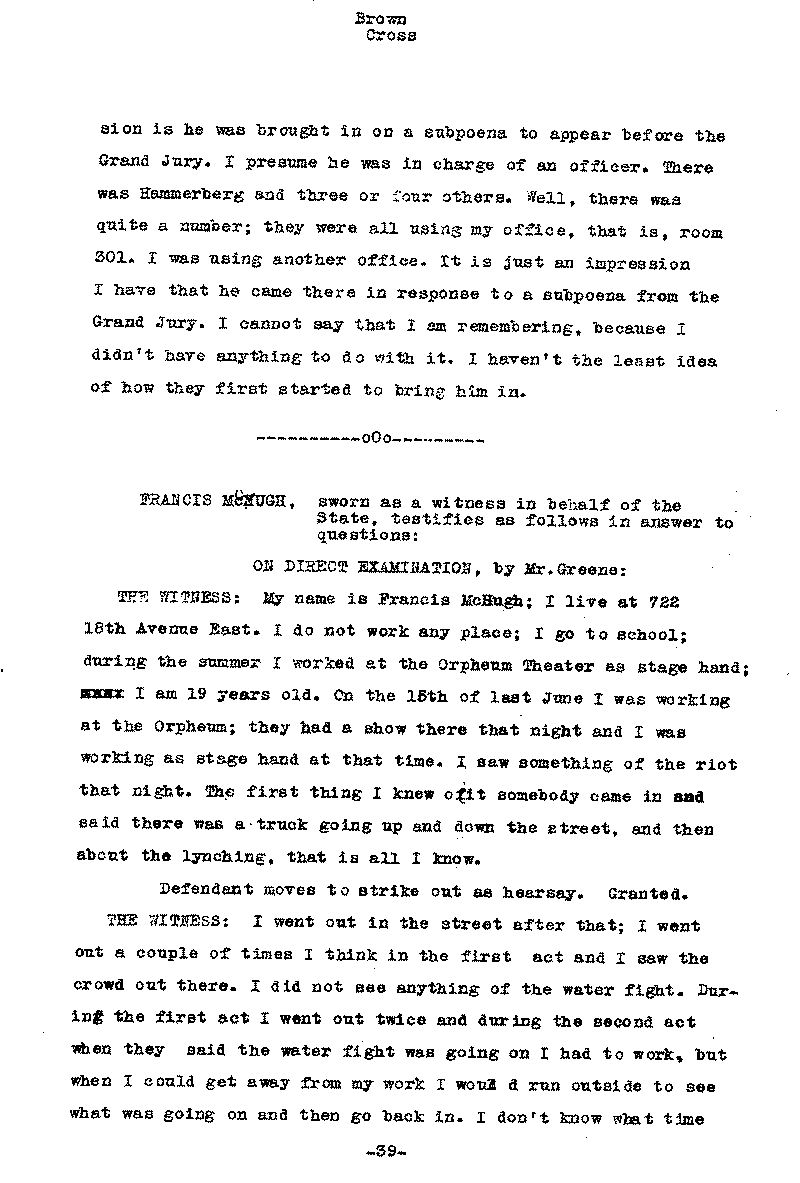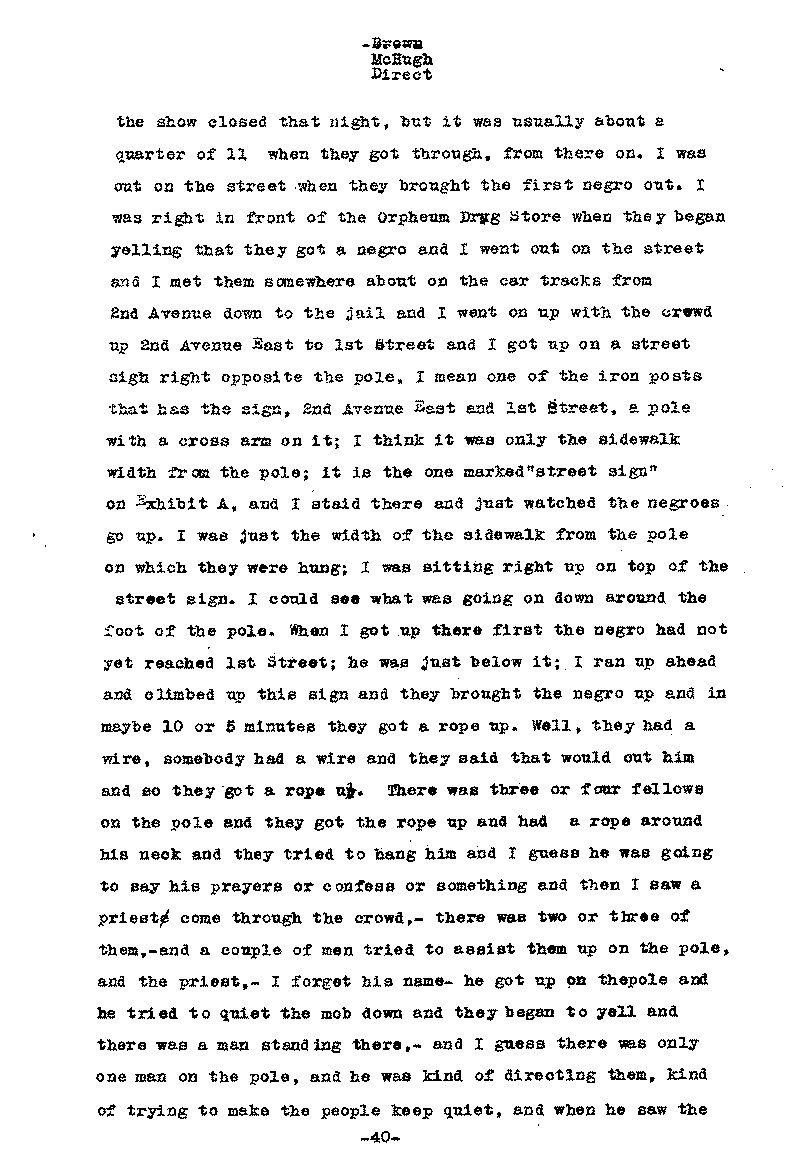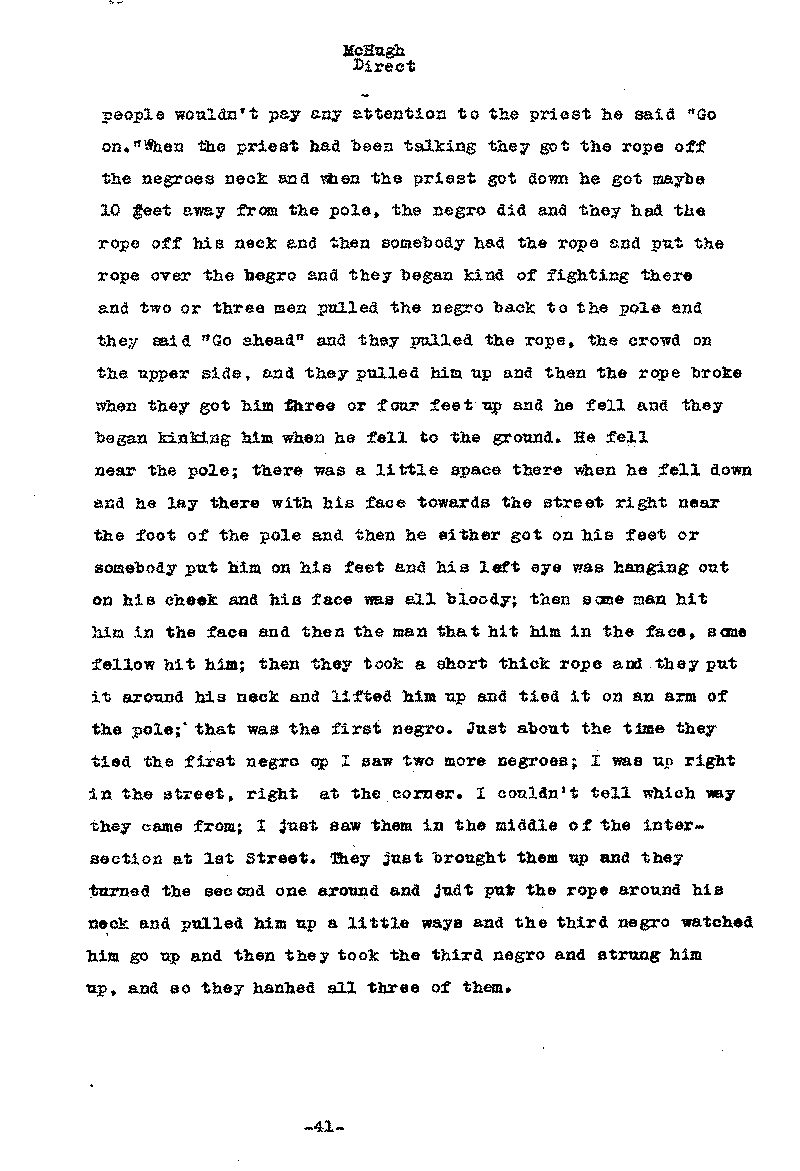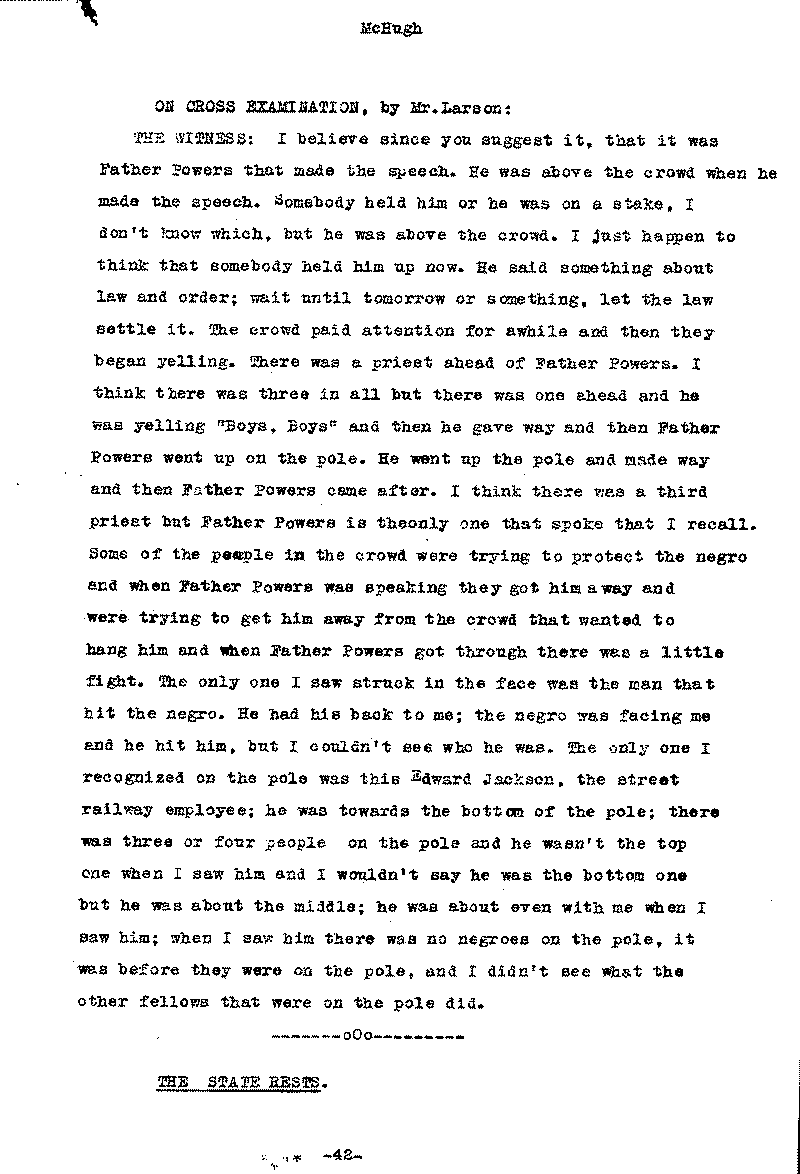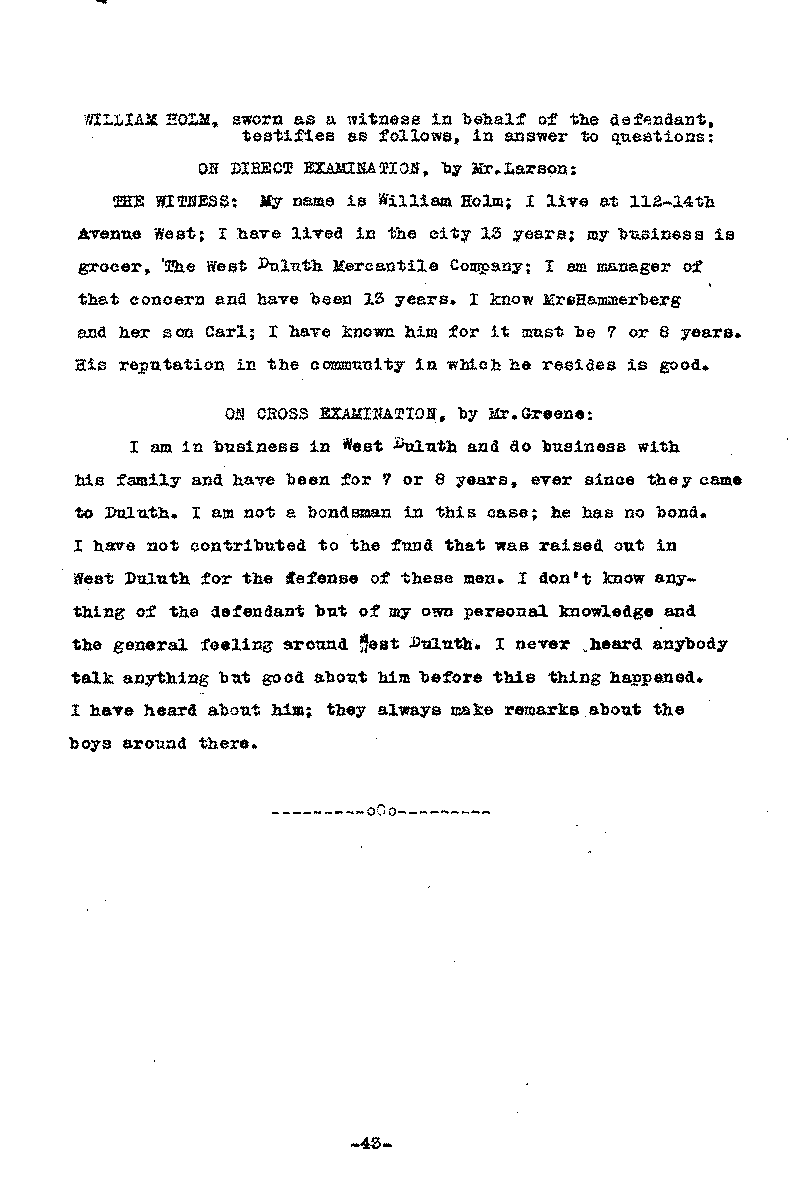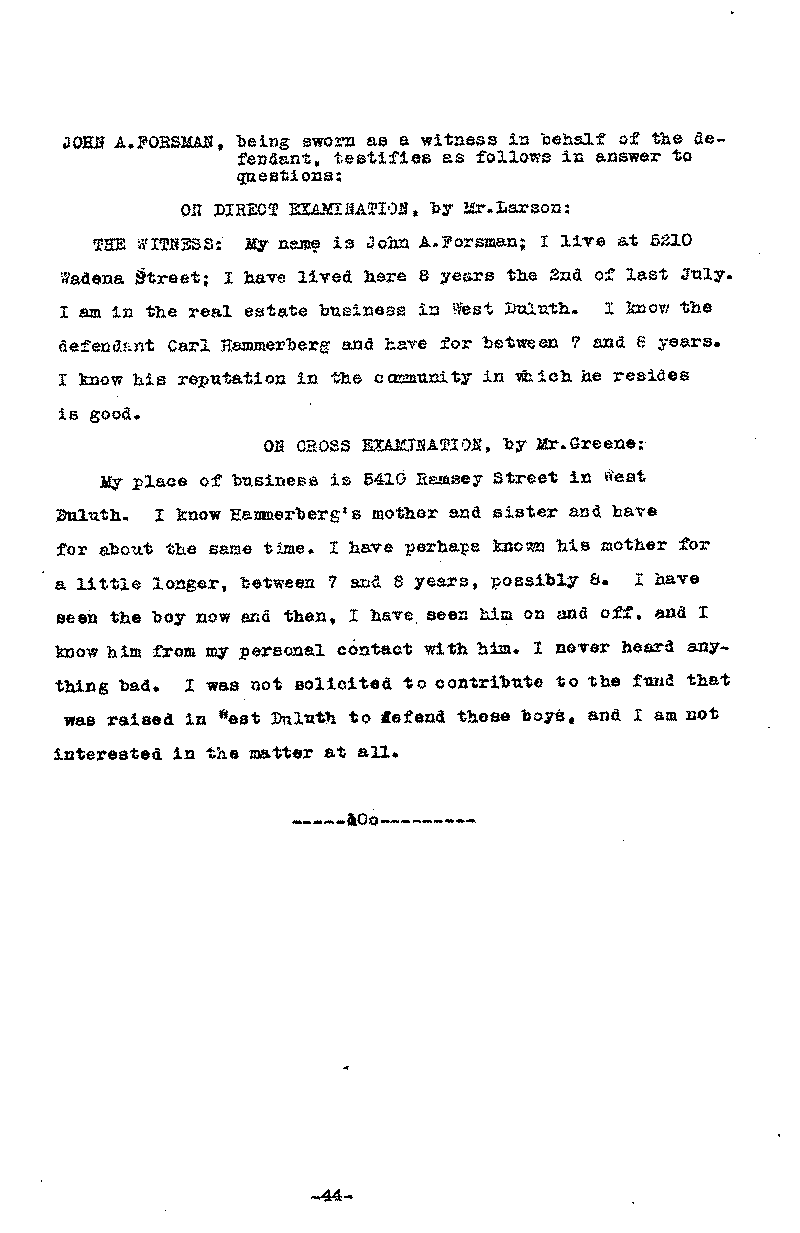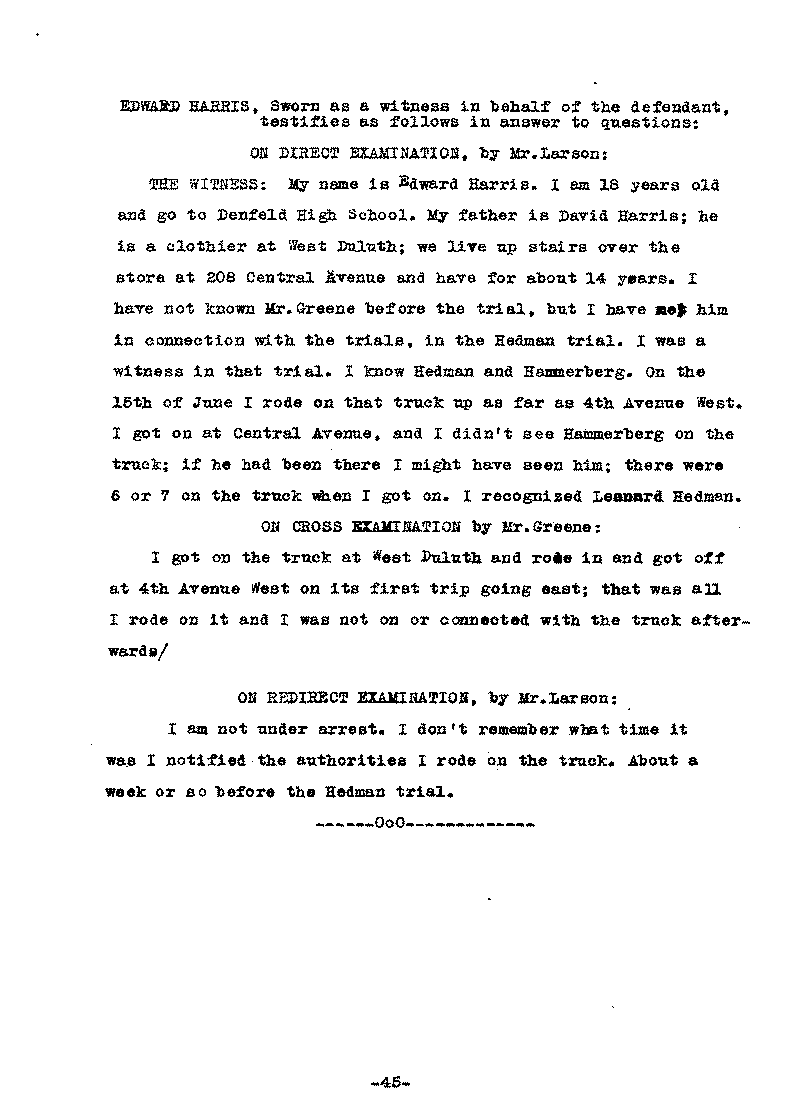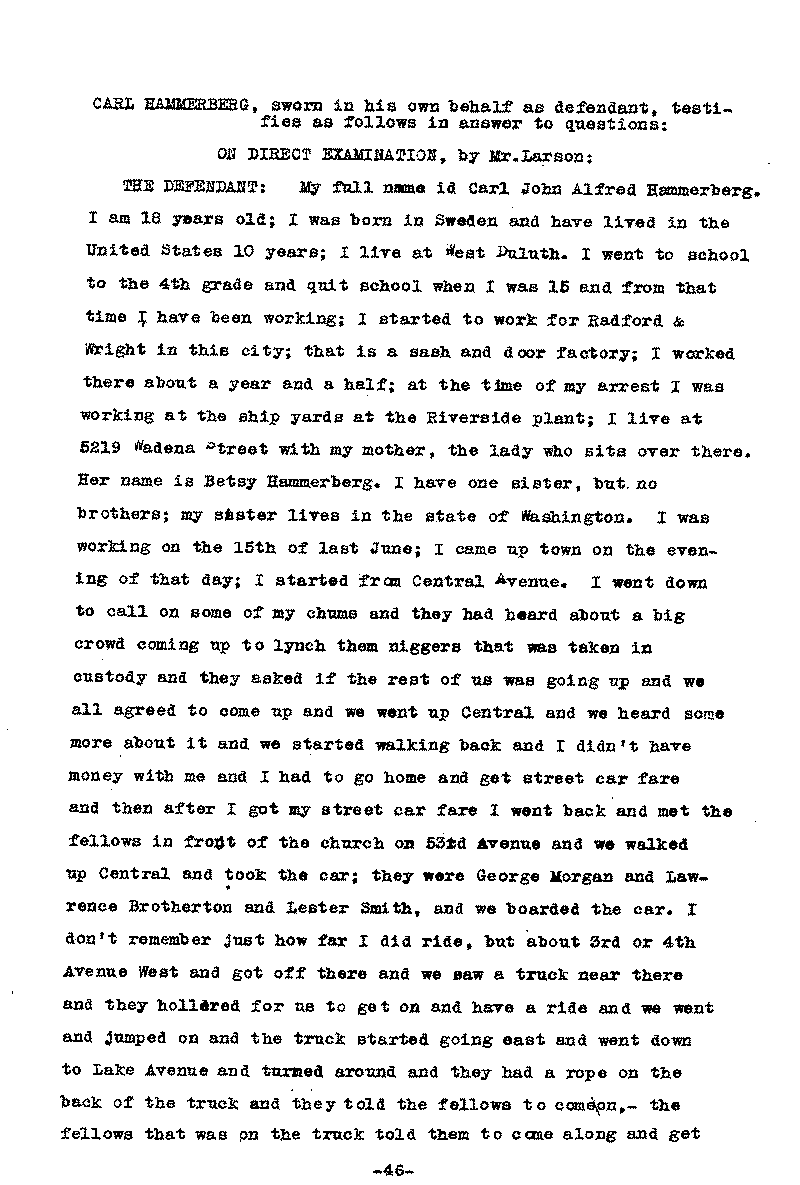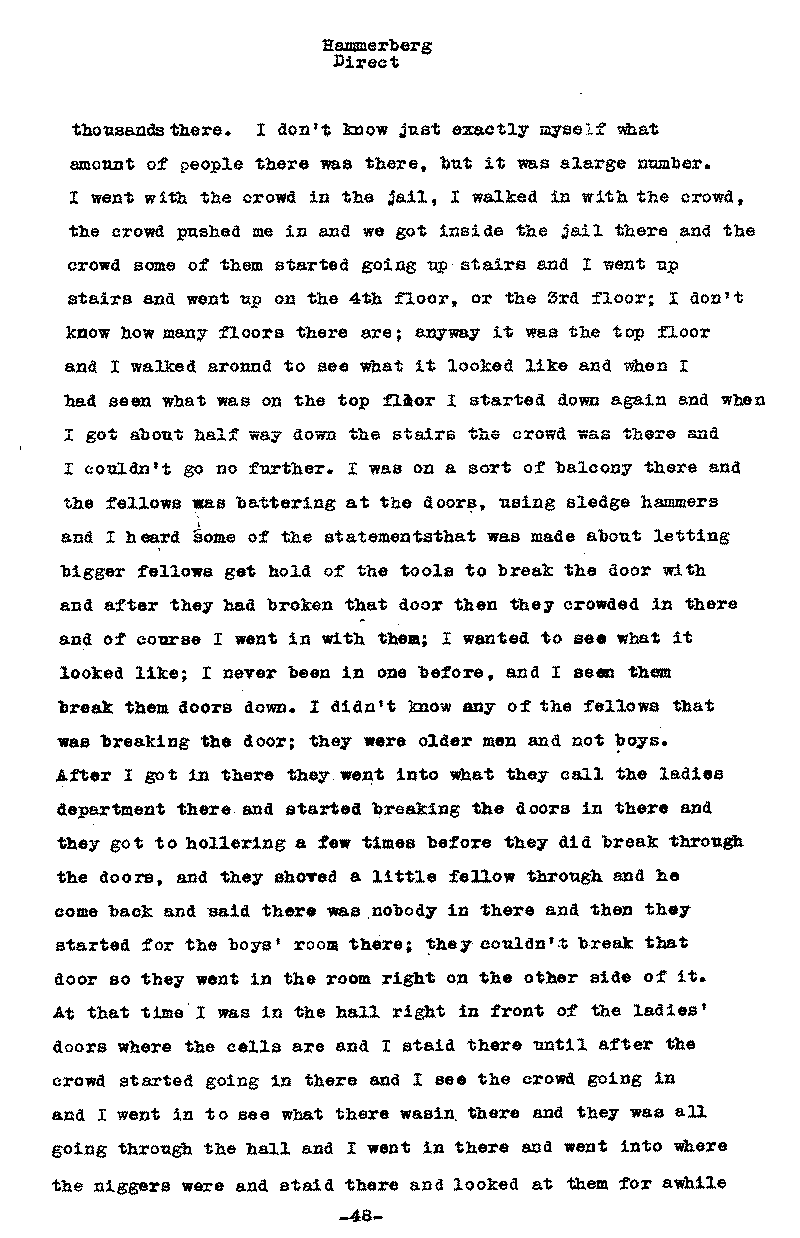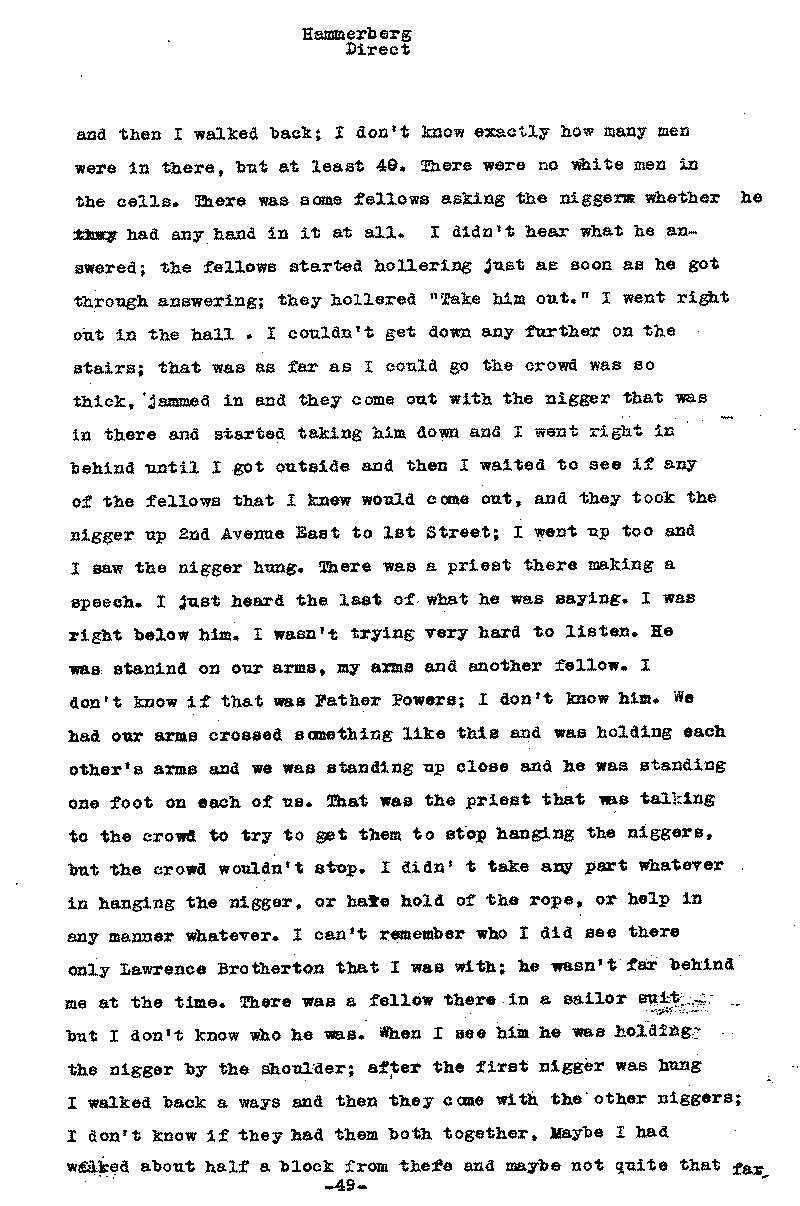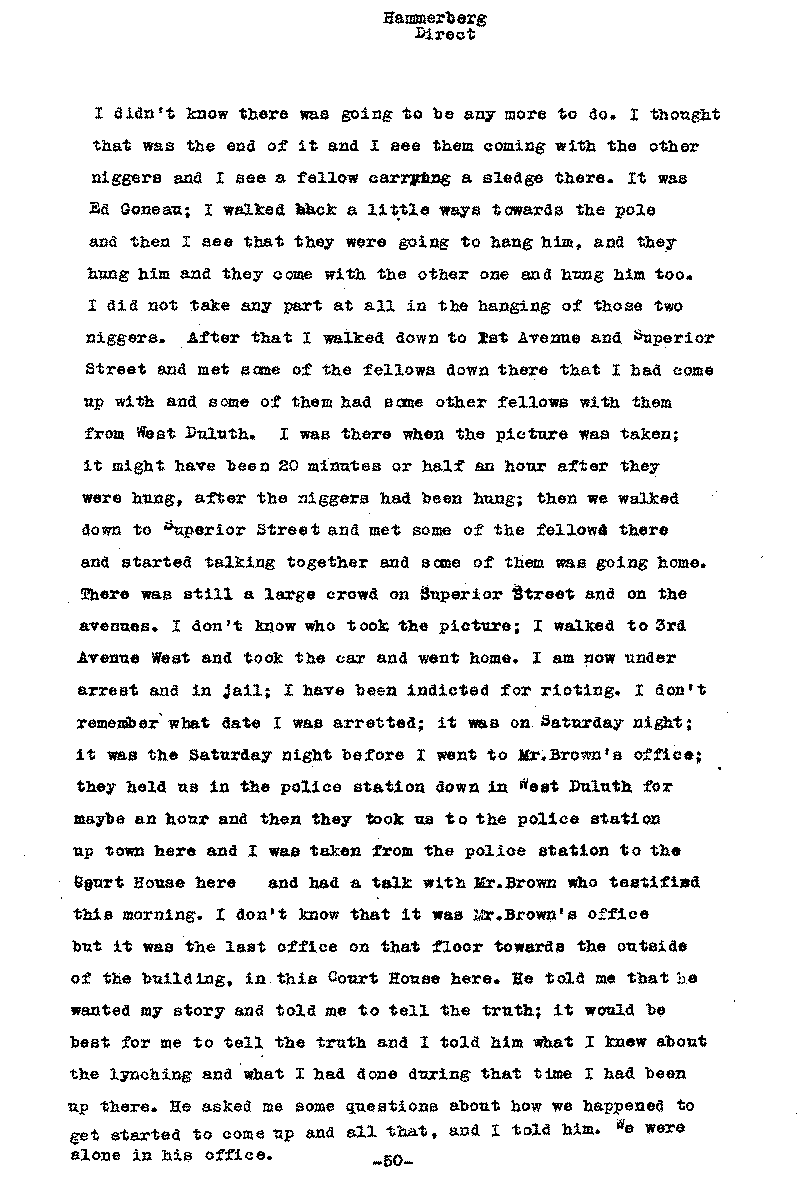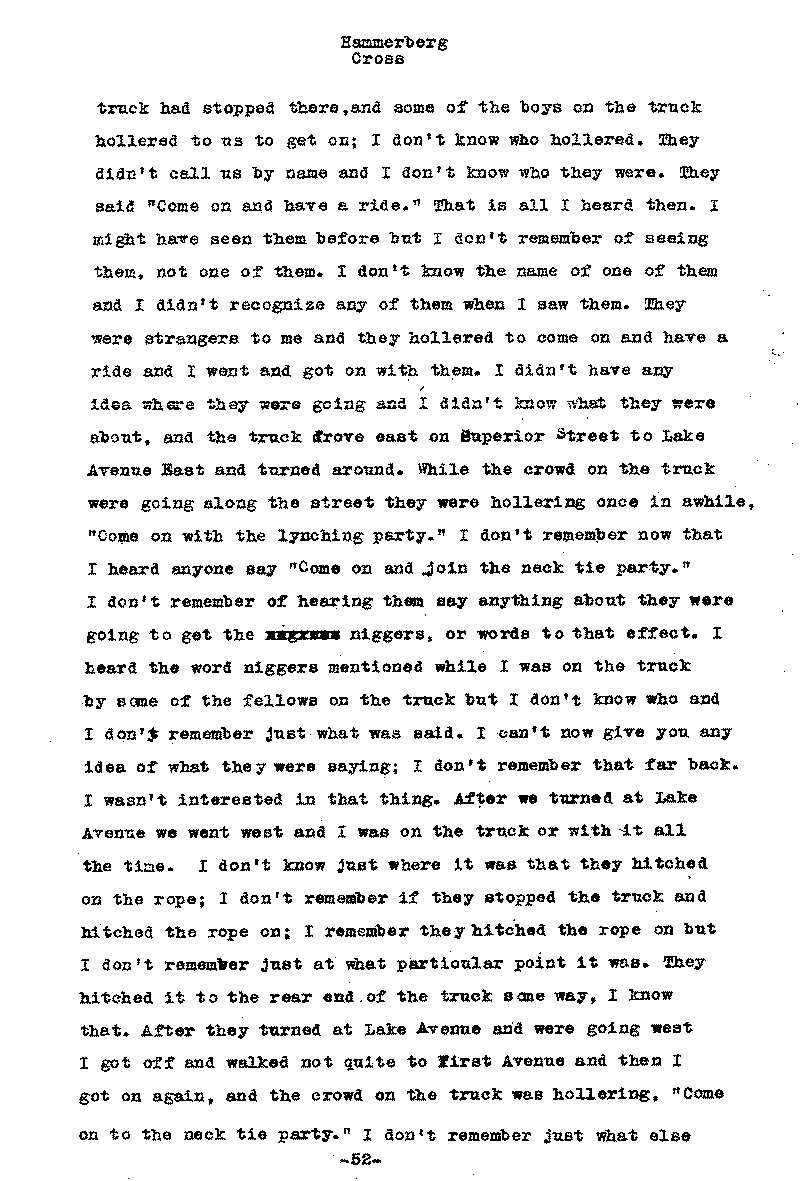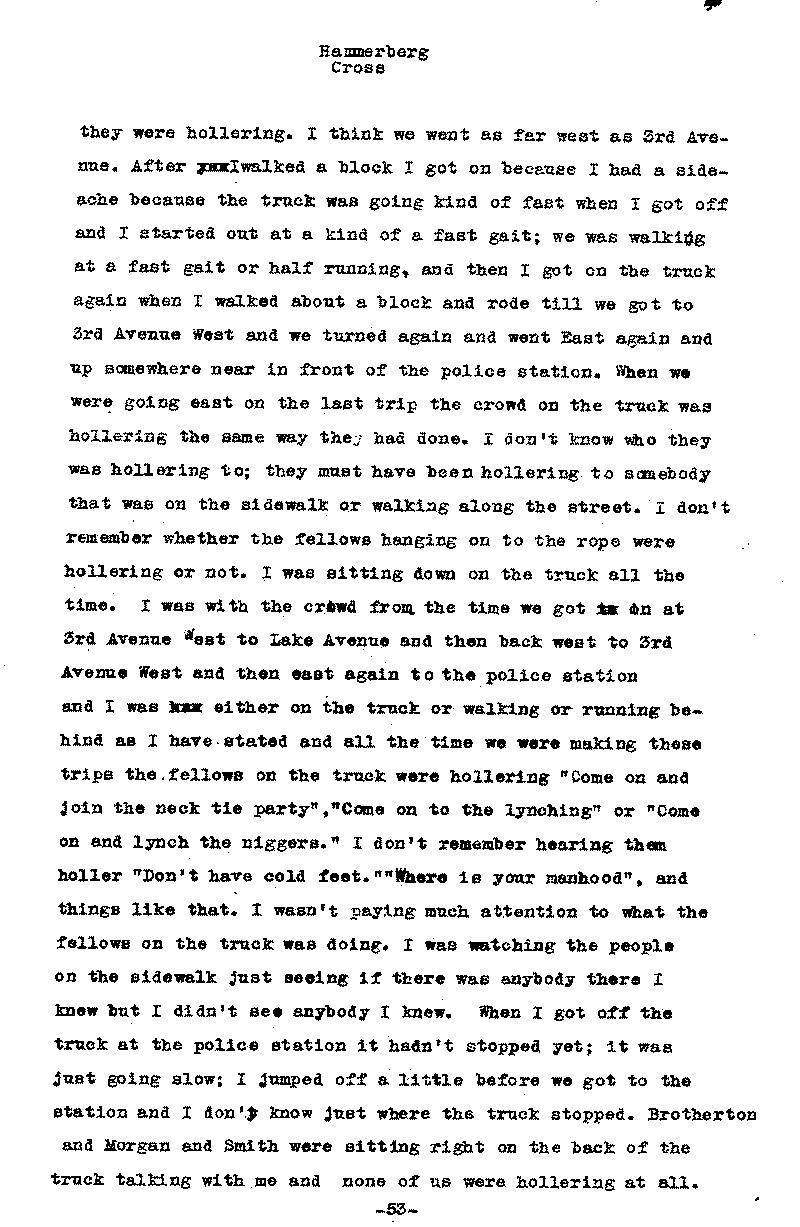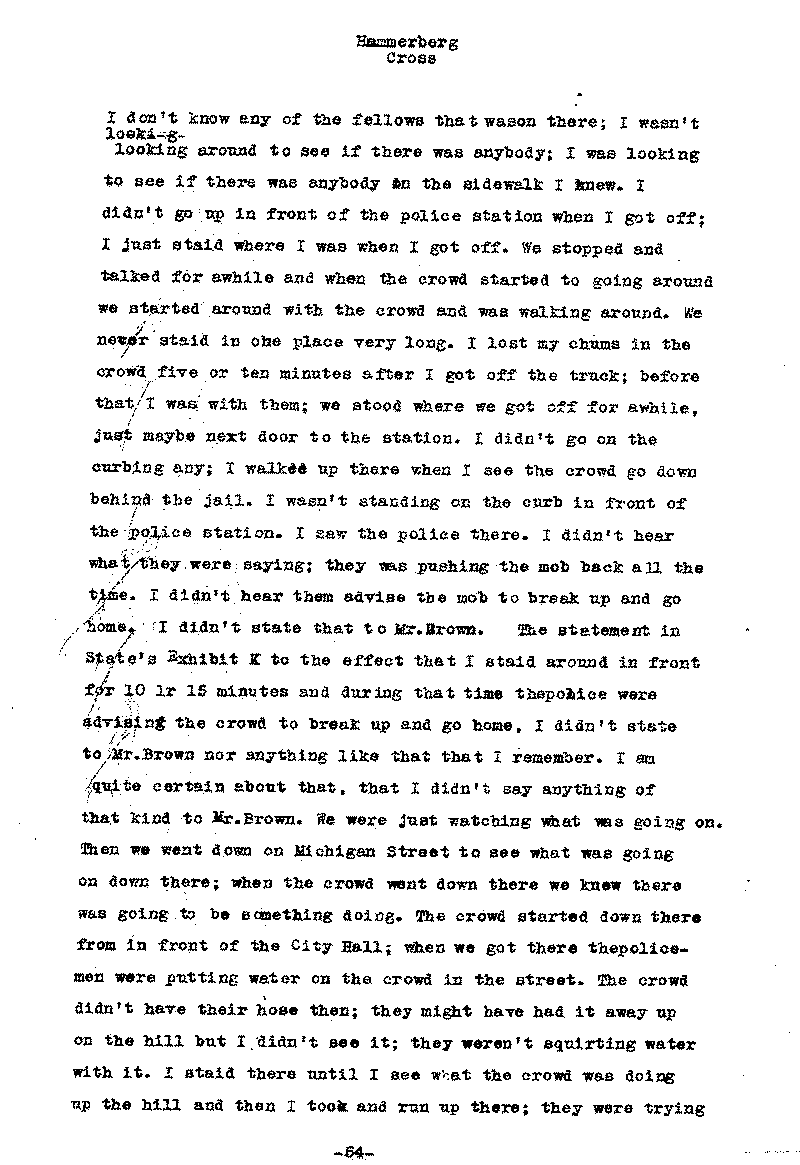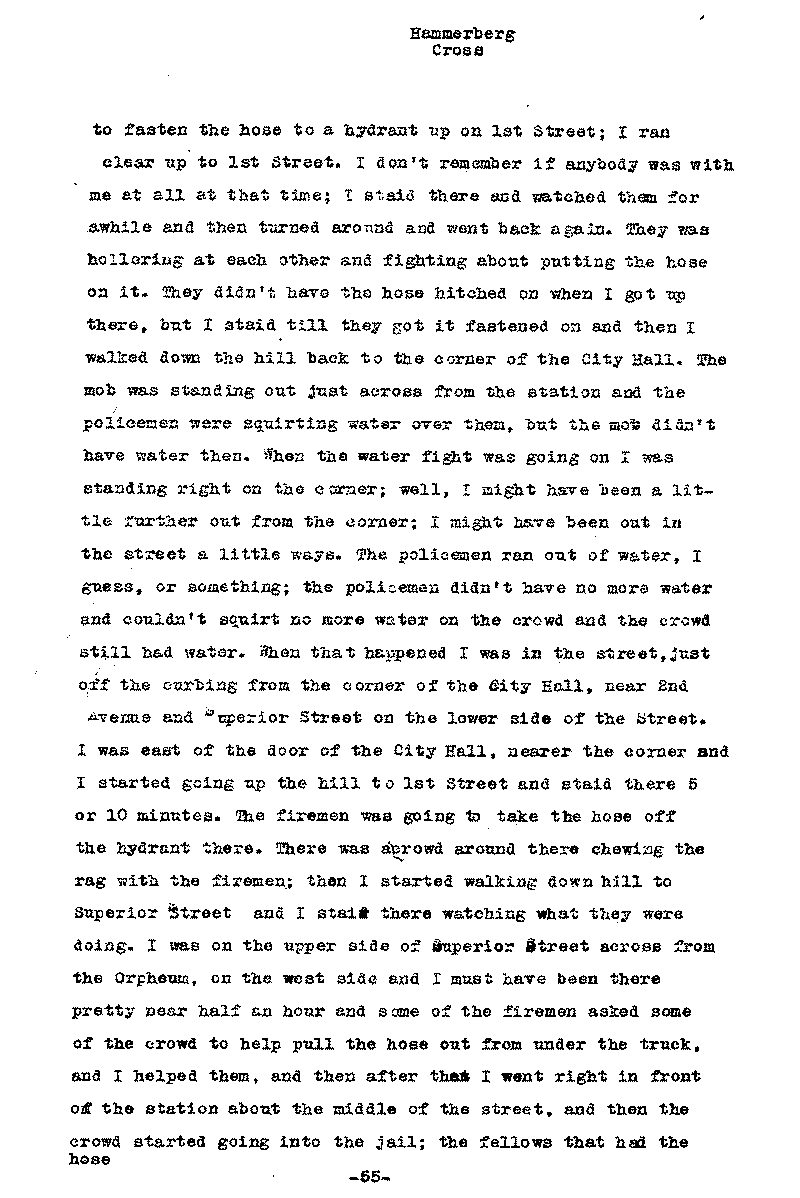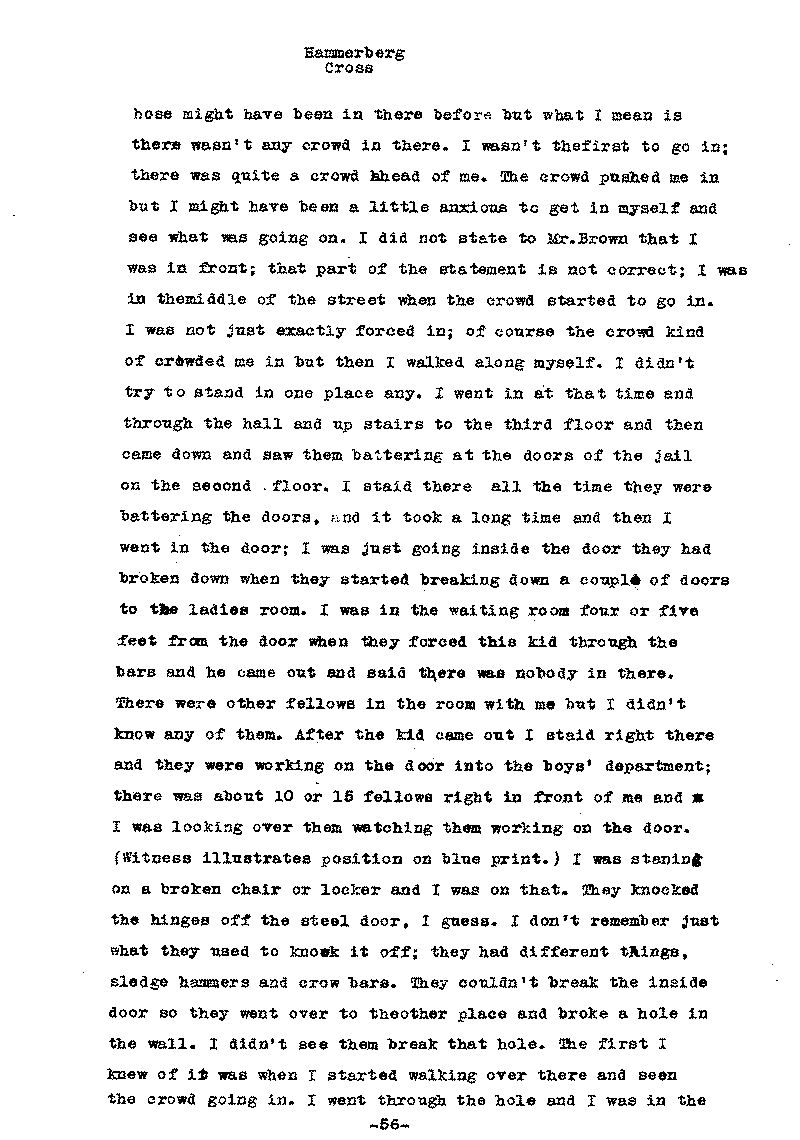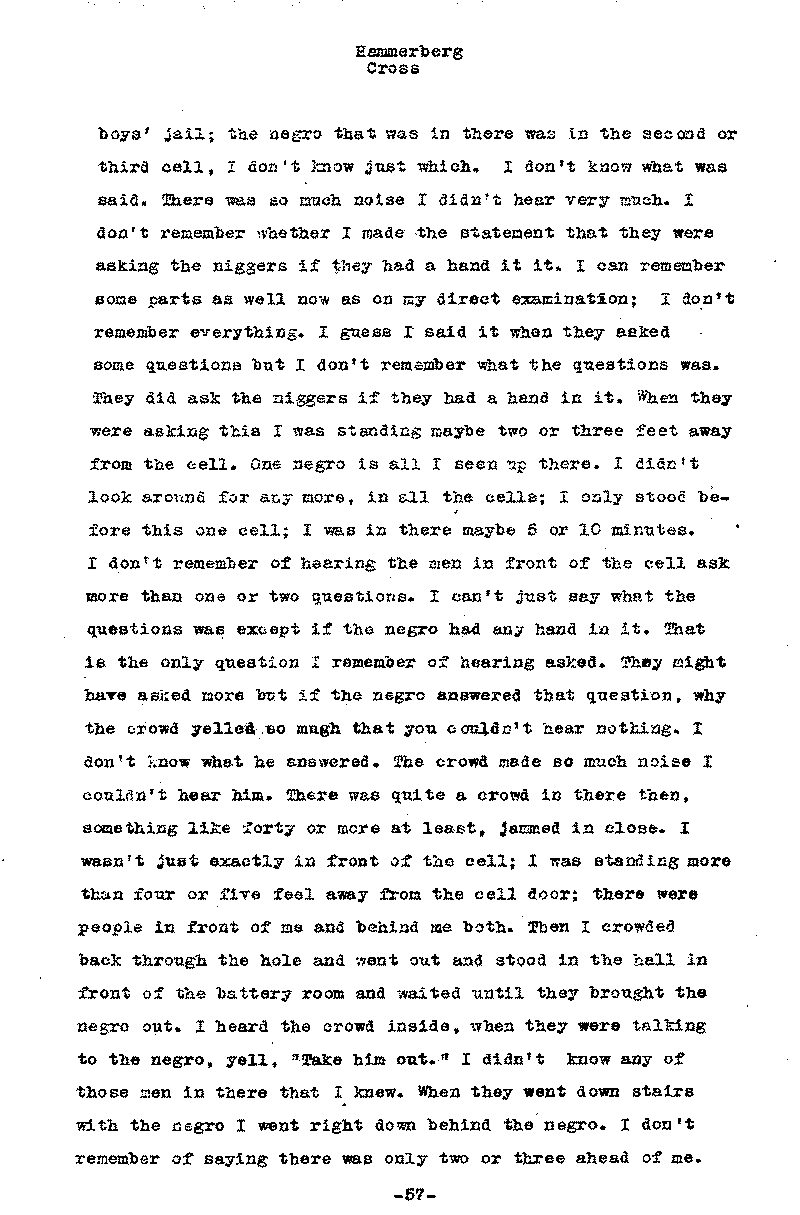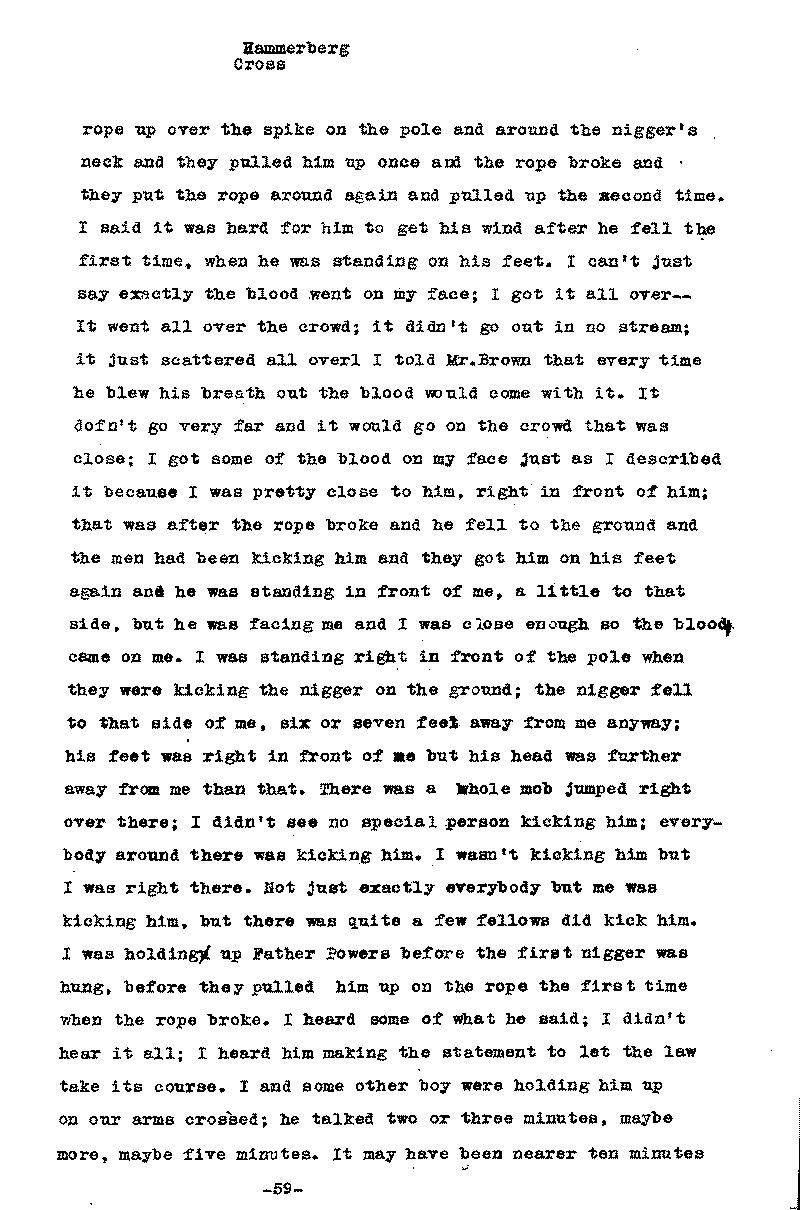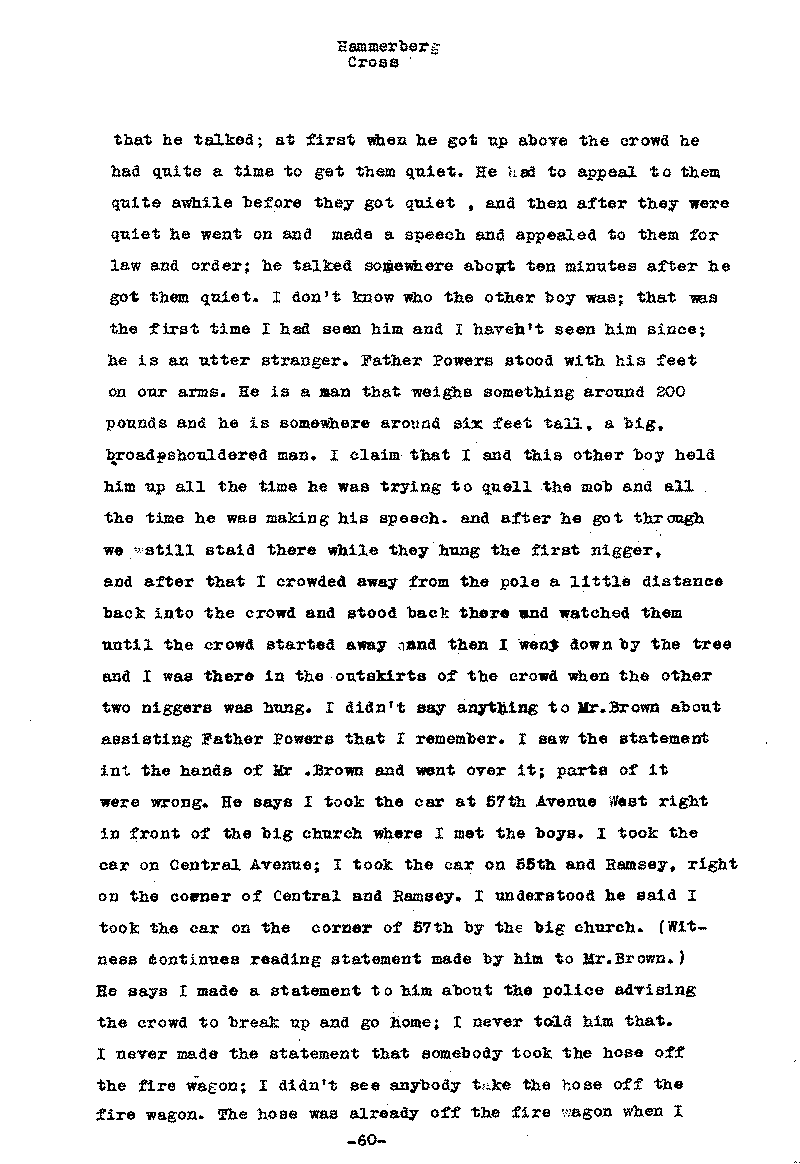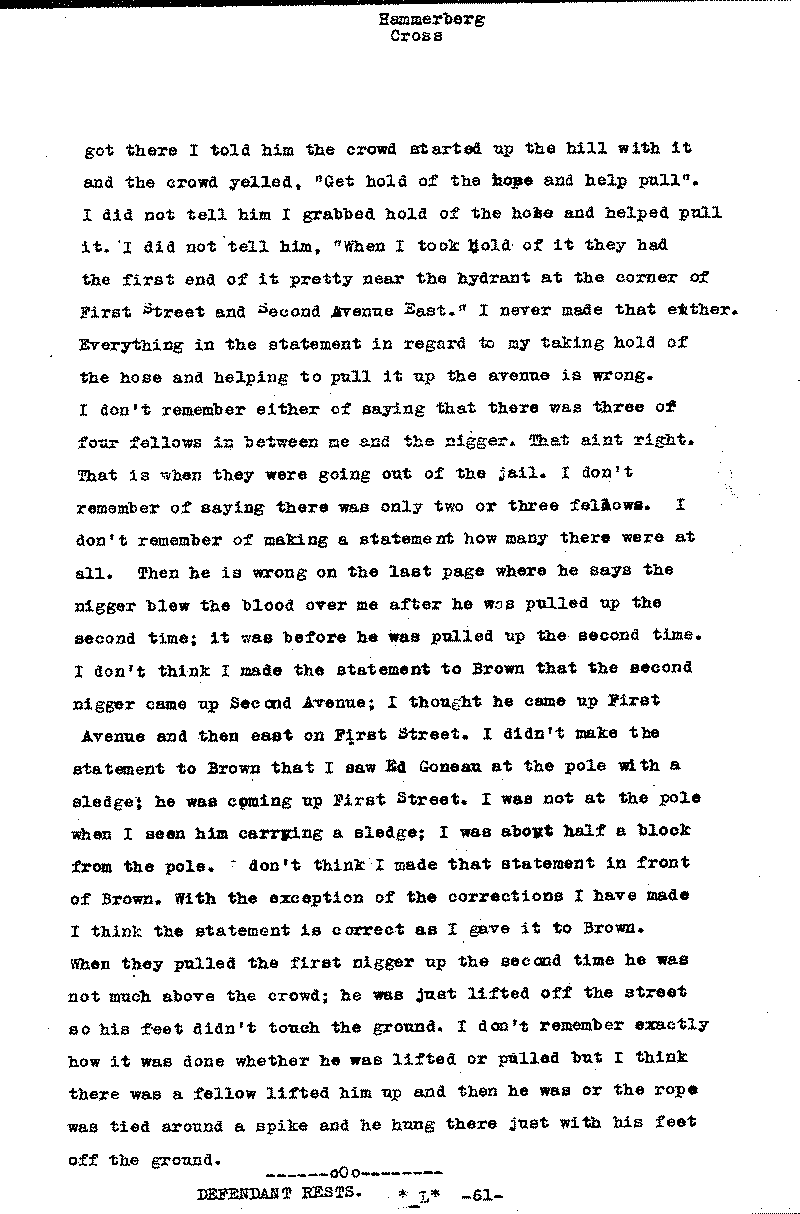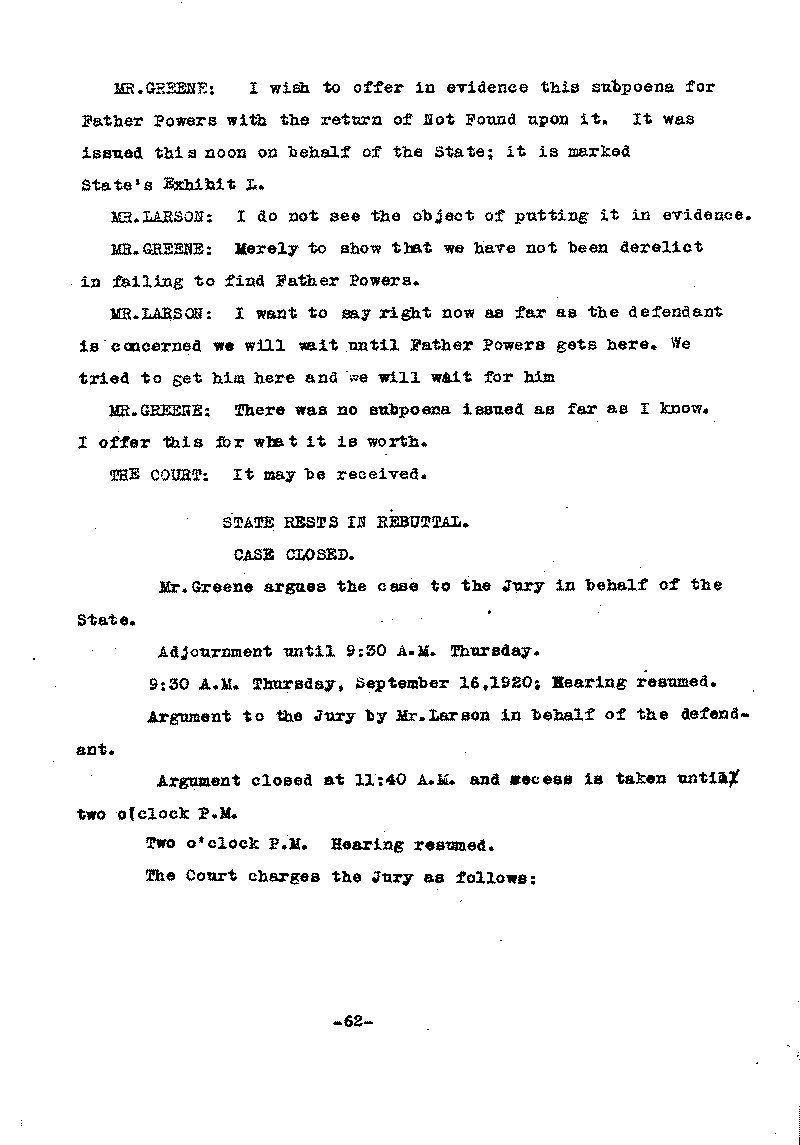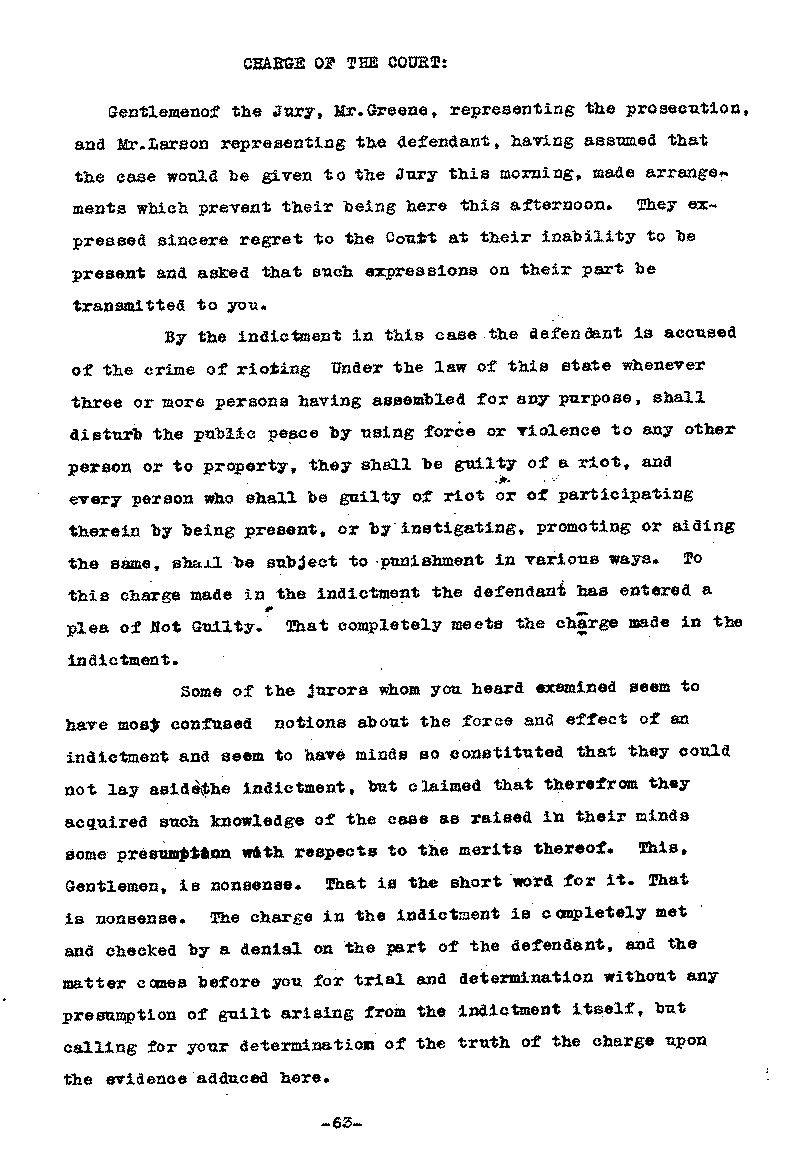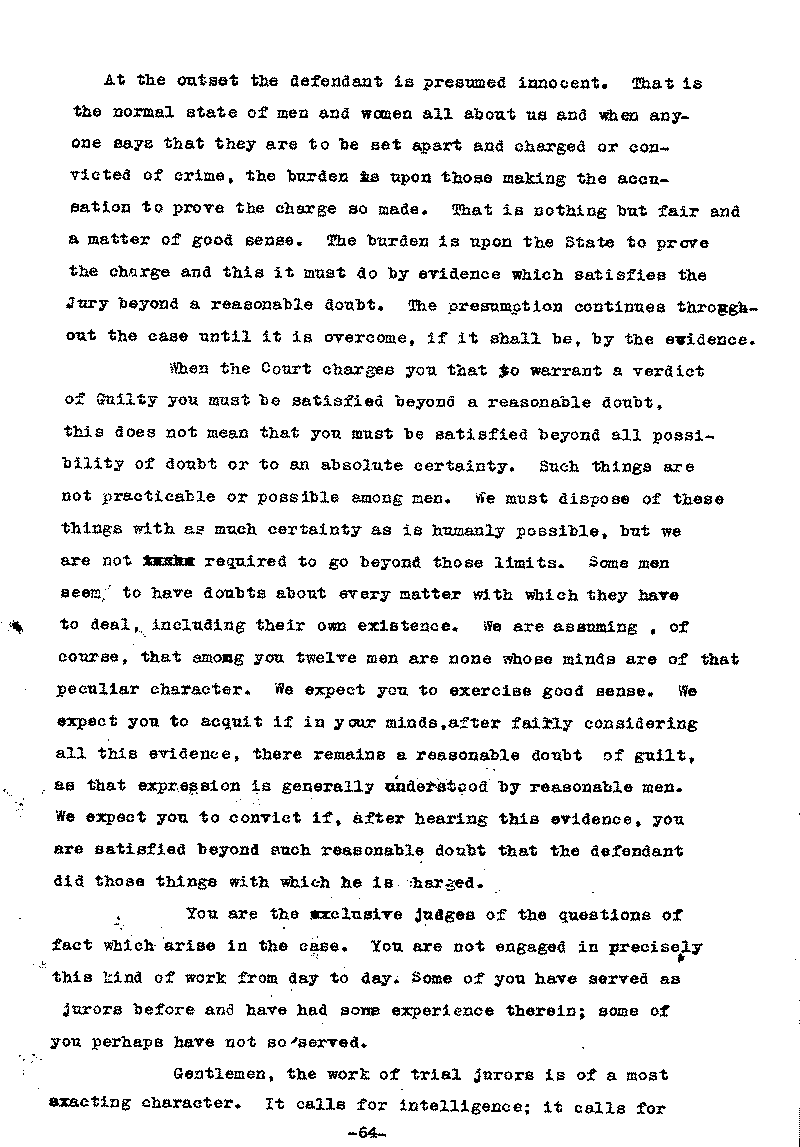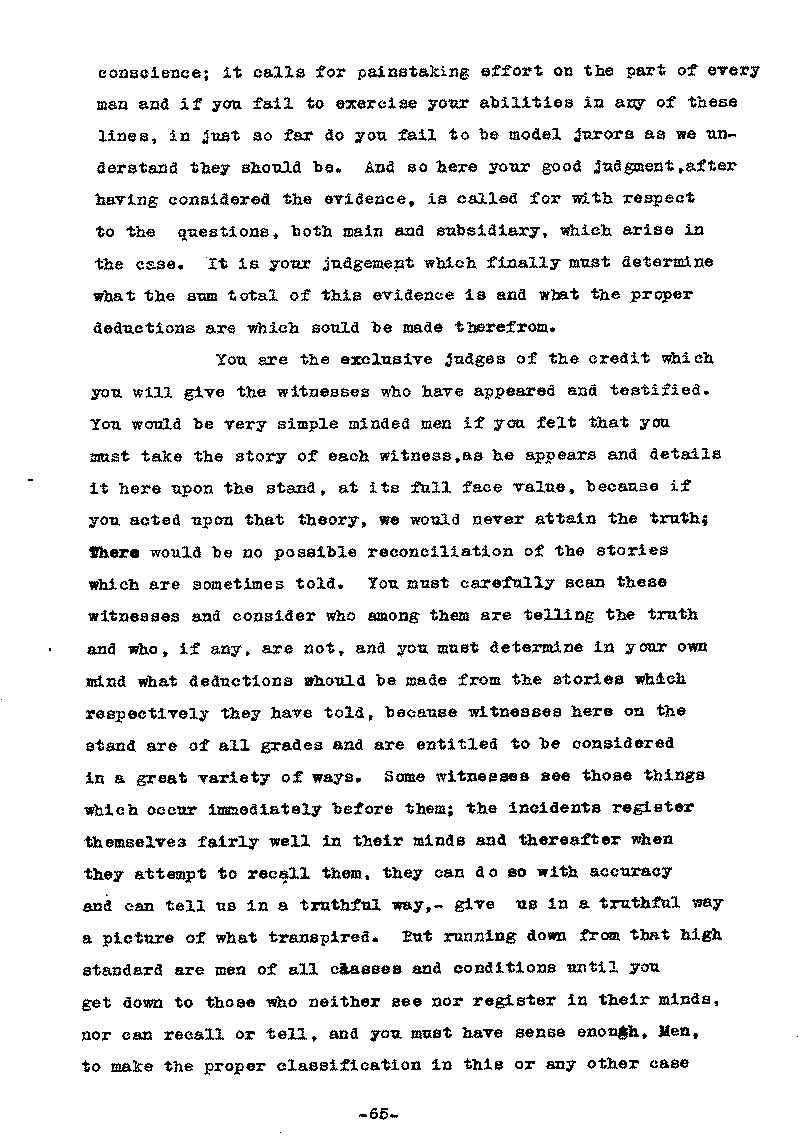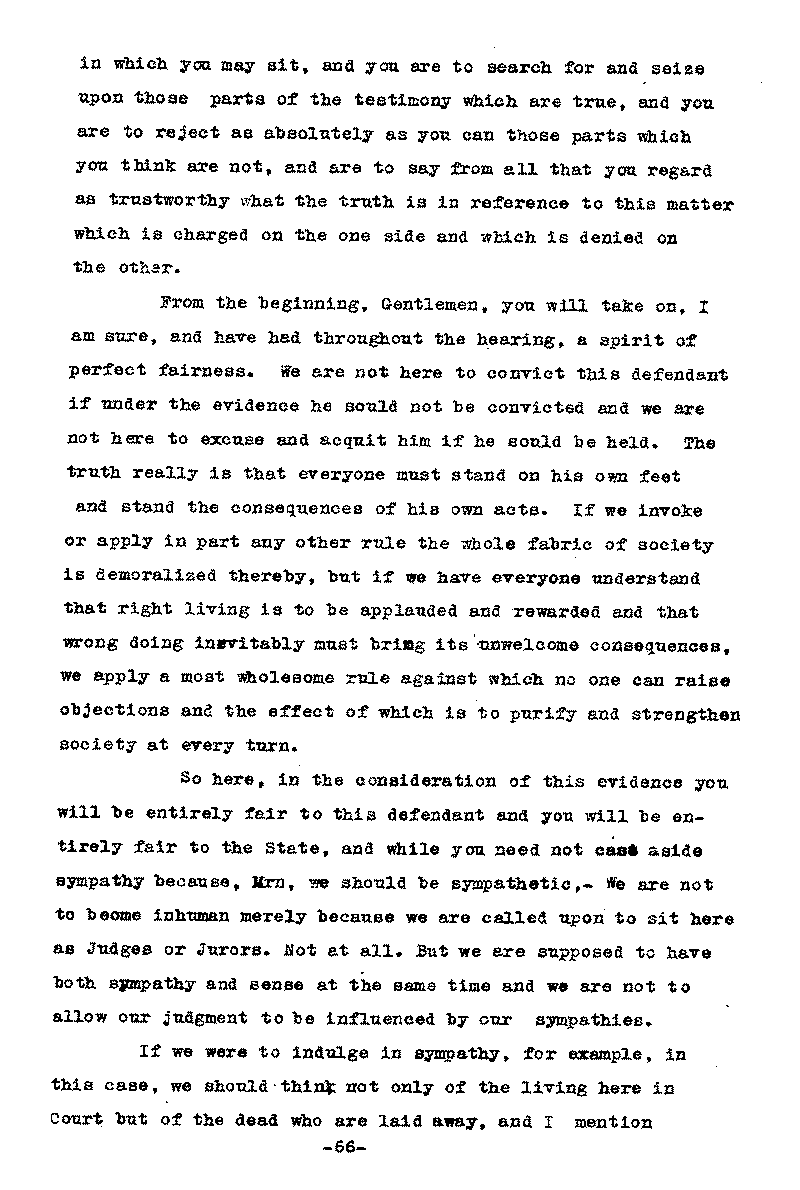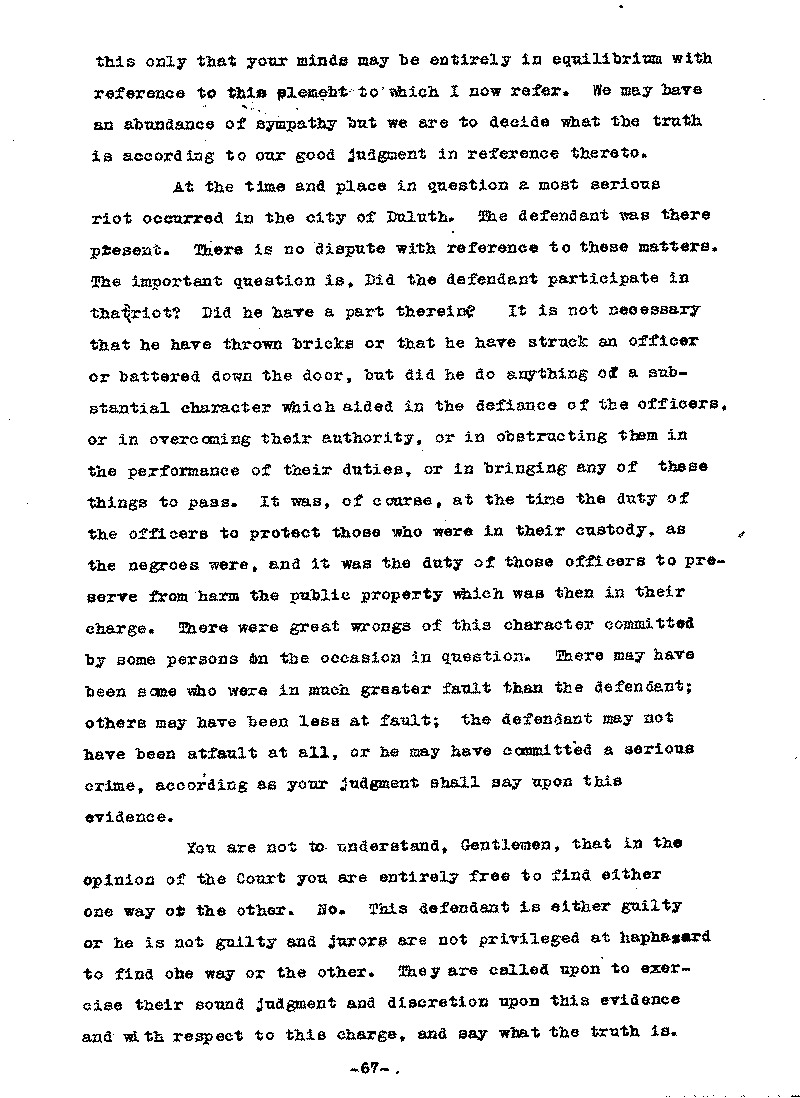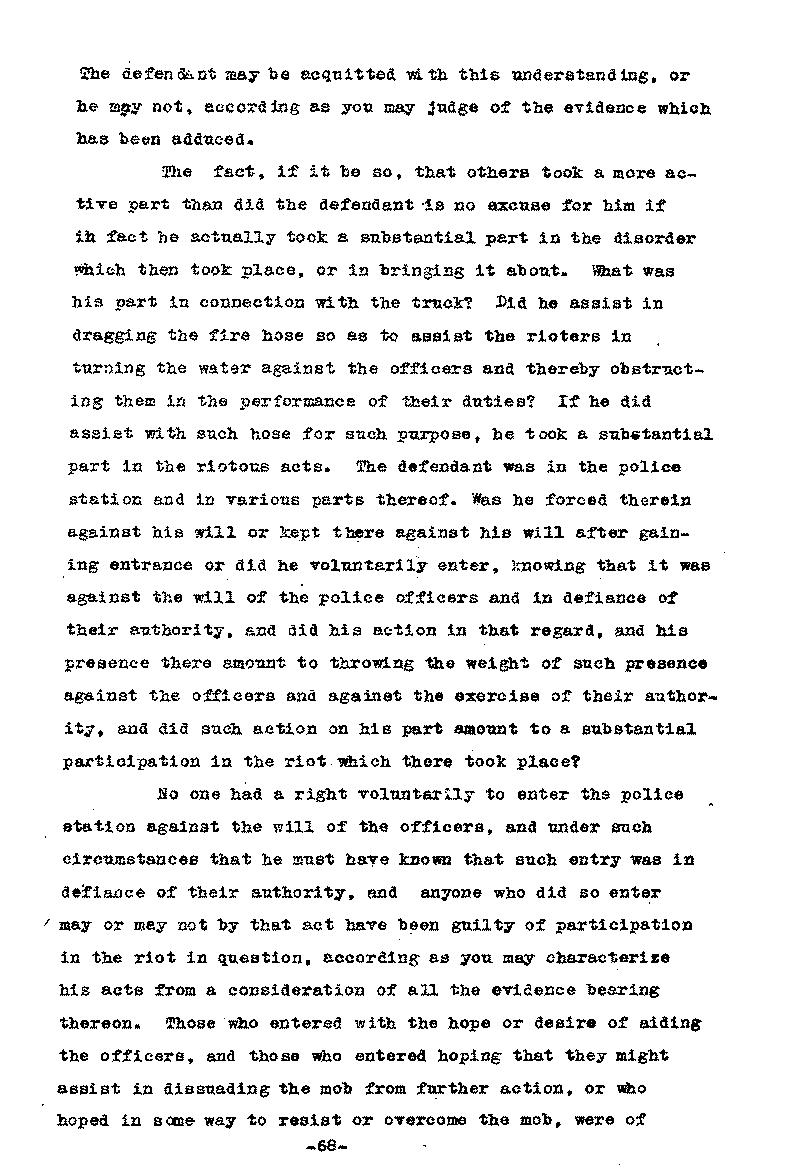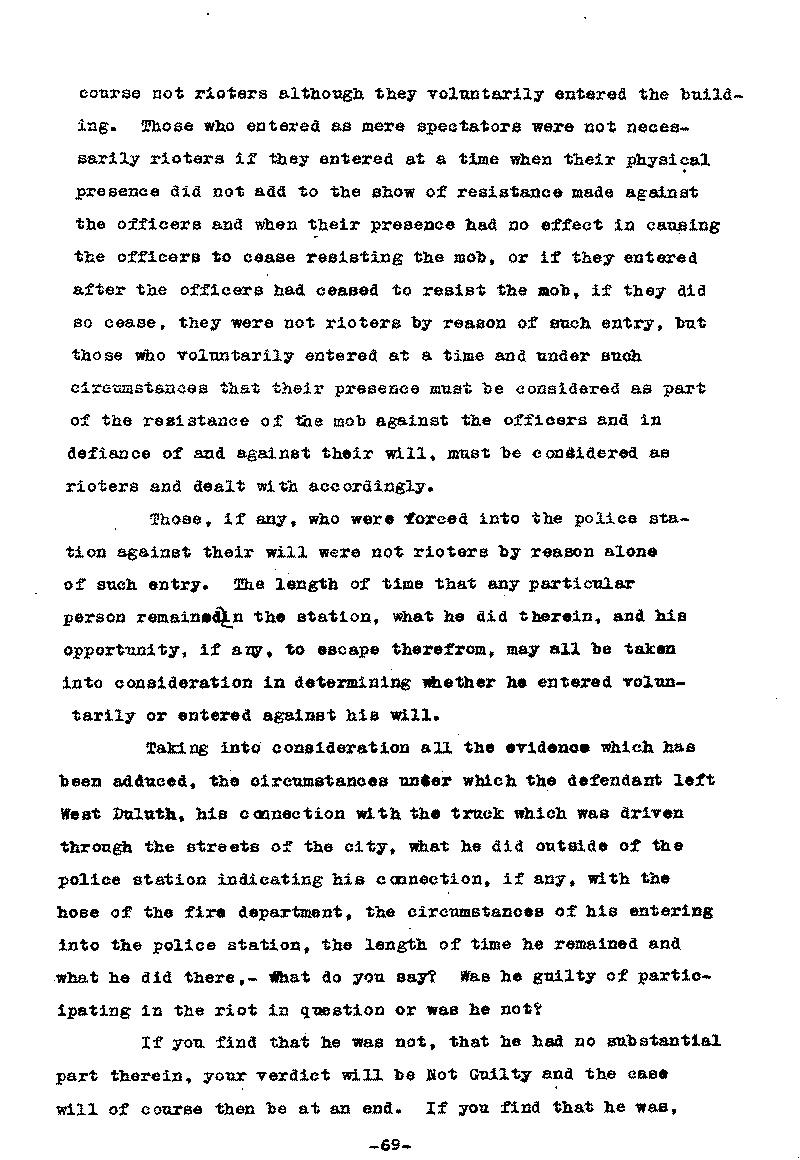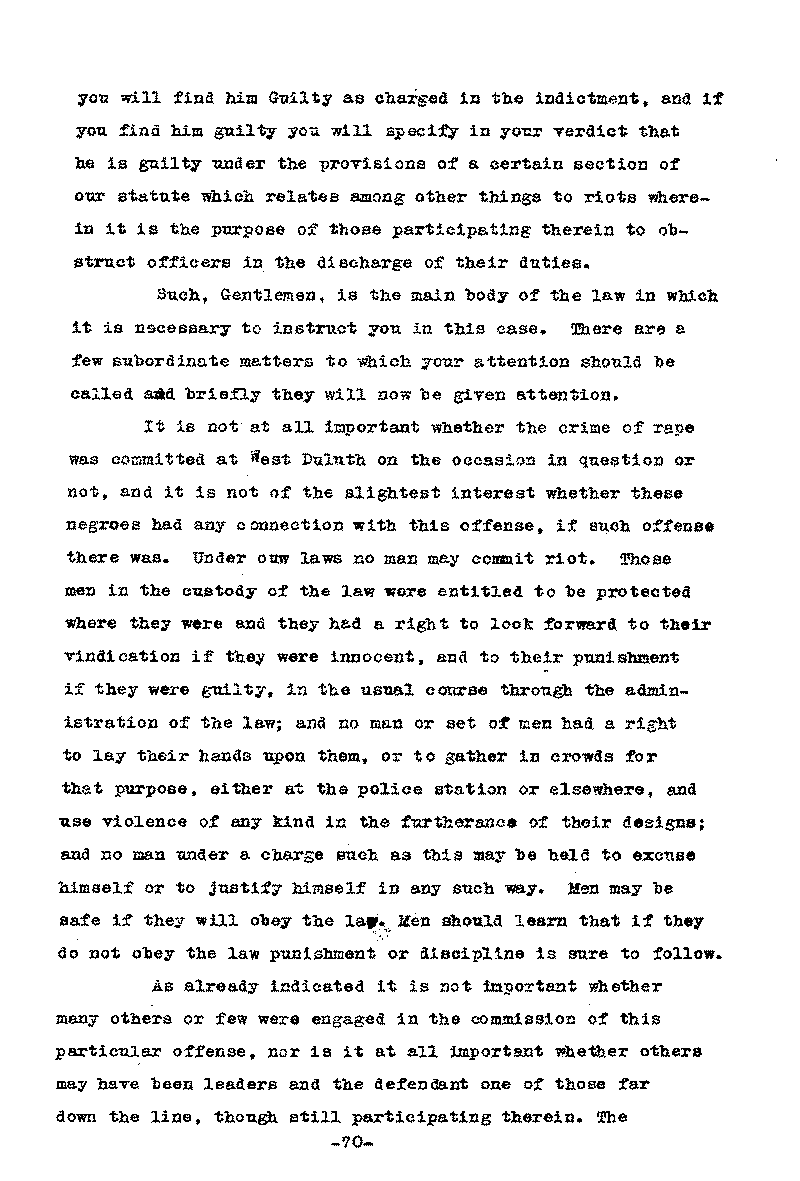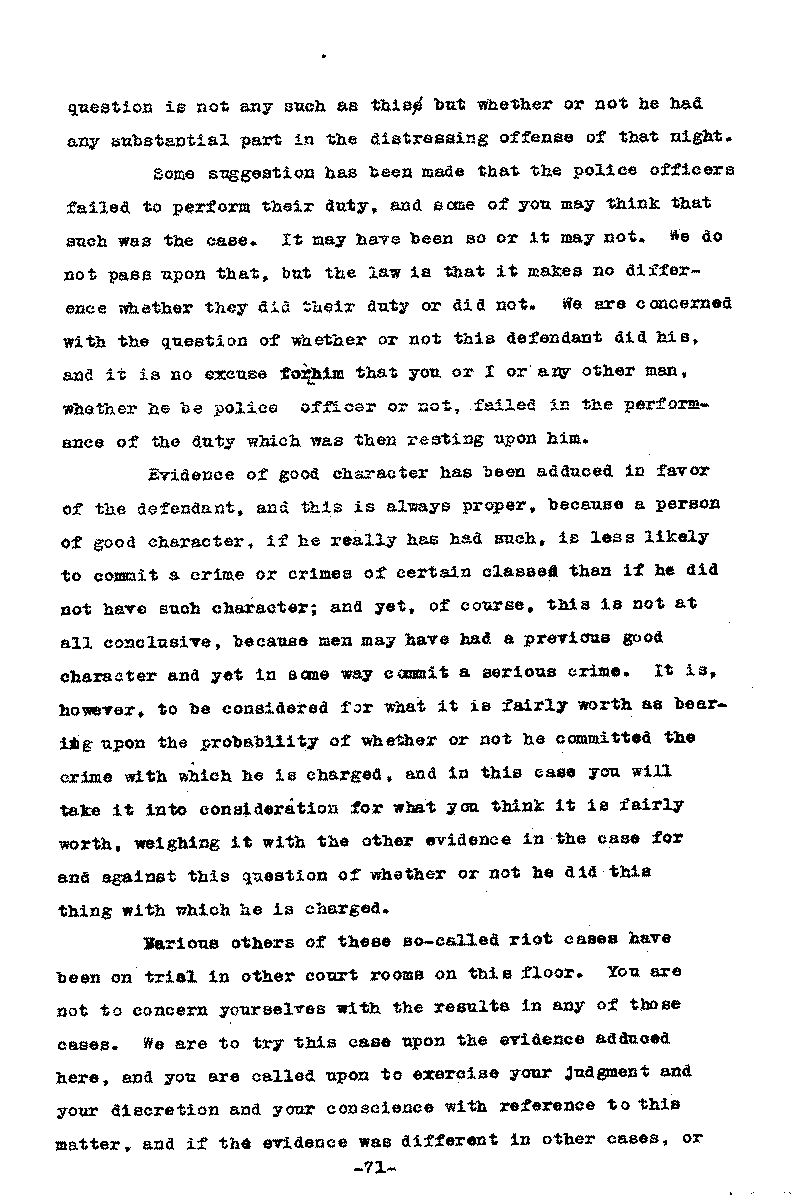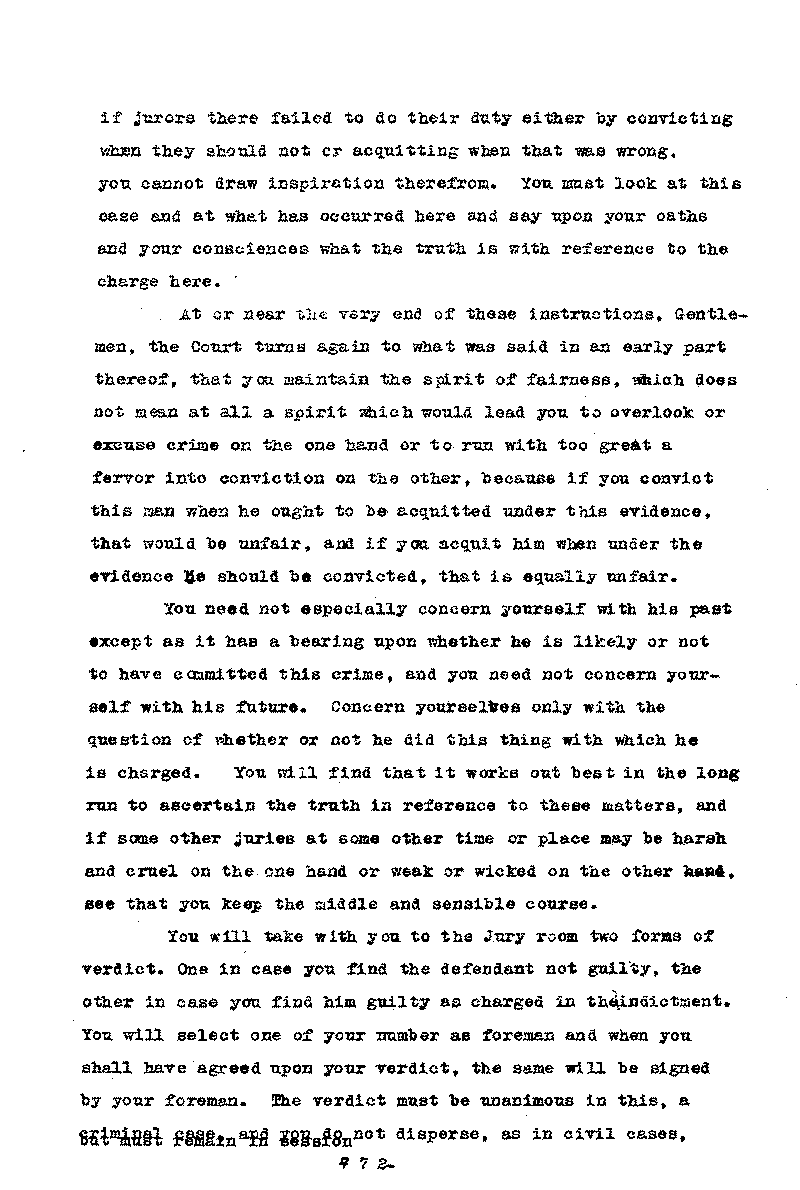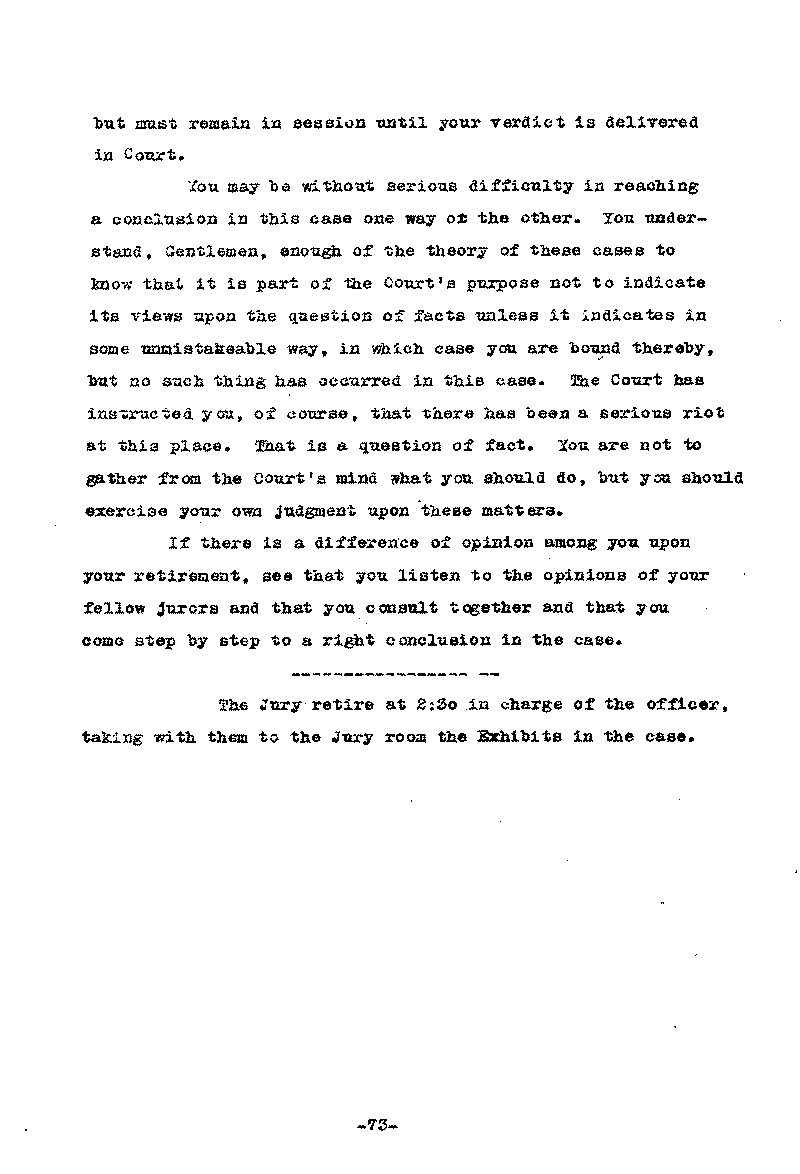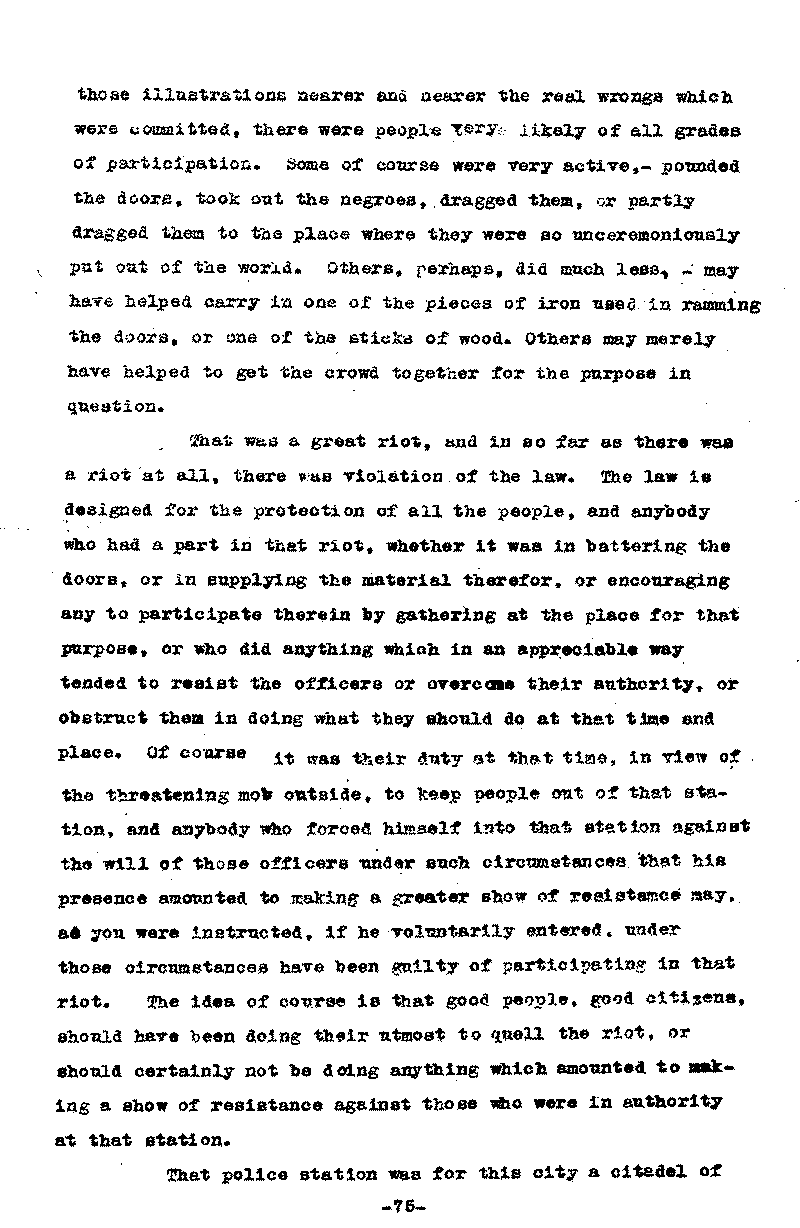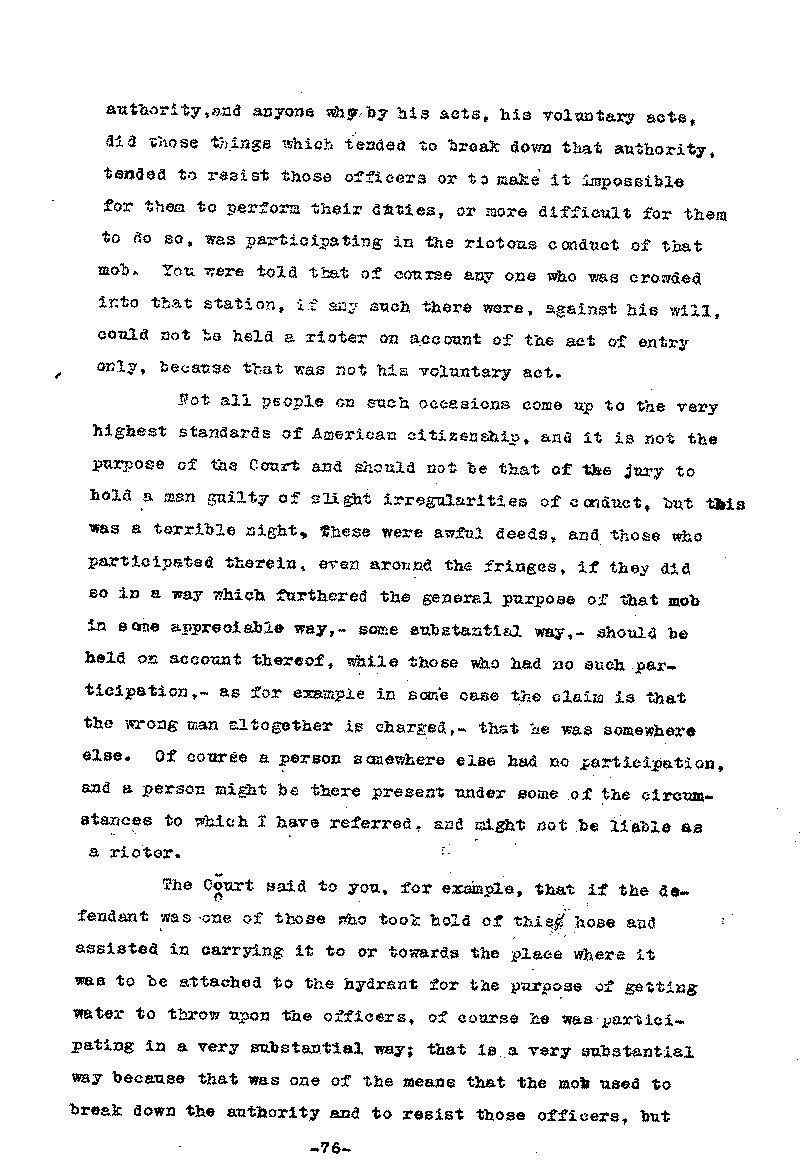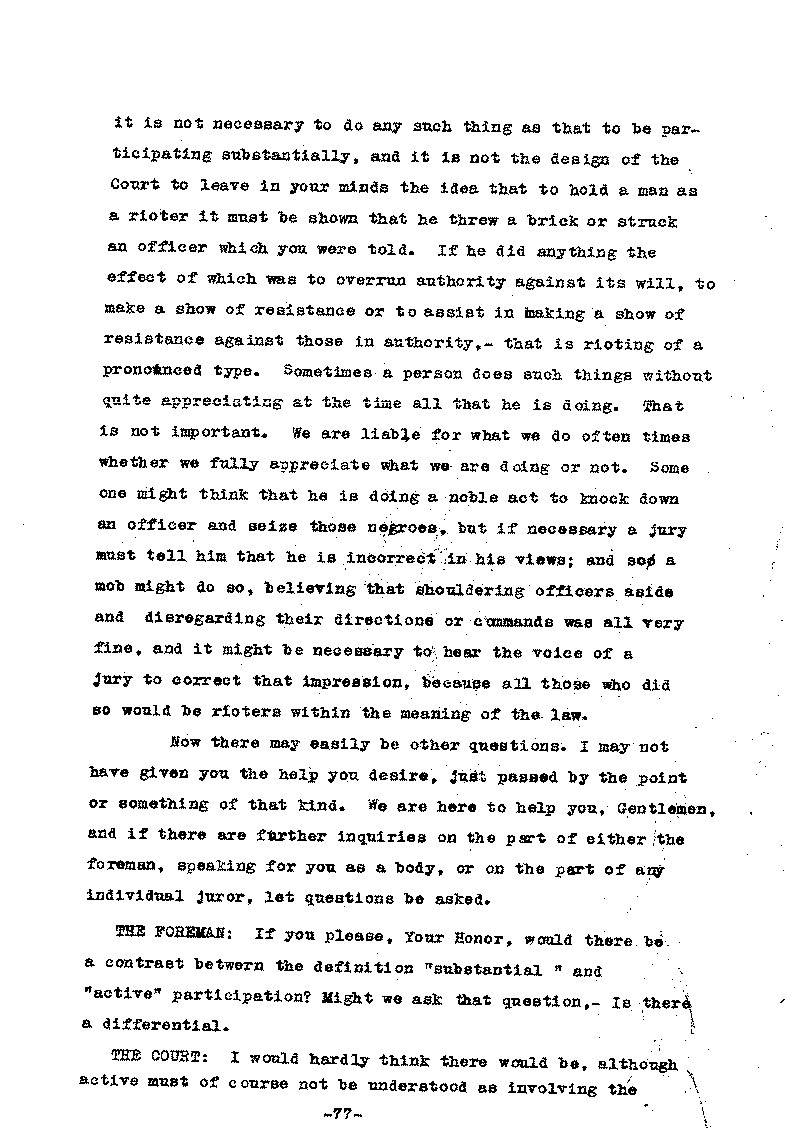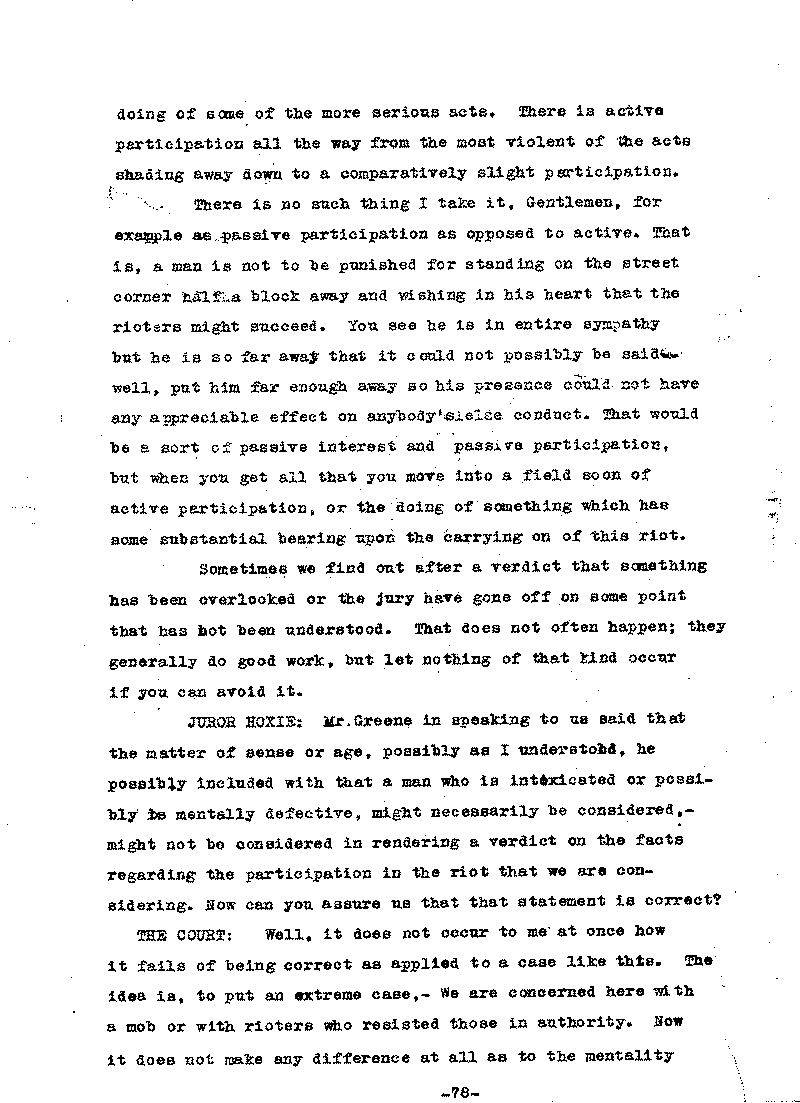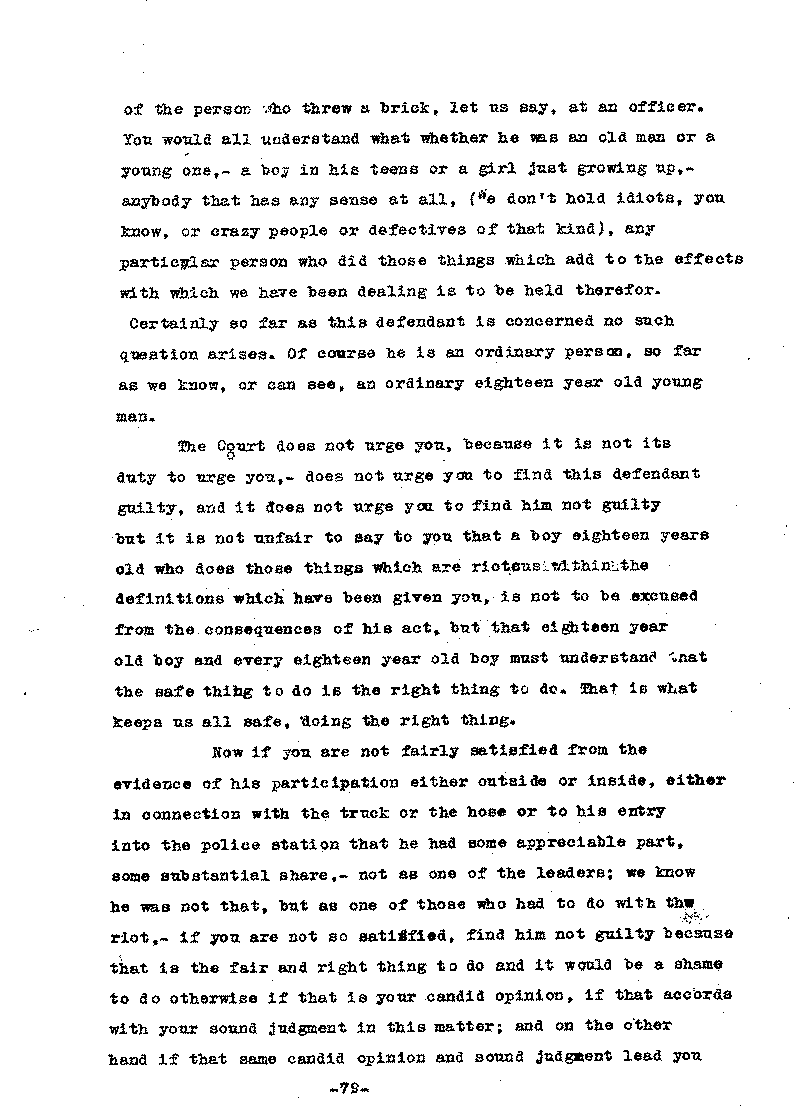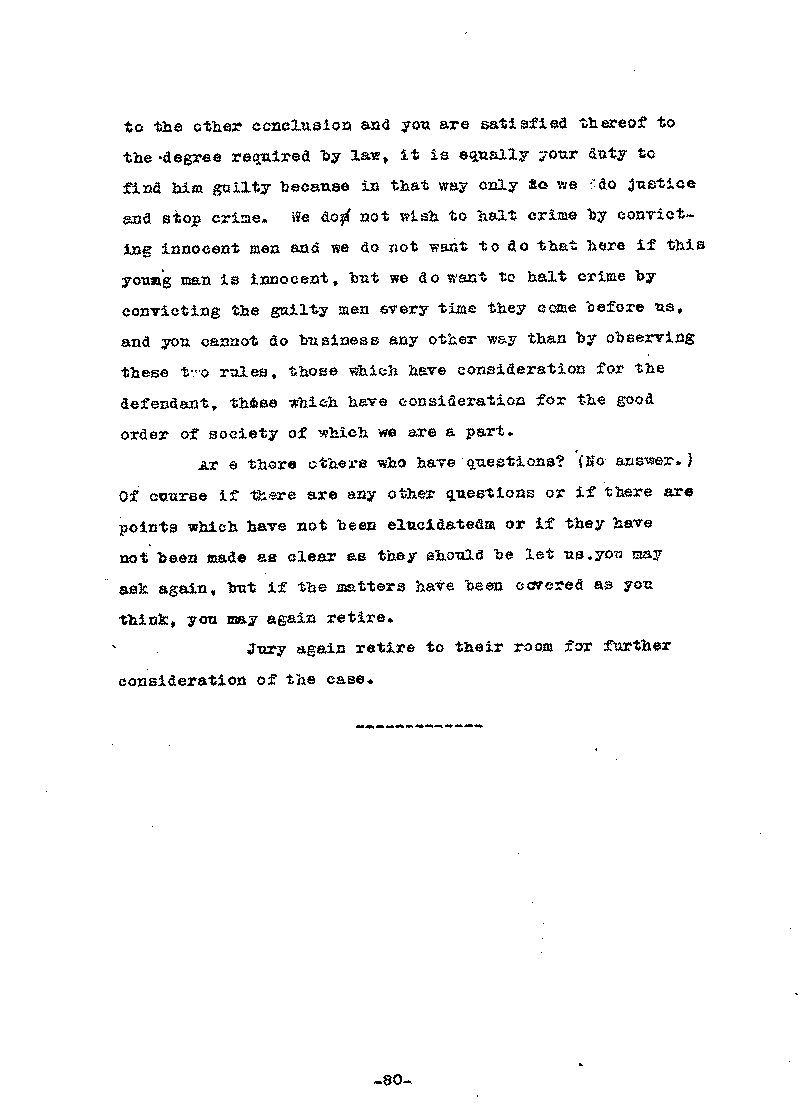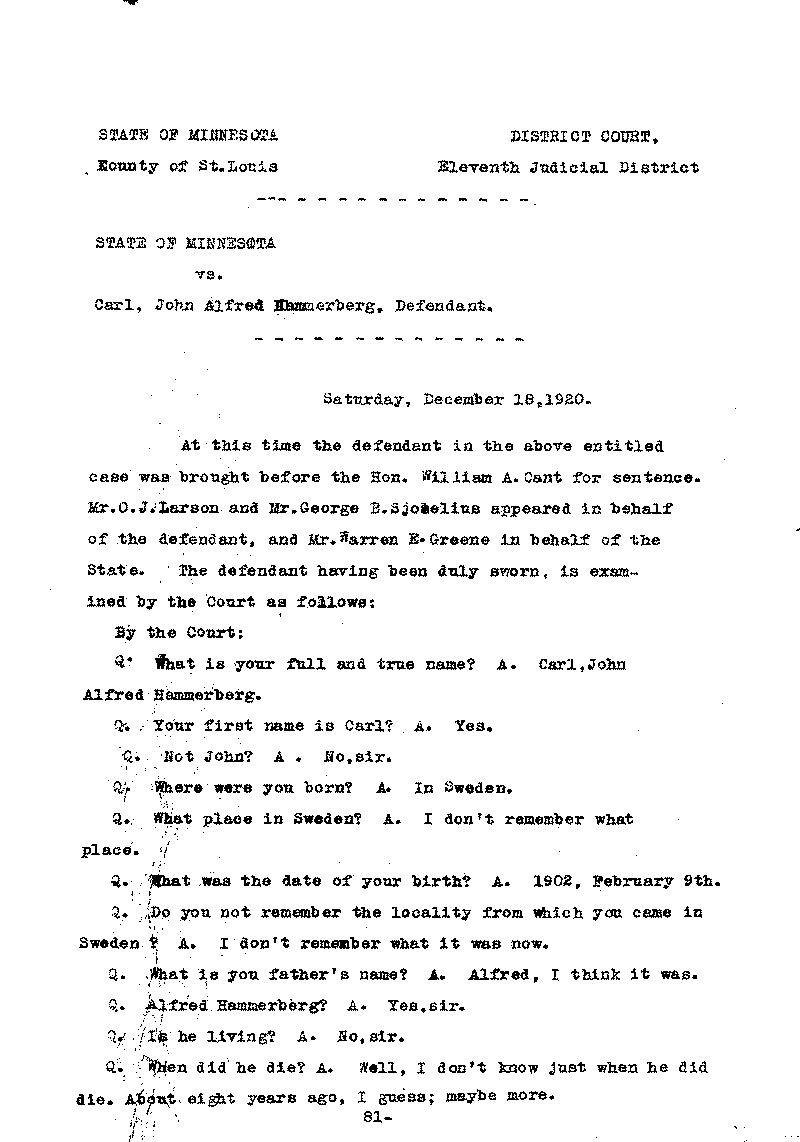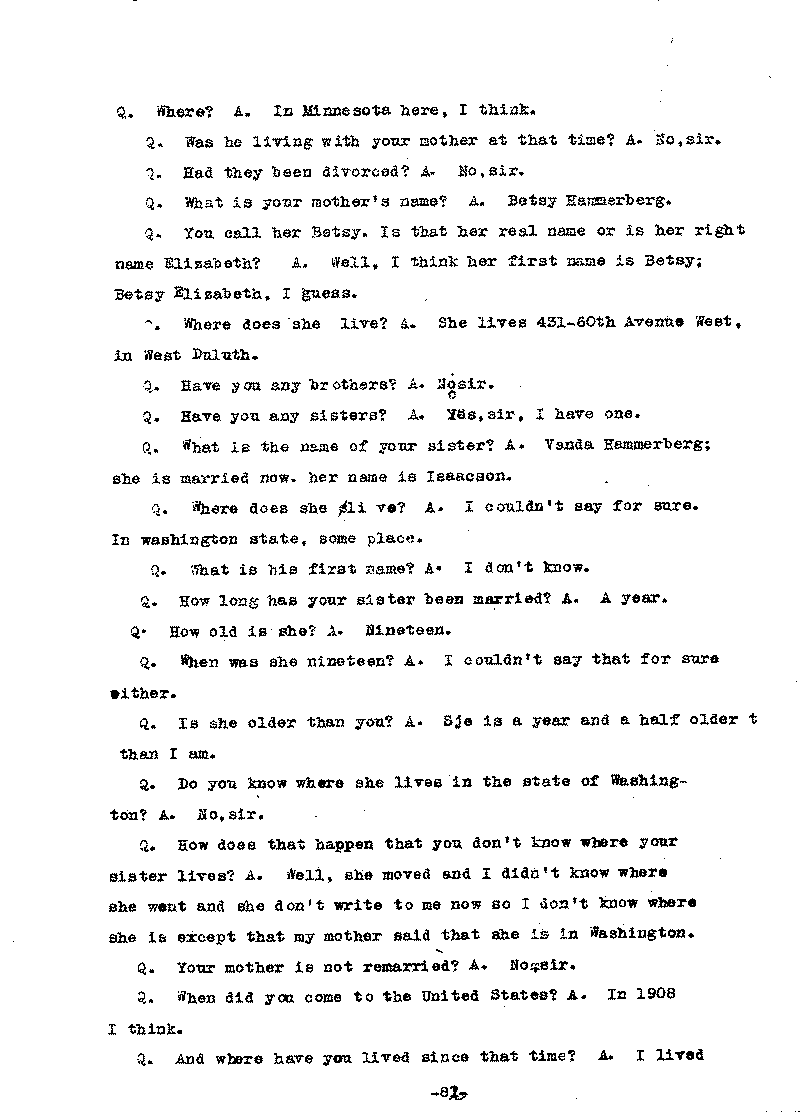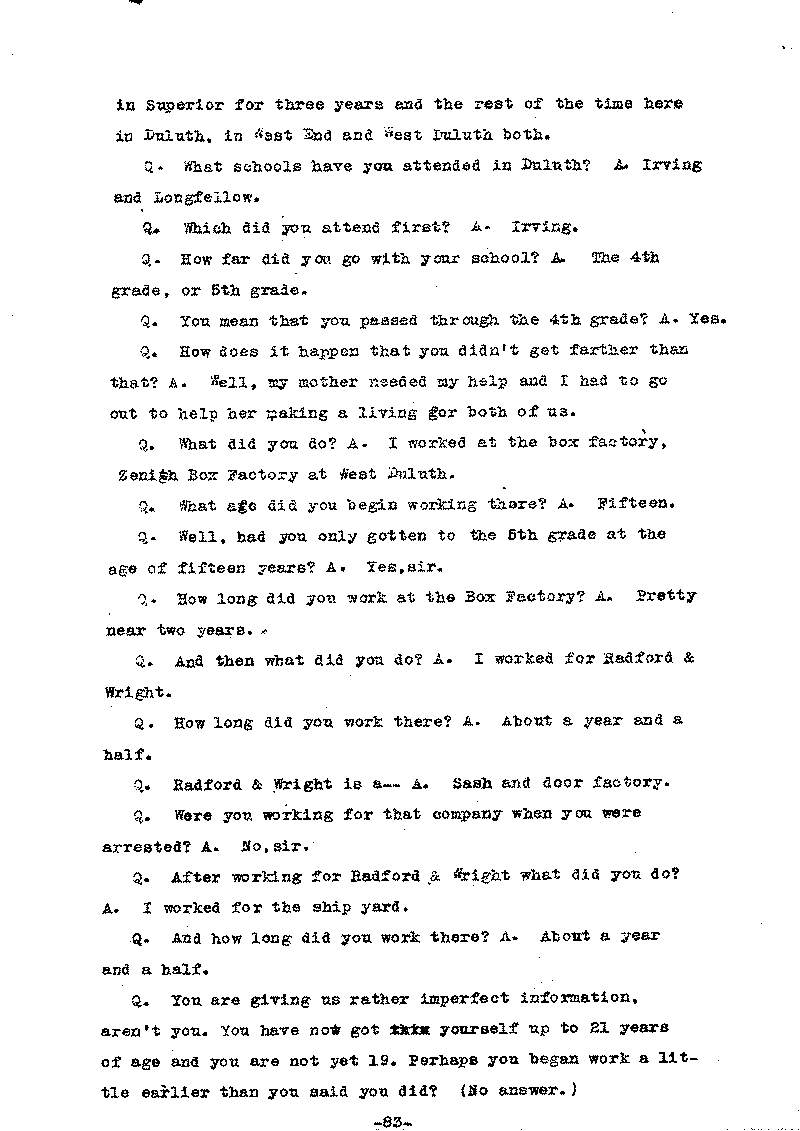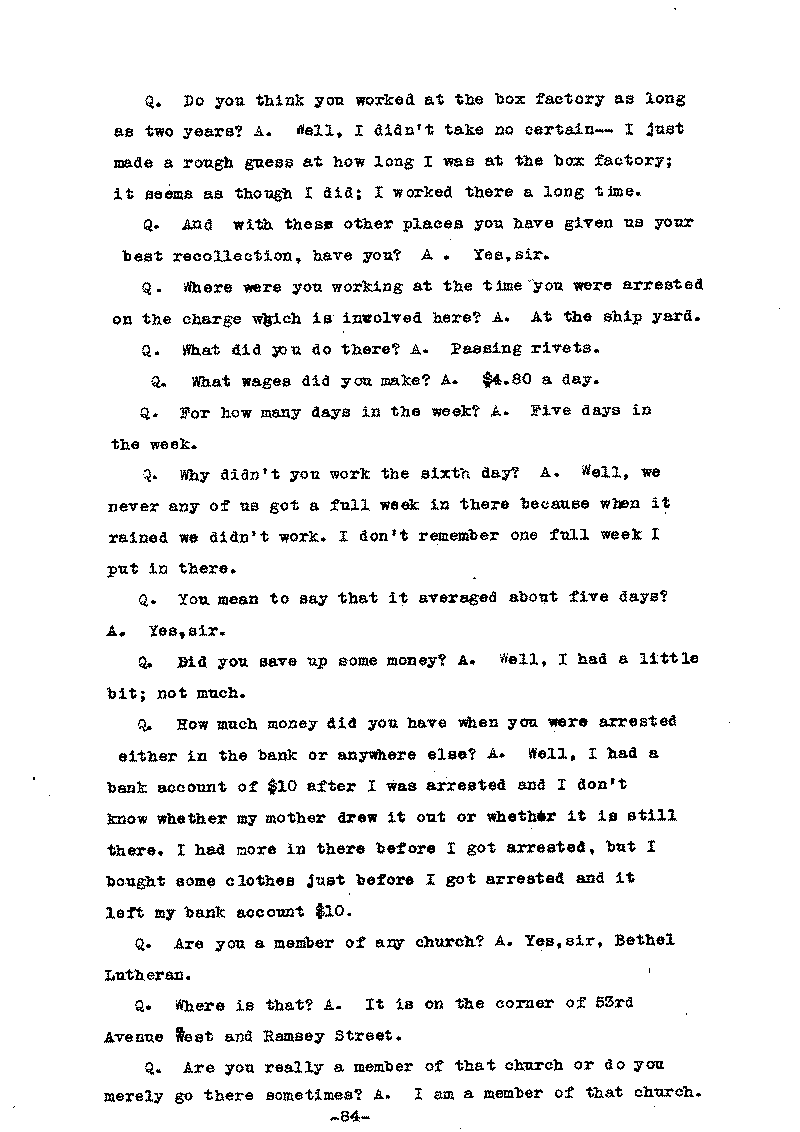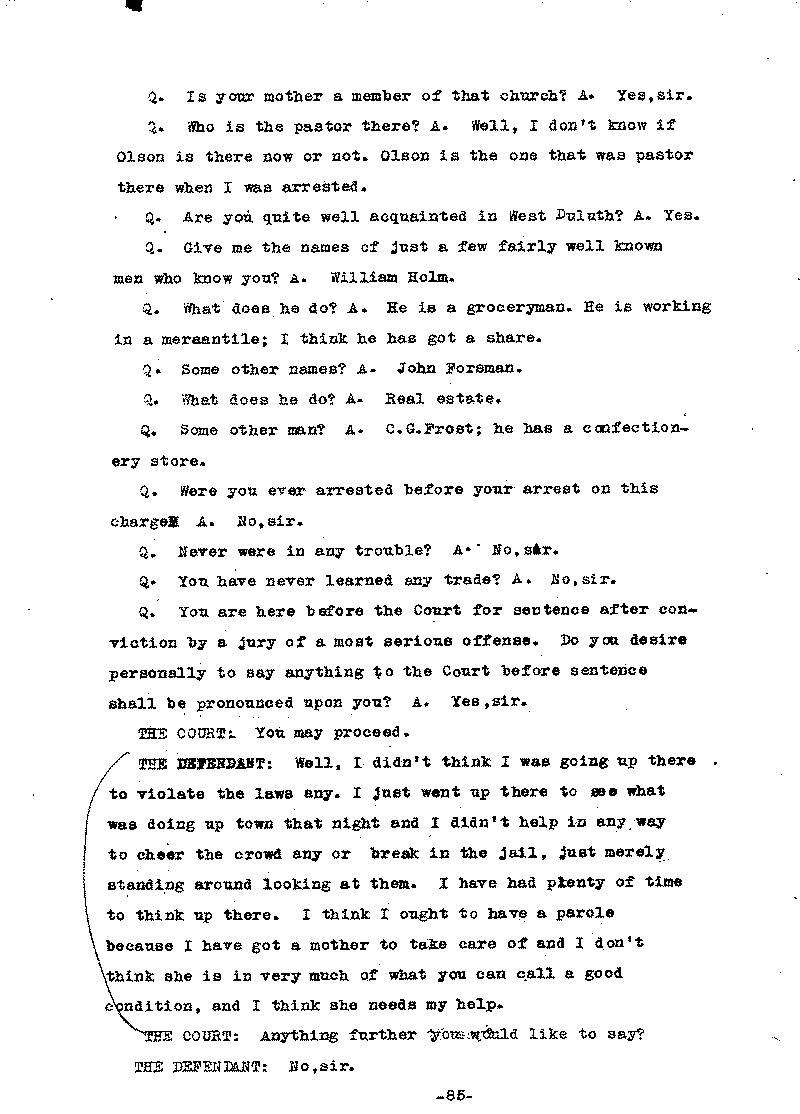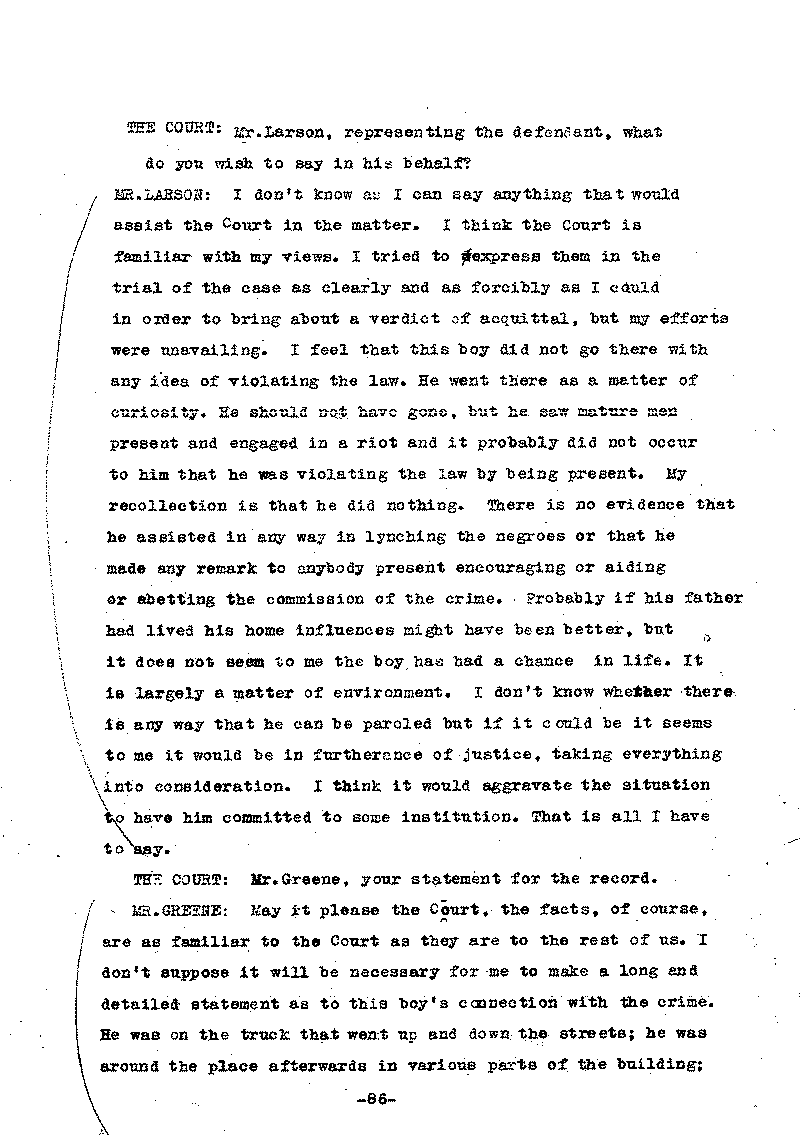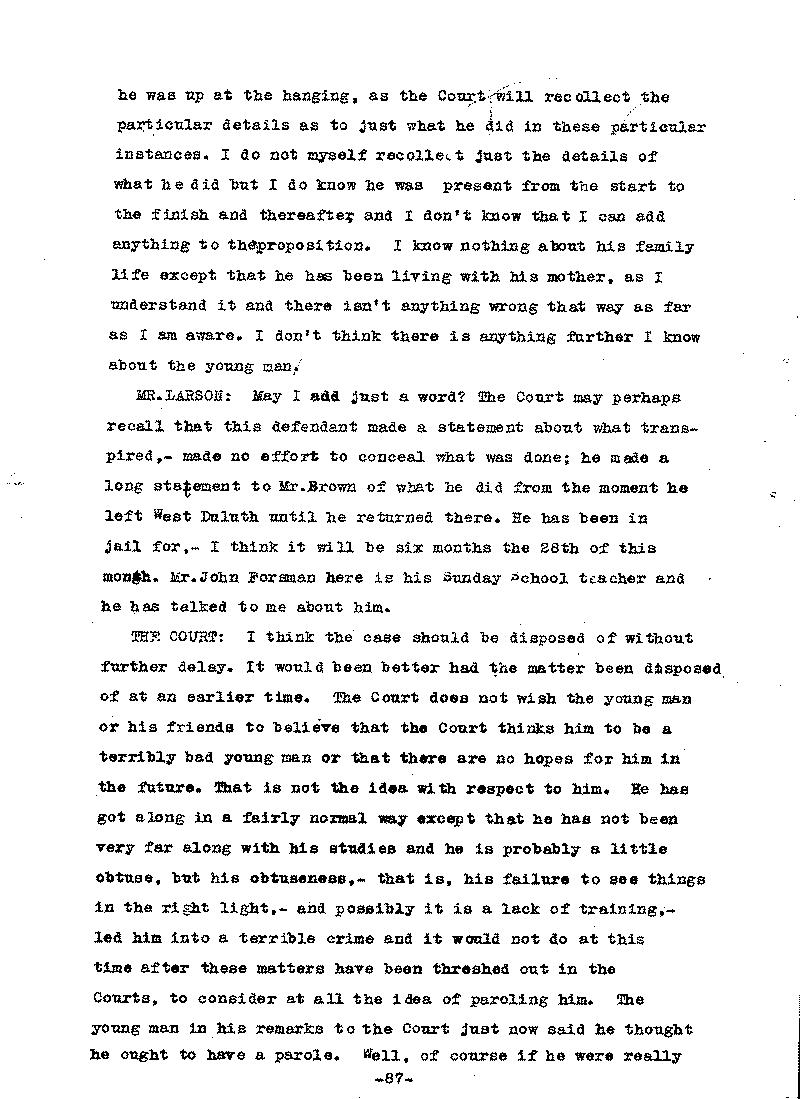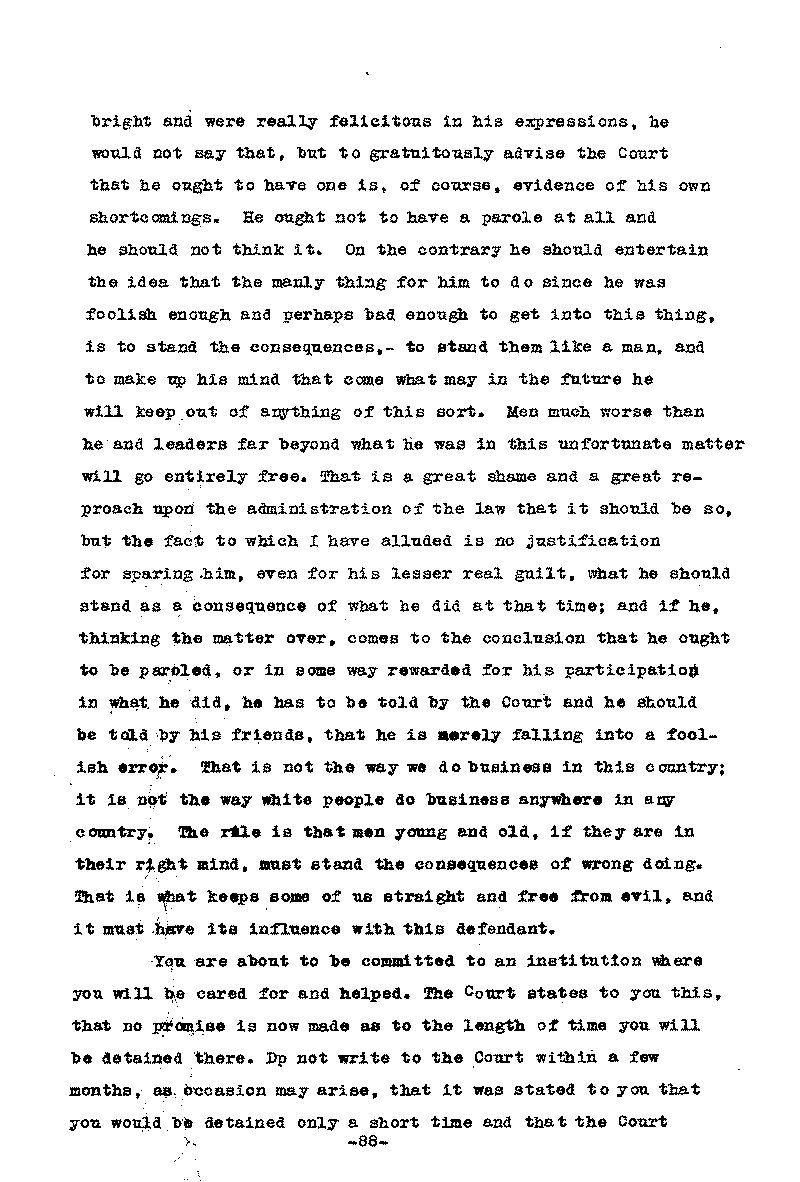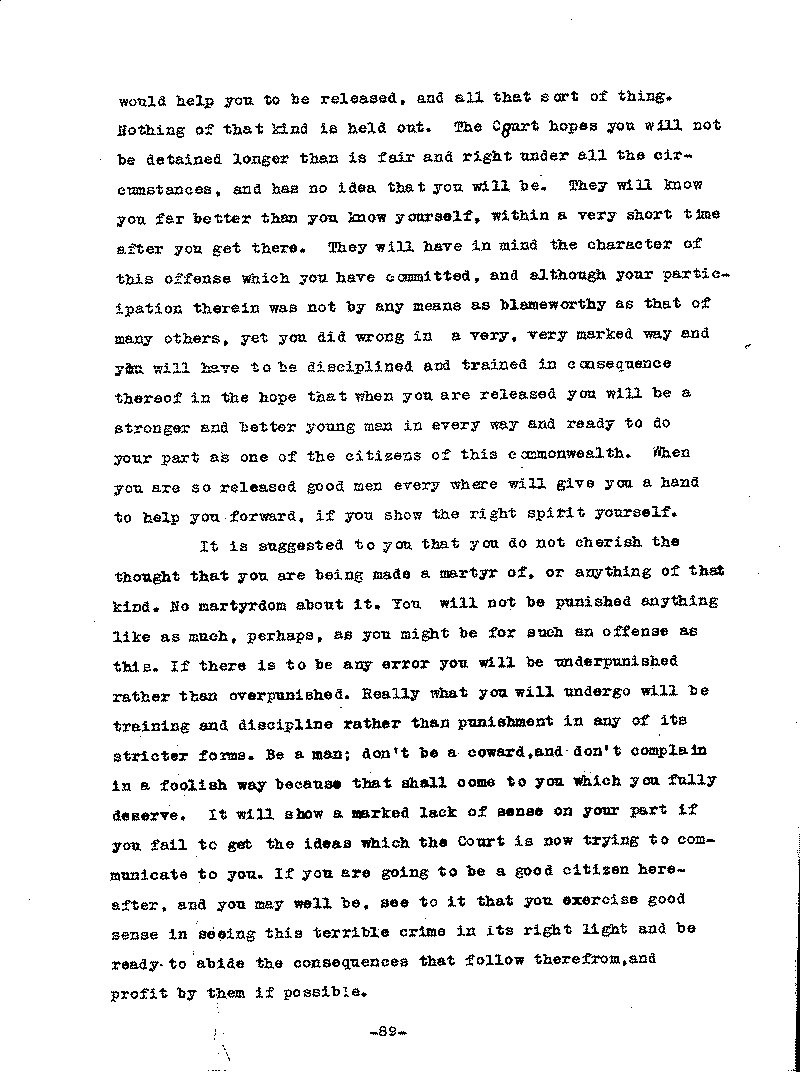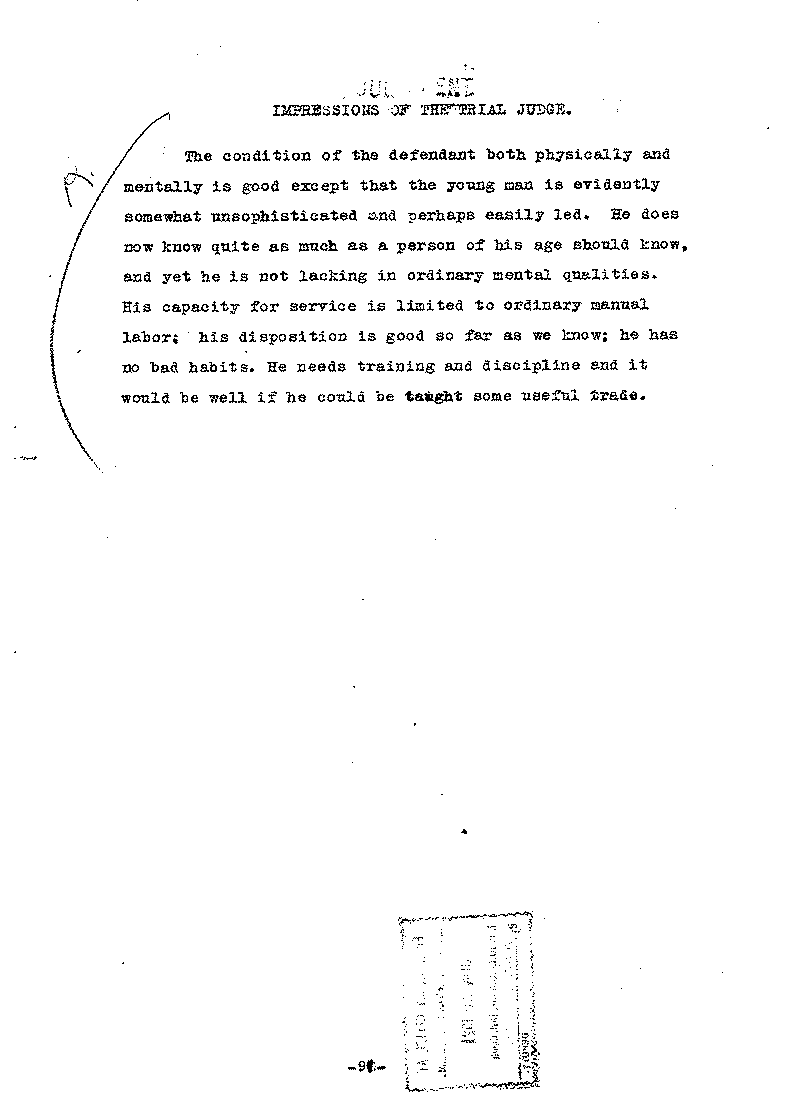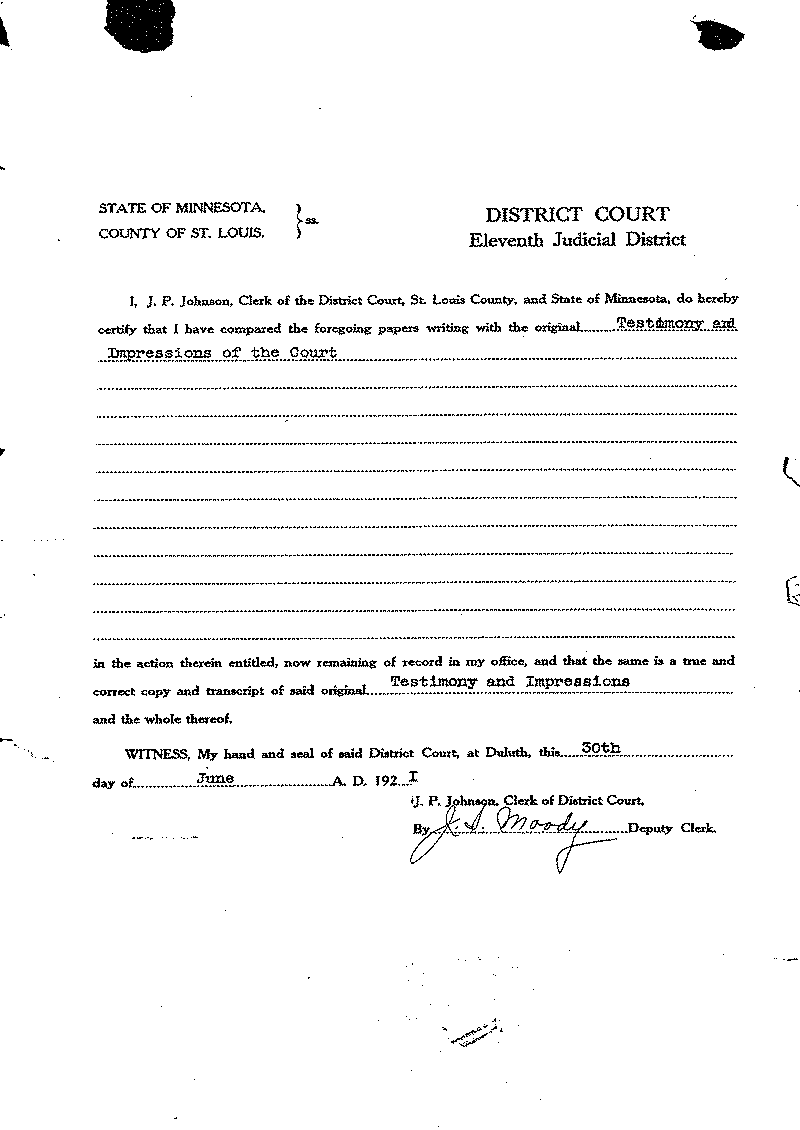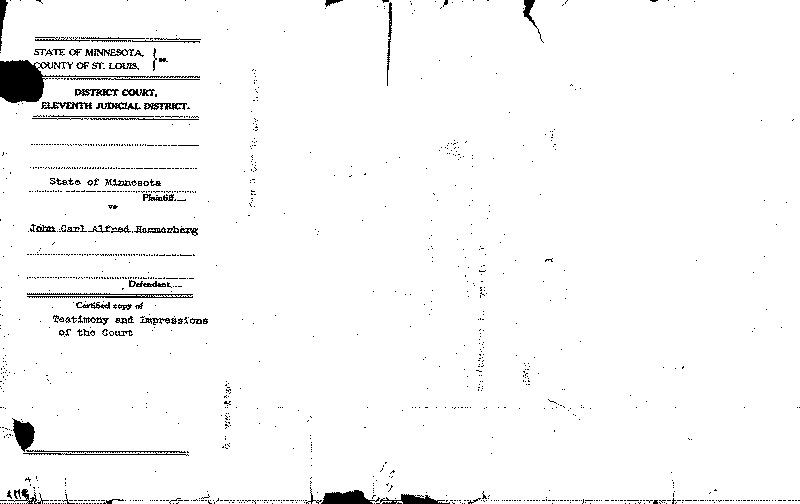Carl John Alfred Hammerberg. No. 5148. Trial Transcript. June 1921.
Type of event: Legal Proceedings
Location: St. Cloud; Stearns County; Minnesota; United States
Document date:
Document type: Gov't Record(s)
Document subtype: Trial Transcript
Documents: Carl John Alfred Hammerberg. No. 5148. Trial Transcript. June 1921.
Citation:
Minnesota State Reformatory for Men [St. Cloud State Reformatory].
Inmate Case Files.
No. 5148 (Carl John Alfred Hammerberg): Trial Transcript, June 1921.
District Court (Saint Louis County) case no. 5723.
Image text
JUDGES JUDGES
HON. J. D. ENSIGN HON. H. A. DANCER
HON. W. A. CANT HON. BERT
FESLER
HON. MARTIN HUGHES HON. EDWARD
FREEMAN
COUNTY OF ST.
LOUIS
OFFICE OF
CLERK OF DISTRICT
COURT
Duluth, Minn., June 30th 1921
J. P. JOHNSON:
CLERK
Mr. C. W. Vasaly,
Superintendent,
State Reformatory,
St. Cloud, Minnesota.
Dear Sir:
I am
enclosing certified copy of the testimony and impressions of the
court in the case of State VS John Carl Alfred Hammerberg who was committed and delivered to you some time ago.
Yours truly,
J. P. JOHNSON, Clerk.
By I. S. Moody
Deputy
I n d e x :
Witness Direct Cross Redirect Recross
Barber, E. H. 18- - - - - - - - - -21
Brown, John C. 31- - - - - - - -
- -33- - - - - - - - - -38- - - - - - - - - -38
Carson, Austin J. 23- - - -
- - - - - -27
Davis, Fred F. 1
Forsman, Jonh A. 44- - - - - - - - -
-44
Hammerberg, Carl 46- - - - - - - - - -51
Harris, Edward 45- - - - -
- - - - -45
Holm, William 43- - - - - - - - - -43
McHugh, Francis 39- -
- - - - - - - -42
O’Brien, Herbert J. 15- - - - - - - - -
-17
Olson, Oscar 4- - - - - - - - - -11- - - - - - - - - -14
State
Rests- - - - - - - - - - - - - 42
Defendant Rests- - - - - - - - -
-61
Charge- - - - - - - - - - - - - - - - -63
Examination- - - - - - - - -
- - - - 81
Sentence- - - - - - - - - - - - - - - 90
Impressions- - - - - -
- - - - - - - 91
STATE OF MINNESOTA DISTRICT COURT
County of St. Louis.
Eleventh Judicial District.
______________________________
STATE OF MINNESOTA
vs. Crim. 5722.
John Carl Alfred Hammerberg,
indicted under the
name of
Carle Hammerberg, Defendant.
______________________________
This case came duly on before the Hon. William A. Cant and a jury on
Friday, September 10, 1920, at the Court House in the City of Duluth, in said
County and State, Mr. Warren E. Greene appearing in behalf of the State, and
Messrs O. J. Larson and George B. Sjoselius appearing on behalf of the
defendant; the jury having been duly impaneled, Mr. Greene opens the case to the
jury on behalf of the State, and the following proceedings were taken:
FRED
F. DAVIS, sworn as a witness in behalf of the State, testifying as follow, in
answer to questions:
ON DIRECT EXAMINATION:
My name is Fred. F. Davis. I live in Duluth. I
am not now connected with thepolice department but I was on the 15th
of June last as special policeman, for about 30 days. At seven o’clock
in the evening of that day, June 15th, or at 7:30 rather, I was at
Fifth Avenue west. I had been at West Duluth earlier. There was a truck on
Superior street that attracted my attention somewhere in the neighborhood of
7:30 I should judge, when I was at Fifth Avenue west. I had not seen the truck
before that time. It was proceeding east. I was standing at Fifth Avenue west
when this truck came along going east; there was someboys riding on the truck
at that time and hollering. After the truck had passed I walked
down to Lake Avenue and the truck then came back west. There was, I should judge, six or eight boys riding on the truck hollering, “Come on down to the police station to the neck tie party.” I first heard them holler that when they passed me at Fifth Avenue. They were doing quite a lot of hollering but I don’t remember anything else they said than that. They were riding on this truck and hollering to the people on the street, I should judge, to them along the street. I heard them holler this remark several times; they were hollering quite loud. They were doing the same when I saw them the second time at Lake Avenue going west as the first time at Fifth Avenue west going east. They had a rope attached to the hind end of the truck when they came back the second time, going west, when I saw them at Lake Avenue. I went up to the police station. I did not see the truck afterwards. If I remember right there were three men, young fellows, had hold of the rope at this time. When I got to the station there was a few people standing around the station; there was not a big crowd around there then. I was at Fifth Avenue about 10 or 15 minutes, probably: I only saw the truck there once; I believe that was the first trip when they came from West Duluth and at that time I judge there was six or eight fellows on the truck; I didn’t pay muck attention to how many was on there. I didn’t count them then; when I met them again at Lake Avenue I should judge there was about the same number on the truck and two or three behind, if I remember right. When I got up to the police station I stood around outside there; there was only a few people there then but they kept on coming; I was down on Michigan Street for awhile. I was a plain clothes man. Nothing took place on Superior Street in front of the station before I went down on Michigan Street; the crowd kept gathering; they kept coming right along. There was a lot of loud talk out in front. There was nothing in particular said, just loud hollering for people to come on up to the police station. Then there was a few boys went down behind there and I went down to see what was going to take place on
-2-
Michigan Street. They smashed in the back doors of the police station,
the garage doors. I should judge there were 25 or 30 people there at that time;
there may have been more. I was standing on the corner of 2nd Ave
and Michigan Street. I think there somewhere about 25 or 30 there then but it
kept growing larger right along. I couldn’t say how long it took them to
get in from the time they started exactly; I should think it was an hour’s
time. I was still there when the doors were finally broken in. Bricks was
throwed through the windows above the door and I believe a bolt or bar of iron
was used to smash in the door with. I did not see them crowd inside the garage
after they broke in the door. I did not stay there until that attack was
discontinued by the crowd. I was walking around, first one place and another
amongst the crowd. When the water fight took place I was on the Avenue next to
the Knudsen garage. There was an attack made by the use of hose. The police
had a stream of hose playing on the crowd there and the crowd was playing a
stream of hose into the police station. I couldn’t see exactly where the
crowd got its hose. It was straight across from in front of the station where
they were standing with the hose. I saw the hose when it was brought down by
the fire department. I believe one stream was connected on Michigan Street and
one on Superior Street, if I remember right, for the police. I can’t say
how the crowd got their hose. I think they grabbed it away from the police. I
don’t know exactly how they got it, but I saw streams being used by the
police and by the crowd. I think I was telephoning in Knudsen’s garage
at the time the crowd went into the station. I was not in the station till late
in the evening. I was down beyond the corner of Michigan Street on the Ave-
when the first Negro was brought out and I didn’t see him brought out.
After I got up on the Avenue they said they had hung one of the niggers ten:
somebody was saying it in the crowd. I did not see anything that took place in
the police station, and did not see any of the niggers. (NO CROSS
EXAMINATION)
-3-
OSCAR OLSON, sworn as a witness in behalf of the State, testifies as
follows, in answer to questions:
ON DIRECT EXAMINATION
By Mr. Greene:
THE WITNESS: My name is Oscar Olson, and I am a sergeant
of polic> On the 15th of last June I went on duty at four
o’clock in the afternoon and from that time on during the riot I was in
charge of the police station. At that time I had in custody six Negroes and
among them were Elmer Jackson, Isaac McGhie and Eli Clayton; five of them were
in the large jail in cells, on the Superior Street floor, and one was in the
boys’ department jail on the second floor. I recognize State’s
Exhibit A as a blueprint of the location of the police headquarters, and I
think it is a correct representation of the lay out there, including the police
headquarters, the shrine building and he electric light pole and the streets and
avenues as marked. State’s Exhibit B is a plan of police headquarters
interior, and the basement, and is a correct representation of it.
Exhibits
A and B are offered in evidence and received without objection.
THE COURT:
It may be noted that C, D and E are correct representations of the matters
delineated thereon.
THE WITNESS continuing: The front entrance to the jail,
the main hall and the men’s jail are correctly represented on the plats.
The entrance from the main hall into the men’s jail is at the point marked
“jail door.” The cells I referred to in the men’s sjail are
these marked here “lock broken”. The door between the main hall and
the cells room was a sheet iron door, solid; you could not see through it, and
inside this solid door was an iron barred door.
THE COURT: All witnesses in
the case, either for the State of for the defendant will leave the room and
remain outside until they are called.
-4-
O. Olson
THE WITNESS continuing: The stairs form the main floor to the garage are
here, marked “down” on Exhibit C, and the stairs from the main floor
to the second floor are here marked “up”. On Exhibit D. which is a
plan of the second floor, the place indicated here as the boys’ jail is
correct; here is the door as marked “door’. The door marked A on
the plan is the door leading to the hallway that takes you to the waiting room
of the ladies’ jail and also to the boys’ department; in going up to
the jail on the second floor you enter into a sort of a balcony ; then you go
through the door that brings you into a small hall way, the door marked A.
When you go into that hallway at your left hand is a door marked B leading into
what is known as the waiting room. From that waiting room, to go into the
women’s jail you go through a sheet iron door inside of which is a barred
iron door, at the place marked “C” on the map. From this hallway,
you go through this door marked “door” to get into the boys
department. On the right of the hallway is a door leading into what is known as
the store room; at the time of the riot there were two or three lockers in there
and nothing else to my knowledge; the lockers took up more than half of one side
of the room next to the boys’ jail, a trifle better than half towards the
west wall and extending out about close to two feet. There was nothing on the
other side of the room to my knowledge. There was a peep hole in the wall
between the store room and the boys’ jail, near the west wall of the store
room, at the place marked peep hole on the plan. It was a funnel shaped affair.
The peep hole is shown on State’s Exhibit I, down at the bottom. This is
the peep hole that was in the wall of the store room and the wider part is on
the inside of the boys’ jail. The picture, Exhibit I is taken from the
wall of
the boys” jail. The hole in the wall shown in the picture was
not there before the riot but was here after the riot; that was the place where
the funnel was set in the wall, which was of tile, Exhibit I is a correct
representation of how the place looked the morning after
-5-
O. Olson
Direct
the riot.
State’s Exhibit I offered in evidence.
Received
without objection.
THE WITNESS continuing: Those are cells in the boys jail,
shown in Exhibit D. The door marked “A” was a sheet iron door; there
was no barred door inside it: the doors marked “doors”, the outside
is sheet iron and the inside is an iron barred door. The one marked
“B” is a frame door and the door between the hall and the store room
is also a frame door. The single Negro that I have referred to as being on the
second floor was in the boys’ jail here, but I don’t know which
cell. There were no Negroes in the women’s jail. The doors down in the
garage opening on Michigan Street were large solid wood core doors; in one of
the large doors is a small door used in going in and out, but the main doors are
big swing doors like in a barn of garage.
Recess is here taken until two
o’clock.
Two o’clock; hearing resumed:
THE WITNESS
Continuing: As I stated before, I was on duty from four o’clock on the
day of the riot, and I was in the station when the truck went by; as near as I
can remember that was 7:30 or shortly after. I see it going west on Superior
Street. I did not hear what the people on it were hollering, but I did hear a
noise from it, a number of voices; they were shouting and hollering; I
couldn’t distinguish what they were saying. I had 11 policemen at the
station at that time. I stationed six of them at the front entrance and five of
them to the rear entrance in the garage on Michigan Street. When the truck went
by there was an unusual number of people out in front, and the crowd kept
increasing. It was shortly after the truck went by that I made the disposition
of the policemen that I mentioned, and when I did so there was quite a number of
people out in front, more than there had been when the truck went by and when I
put the policemen out there I could
-6-
O. Olson
Direct
hear a number of voices shouting and hollering. I could hear different
remarks, such as, ‘Bring them out here” and “Let us get
them” and “Let us go” and the likes of that. They attempted
to get in the front way and they later went around to Michigan Street entrance
abd started to throw stones, brick and other things, breaking down the large
doors and breaking windows. The building was damaged considerable by brick and
stones and water. The cars were also damaged some, the windshield being broken
on one and the
top broken on one of the; I don’t know which one, but
they weren’t badly wrecked but they were damaged as I stated. The garage
doors were broken; quite a bit of damage done to the doors. The mob on Michigan
Street were throwing stones and bricks and other things and got into the garage
and attempted to come up a small stairway when the hose was turned on them and
they were kept from coming up the stairs. We got the hose from the city fire
department and it was attached to a hydrant on Second Avenue East and Superior
Street on the lower corner but I don’t know whether it was the east or
west corner; it led into the front entrance of the station and brought to the
stairway leading down to the garage, to the basement and we were using water on
the mob and fought them off from there with the water and later they went
around to Superior Street and broke; they broke windows and broke down the door
and don considerable damage to the building inside by brick coming in. The
attack on Michigan Street was before the water fight on Superior Street, but
before the water fight they used sticks and stones and bricks in front of the
building; they broke all the large windows in police headquarters and one or two
of the smaller windows up above these large windows. When the attack started
on the front of the building I brought the hose to the front and turned it on
the mob. Shortly after that they got some water; they had a hose of their oven
that was taken away from the fire department.
-7-
O. Olson
Direct
They had the nozzle on the opposite side of the street some distance;
they were quite near Second Avenue East at the start and they wowed closer
towards the station. Myself and one or two other policemen heal our hose out in
front of the station and we was to the edge of the sidewalk and keeping the mob
back sometime, and the crowd plying their water onto us again, with stones and
bricks and other things that could be thrown and we were finally backed up into
a corner and it was there I was left alone with the hose and finally I had no
more water. At that time I was right in the front door. The water failed because
the hose was cut. Before that I had stationed the policemen that I could find
and instructed them to guard the hose so that it wouldn't be cut by the mob;
they were stationed along the hose as it came from the hydrant to the front
door. I was backed-up to the front door when the water quit on me, but the crowd
still had water. After I had no more water I staid for a short time with an arm
up in the air thinking the mob would understand that I had something to say but
I was forced away from there and I ran into the basement, to the garage. I went
down in the basement for help. The water that came from the hose of the mob, and
the stones and bricks forced me away from the outside door and I went down
stairs for a fear minutes and then came up and then the mob was right close to
the door and I again attempted to get outside and finally the mob came into the
hallway of the station, with a rush, in the front door of the station. At that
time there was a lot of brick on the floor and the paper was loosened in places
on the walls and hanging down, and the station had been damaged bar water and
there was maybe four or five inches of water on the floor; the pictures were
knocked off the walls and scattered about the rooms. When the crowd came in they
ran to the stairway leading up to the different floors; some of the mob stopped
at the large jail door and some of them stopped at the jail doors up stairs.
-8-
O. Olson
Direct
They came in and went up stairs, and the hall down stairs vies packed
with men, and about that time there was some speech making there. I could hear
pounding on the doors; I think it began about five minutes after -the crowd
first started in there, and I think it began up stairs if I remember correctly,
and it kept up until about midnight. I think the crowd came into the hall around
between 10 and 10:30 and when they took the first negro out, as near as I can
judge, it was after 11, and close on to half past, I should think, and I should
think it was close to 12 when they toot the last two. From the sound of the
pounding, I should say the mob was pounding on the iron doors; as a result of
what was done by the mob, one door on the second floor was torn from its hinges,
the iron door leading into the hall way that takes you to the boys' jail and the
waiting room of the ladies’ jail. That is the door marked "A" on State's
Exhibit D. Of the two doors leading from the hallway into the boys' jail, the
outside one was kind of sunk but I don't remember if it was torn off. It was
opened. The inside door was not damaged. There was no entrance from the hall
into the boys' jail through those two doors marked on the plat; at the doors
marked "C,” the outside iron door was broker off the hinges and the inside
barred door was broken, the lock was broken so they gained entrance. The door
marked "B" the top was broken off completely, and the door marked "D" was also
broken. There was a hole made in the wall leading from the store room into the
bays' jail, the hole shown in the photograph, Exhibit I. There was no damage
done inside of the cell room. The cell rooms have doors on them with looks; the
doors can be opened without breaking the locks by using the lever; if you lift
up on the lever the door opens; when you close the door the lever hooks over the
locks and they can be opened from the outside by lifting up the lever.
-9-
O. Olson
Direct
Down stairs the outside iron door leading from the main hall into the
men's jail was broken from its hinges and the barred door was damaged some; the
locks were broken off, and they gained admission into the jail that way. In the
men's jail down stairs the locks ware broken off or knocked off the door. That
was necessary to gain admission to the cells, if they were locked with a key;
they couldn't be opened otherwise without knocking them off. I don't know
whether they were locked with a key that night or not; anyway the locks were
broken from the doors The stairways were crowded, and while they were battering
down, these doors some of the crowd were hollering and jumping around. They ware
using a large timber, part of a railroad rail and crow bars, sledge hammers and
several other instruments to batter down the doors. As near as I can tell they
were at work breaking in the doors from sometime around 10 or 10:30 up to half
past 11 when the first negro went out, roughly speaking. I was not looking at a
time piece; they took the first negro from the large jail down stairs, I think,
but I didn't see where he came from. I could hear the mob hollering, "They have
got the first one." At that time I was in the secretary's room; after they got
outside of the station I see the crowd moving east; they were hollering and
pushing and walking and running up Second Avenue; they were just turning the
corner when I see the whole mob going in that direction; it was sometime around
35 or 40 minutes afterwards before they got the other two. I didn't see that. I
think I was in the secretary's room. I didn't know until after they were taken
out that they were gone. I could hear the mob or some of the men about the
building saying that "they have got them" or things of that sort. I didn't see
where they took them. I didn't go up to see any of the hanging. The Chief came
there about a quarter of 12, as near as I remember; he was there before the last
two were taken out.
-10-
0. Olson
0N CROSS EXAMINATION, by Mr. Larson:
At 4:20 on that day I learned
that there was likely to be some trouble at the police station, after I arrived
there. I got in the station about 3:35 and I went on duty about seven minutes of
four. I didn't learn the names of the negroes until after they were hanged; I
first learned the names when I see the names in the News Tribune in the morning.
Isaac McGhie was hanged first; I heard it talked of after the lynching, just
general talk. I have no way of finding out positively that he was the first
negro. I thought he was taken from the large jail down stairs. I don't know why
I thought so. I didn't know who they were down stairs; I knew one of then was up
in the boys' jail, and which one of the six I didn't know. There were six
negroes in jail at that time; those six that were there in the evening were
placed in there between 7:30 and 8 o'clock the morning of the 15th, with six or
seven others, but they ware not all there at the time the crowd came; they had
been released but I don't know when. I took part in the arrest; it was between
four o'clock and 7:30 in the morning. They were arrested in the yards of the
Canadian Northern down at West Duluth, I left the negroes in the jailer's room.
I assisted in taking them from the railroad yards to the police station. I left
them in the jailer's room, and it was his duty to put them in cells. Jailer
Harling was there that night. 'When I heard there was likely to be trouble that
night, the first steps I took I called in a motor cycle policeman and a
detective and instructed the motor cycle officer to run about the different
streets to see whether he could see a group of people or a number of people any
place, and to run out in the west end and West Duluth and see what he could see
there and come back and report to me What he had learned, and I instructed the
detective to go down street and drop into different places where he thought
there might be a bunch of
-11-
O. Olson
Cross
youngsters talking, such as in places like pool halls and they come back
and reported that it was no more than what had been going on all afternoon. They
didn't see any unusual number of people any place or any bunches of people of
they didn't hear any other talk than what they had heard during the day, which
was a remark such as some talk about lynching the niggers. Their report to me
was that they didn't learn any more than what they had heard or seen during the
day. I sent Motor-cycle Bailey and Detective McKenna. When I got the report I
instructed the operator to notify all men off duty to report at Headquarters at
once and I also notified the Sheriff and Commissioner of Public Safety and the
Chief of the fire department. I notified the Commissioner of Public Safety by
telephone at his residence around seven o'clock or shortly after, and I notified
the Sheriff about the same time. By that time three or four of the officers had
reported to the station, and Mr. Murnian came down; he came after 7:30; I did
not see him after the crowd got into the police station; I see him at different
times before the crowd came in, about the building, in the hall way and the
office. I had some talk with him about what was the proper thing to do under the
circumstances. There was something said about using fire arms. I outlined my
plans and instructions to the men to Murnian, the Commissioner, and he thought
they were all right. I instructed the men to attend s strictly to business and
not to talk to anybody and to keep the crowd from coming into the station and
not to shoot until you have to; be careful and do not get into trouble, and
those lines. There was nothing said about making any arrests that I remember. As
I said, I assigned six officers in front of the station and five in the rear.
Three of the officers in front were Isaacson and Lading and Nystrom; I don't
remember the names of the other three. Officers Sorenson, Mahlon
-12-
O. Olson
Cross
and Shannon were assigned to the basement; that is all I remember. I
didn't see the crowd on Michigan Street that made the attack on the garage; in
front, they were standing all over the street and sidewalks and on Second Avenue
East, but I don't think it extended to First Avenue; both sidewalks were full
and a considerable number of people on the street proper between the sidewalks;
probably between four and five thousand people. I don't know if the remarks
mentioned carne from that crowd but it came in the direction where the crowd
was. The remarks were, "Let us have them" and "Let us go, and things of that
sort, "What if it were your sister." There were a great many people, young and
old, laboring men and businessmen, and women, and they seemed to be considerably
excited; there was loud talking and hollering, moving back and forward in all
directions. When we put the hose on them, it had some effect and they started
back for a time until the water was gone. With me at the hose was officer
Sorenson and a special policeman by the name of Webster and I also called a
fireman over to my help, by the name of Dunn. I don't know what became of them
when I went into the police station; they disappeared; then I went down stairs;
when I left no one was guarding the front entrance of the police station. When I
got down stairs I saw some policemen down there and tried to get them to come up
and assist me, with no success, and then I came back up stairs. The hallway was
packed and there were people in the general office and the jailer's room, but
the room between the jailer's room and the jail proper was not packed, but there
was a number of people there; the stairway was packed. I recognized different
people in the crowd. One was Leonard Hedman and Dondino, and I saw Attorney
McClearn and some newspaper men, one by the name of Carson and another by the
name of Gallup. There were several faces I know but I don't know their names. I
saw police-
-13-
O. Olson
Cross
man Harry Sorenson in the hallway, on in the entrance to the jailer's
room from the hallway, at the place marked H on State's Exhibit C. I don't know
whether there was any effort on the part of any policeman to prevent the first
negro from being taken out of the building, I did not see any. There was an
effort made to prevent the second and third men from being taken out of the
building; this was done by Officer Nesgoda and Sandberg and Walker and
Lieutenant Barber. I don’t know what they did. I didn't t see them do any
thing. There were no arrests made that night concerning the lynching; no one in
the crowd either out doors or in the building gas arrested.
ON REDIRECT EXAMINATION by Mr. Greene:
I don't know why no arrests was made; there was other things to attend to
besides arresting them; I thought that would be taken care of later; that was my
opinion of the affair. After the crowd got packed in there it wasn't possible to
make any arrests with the number of officers we had there; there was a crowd
there of four or five thousand people on Superior street beside the people on
Michigan Street, and it increased during the evening and from what I could see
during the time I was out in the water fight there was people as far as I could
see east and west, blockading all traffic. I did not go up to the pole when the
negroes were taken down. I was not In that bunch.
-------oOo------------
-14-
HERBERT J. O'BRIEN, sworn as a witness on behalf of the State, testifies as follows in
answer to questions:
DIRECT EXAMINATION, by Mr. Greene:
THE WITNESS: My name is Herbert J. O'Brien; I live at Nopeming
Sanitarium; my family live In West Duluth; I was living there on the 15th of
June last, at the Cody Hotel. I came down town on Dondino’s truck that
evening; I got on the truck at Bristol Street and Central Avenue out in West
Duluth; at that time there wasn't anybody else in the track, but we picked up
same boys as we came in; there was four or five jumped on as we were pulling
out; the driver was on the truck when I got on and then others got on. It was
just a common dray truck, just a common truck behind. The driver sat in the
front seat, and back of him was an open truck. We drove straight down Central
Avenue; I think we struck Grand Avenue and then we come down Grand Avenue until
we got to the ore docks and then we turned down to Superior Street until it was
30th Avenue end we drove up Superior Street I think it was to 3rd Avenue East,
up through the central part of the city. The fellows on the truck were hollering
around the west end; they were just hollering they were going to have a neck tie
party. Then they drove to 3rd Avenue East and then turned around and went back
west on Superior Street to 7th Avenue West and then turned around again and went
east to Lake Avenue and then turned around and went west to 2nd Avenue West and
then they turned around and went right up to police headquarters, in front of
the police station and got out. When they were driving up and down Superior
Street there was a lot of talk, this and that, among the bunch on the truck;
they weren’t hollering at the people very much the first round, not until
the crowd all got on the truck; all that could possibly get on got on the truck.
I didn't see the rope at all; you couldn't flee back at all
-15-
O’Brien
Direct
there were so many on the truck so I didn't see to rope; there was
probably 16 or 20 on the truck when we were going up and down the street, and
than we went down in front of the police station; then we went easy the first
time to 3rd Avenue East there was quite a bunch on the upper side; I judge there
would be probably five or six fellows inside looking outside of the police
station but there was nobody outside at all. When we got back finally and got
off the truck there was quite a crowd at the police station then; it had grown
from the first time till we finally got off. When I got off I came right down in
front of the police station and there was six policemen standing in front of the
door but I didn't know none of them only Isaacson; then I crossed across the
street to the cigar store, and I didn't see anyone around there that I knew of
the bunch and I bummed around there awhile and then I went across the street
again. The crowd was hollering once in awhile, "Hand out the niggers" and one
thing and another like that, that that was what brought them there. I was not
down on Michigan Street at the time of the attack; I was down as far as the
corner but I couldn't get no further; that was just before they started the
water hose on Superior Street. I couldn't see what they were doing on Michigan
Street. I saw the water fight on Superior Street. I was in the station during
the evening; I got in a couple of feet past that big safe that is in there;
there was such a crowd that you couldn't get no more in. All those that was down
in the hall ways down stairs they was all right; they wasn't moving at all
because they couldn't move very much either way. They were very quiet, some of
them, but there was lots of noise. The stairways and gallery was full up stairs
and there was some fellow saying: "Just go easy; just keep quiet until we get
him. We have got the first door down and as soon as we get the other doors down
we will hand the
-16-
O’Brien
Direct
niggers down to you and then they all cheered and hollered and clapped. I
was right opposite the safe in the main hall when the first negro was brought
down, I can't say where he came from; I thought he came out of the first floor.
They passed right out just like a shot out of a gun and I was standing in that
hall way for about an hour and forty minutes or an hour and a half when I was
just caught right in the jam and I was swept right out with them. I saw the
lynching; one negro was hung at first it was about ten minutes later before the
other two were hung; the last two came together; they were hung on the pole at
2nd Avenue East and 1st street right by the Shrine Auditorium; I was about 25
feet or so away from the pole when the first negro was hung, out in the crowd; I
was 40 or 50 feet away when the second two were hung, up on 2nd Avenue.
ON
CROSS EXAMINATION, by Mr. Larson,
I had a good opportunity to see the crowd
on Superior Street in front of the police station before they went into the
station; I would think there was probably 10,000 people altogether; their were
men and women both; lots of women with babies in their arms, lots of baby
carriages; there were laboring men and business men and young boys, and young
and old, men and women, rich and poor, and working men and girls and lots of
excitement; lots of women hollering and clapping their hands and saying, "Good
for you, boys. You have got the backbone in you. Stick up for the women's
rights", and all of them was hollering that.
-------oOo---------
-17-
E. H. BARBER, sworn as a witness in behalf of the state, testifies as follows, in answer
to questions:
ON DIRECT EXAMINATION, By Mr. Greene:
THE WITNESS: My name is E. H. Barber; I am lieutenant in the police
department in this city. I was at the station the night of the 15th of June
last; I arrived there about ten minutes after nine and at that time there was a
great crowd of people in the street and several policemen in front of the
station and they had a line of hose running into the station from some hydrant
on the corner from the city hall there, and I went into the station and came out
and there was some more policemen over here trying to keep the crowd back; that
was after nine o'clock; the water fight started after I came, and I was in it;
it started possibly 15 or 20 minutes after I came. I was right in front of the
police station when it started; there was a fire wagon came down, an automobile,
and the crowd took the hose away from the firemen and connected it up; the fire
wagon was right in front of the police station when the crowd took the hose
away, just a little bit west of the entrance; about even if the fire rig was
headed east. They ran up 2nd Avenue with it towards 1st Street. I don't know
where they connected it, but up there someplace and they used it on the front of
the police station. I tried to take the hose away from the men that was using it
and they turned it on me and I got the worst of it. They had full pressure head
on it. They turned the water from the police station on the crowd out of the
police station door and it was vice versa, both was going, streams of water from
each. The water fight ended in victory for the invaders; they got the best of
it; the water from the police end of the hose gave out for some reason and when
they saw that they turned their hose right into the front hall way and then the
crowd went right in. I was at the corner of the city hall, right near the city
hall entrance, when they got in, and after that I went
-18-
Barber
Direct
back into the police station myself; I crowded my way in the front door
and then I seen Sergeant Olson at the desk and I asked him what we could do and
he said "Nothing" so I went around through the hall way to the back end of the
jail or the back end of the hall way by the jail and they were already at the
,jail doors then, down stairs and up stairs too, and I went up stairs to the
boys department and they were at the outer door then, and I talked to the crowd
there for awhile and while I was standing there somebody threw a chain around my
neck; I don't know who it was. I told the crowd not to do that when I talked to
them; I can not remember the exact words but as near as I can recollect I told
them the niggers was in that jail there and some of them were innocent and
this
fellow especially in this upper jail we wanted him because he was the
principal witness against the ones down stairs; and the crowd said, "We are
going to get the niggers; going to get them all" and they hooted and hollered
"Get them out of there", and I couldn't do nothing, I was alone, so I went down
stairs again and I talked to the men down stairs. ''When I was up there somebody
from behind threw a chain around my neck and pulled it up; I don't know who it
was. I got the chain off; it was a chain four or five feet long, part of an
automobile chain; it looked as if it might have been used on a truck; it was a
single chain. When I was talking to them all evening I told them to go home and
leave the niggers for a trial the way they should be, or words to that effect;
I spoke about the same up stairs as I did down below. They were pounding the
doors with bars, or sledge hammers and they also had a timber there, a small
round log that they were ramming the door with, the steel door after I talked to
them upstairs I went down stairs and talked to the men there at the big jail
door; they had a railroad iron probably about 8 or 10 or 12 feet long and they
also had a
-19-
Barber
Direct
piece of square timber about 8 by 8, and I talked to them there; they
were then at the big steel door and they wouldn't listen to me. Do you want me
to name the individuals I talked to? I did not recognize this defendant, but I
talked to some of them; I talked to everybody that was there that could hear me;
they stopped beating the door while I talked to them, then when they got tired
of listening to me they resumed and I left and when I came back again they had
the door down, that outside steel door on the main floor and they had the barred
door next to it busted too; they broke the lock off that and they were inside
the jail on the main floor. When I got down from the boys' department and talked
to those at the door there, I went into the jailer's room to get some help; I
couldn't do nothing else, and I got several policemen and I started with them
back to the jail and thought I could clean it out, and when I got into the big
jail there was a lot of people in there and some of them was taking care of the
grated door, so I went to the left
hand side as you go in, the east side, and
they were pounding on the locks of the cells at that time when I got in there
and the policeman that was in there with me and we staid there at that cell for
awhile, but they didn't like it and somebody in the crowd hollered, "Get them
out of here. Get them out of here", and they did put the other policeman out and
I stuck there and afterwards let in officer Walker and he come in with me, but
we couldn't get up to the cells, and we recognized several that was in there,
and they got the negroes out while I was in there; they got the negro out from
up stairs. I heard them taking him out. The first negro was taken out of the
boys' department through the little room right next to the boys" department that
opens off this hall way. I heard them taking out the one from upstairs before
they got the two from down stairs; there was three left and there was six
negroes, one
-20-
Barber
Direct
up stairs and five down. I saw the hanging. After they had taken these
other two negroes out I ran up there but I didn't get up as quick as I should
have. They had the last negro hung up then; he was hanging on the pole and from
where I was behind the crowd I saw the fellow on the pole and the negro was
being hauled up then and I saw the fellow roll the negro around the pole a
little and kick him in the face with the heel of his shoe. That was the last
negro up; I suppose that was one from the down stairs; there were three hung on
the pole, three that had been in the jail. I don’t know their names. One
of the names was McGhie and I don't know what the other names was. I think I
would recognize the names if I heard them. Elmer Jackson and Eli Clayton was two
of them and Isaac McGhie was the other. I think McGhie was the fellow that was
up stairs; he was the fellow that was supposed to be innocent anyway, the one
that was up stairs.
ONCROSS EXAM INATION, By Mr. Larson:
The fellow up stairs was the first one taken out. As I recollect and from
what I heard, but not from my personal knowledge, the first fellow was taken up
2nd Avenue East and the last two was taken down to 1st Avenue East and taken up
there the 1st Street and brought over there to 2nd Avenue East. I don't know
that from my own knowledge. Down in the main hall in the police station I
recognized Stevenson, the man who was tried in the other Court Room here; he was
helping to batter down the door on the first floor. I also recognized a man
named McElligott and a fellow named Rozen and a man named Davis; he is a
detective and special police, I believe he was at that time, and Mr. McDevitt,
the assistant County Attorney, and Mr. McClearn; I mean Mr Elmer McDevitt and
Mr. Hugh J. McClearn; I also recognized several policemen; I don't recall
any
others at present; there was quite a few people I saw there
-21-
Barber
Cross
that I knew; I suppose they are old residents. I remember now there was a
fellow by the name of Ellis I saw there and Natelson and Bergson and Carson and
Wilkie and maybe some more; I mean Frank Wilkie, connected with the wood yard,
and Nick Perry, and Mr. Murnian the Commissioner of Public Safety. Mr. Carson is
a newspaper reporter. It was after the men were taken out that I saw Mr.
Murnian; he came from up stairs when I saw him. I don't know where he had been
while the attack was going on. The boys department is a half story and then
there is the first and second floor beside; there is a third floor over the boys
department but there is not a third floor over the police department proper. The
assembly room would be the third floor over the boys’ department but it
would be the second floor in the front part over the police department. When I
was out in the water fight I saw some people I knew. I wouldn't say they were
all classes. I recognized Chief McKercher; he was standing in the entrance to
the City Hall, and this Frank Wilkie, I saw him out in front, but I don't know
just at the present time who else I saw outside of police headquarters. I
probably knew a whole lot of people that was there but I don't recall them. It
seemed to be everybody there in general like there is in a crowd of people that
was on the streets that evening. Certain ones of these I saw doing things and
certain others I didn't.
---------oOo-----------
-22-
AUSTIN J. CARSON, sworn as a witness in behalf of the State, testifies as follows, in
answer to questions:
ON DIRECT EXAMINATION, by Mr. Greene:
THE WITNESS: My name is Austin J. Carson I live in Duluth, have for about a year; I am a news reporter on the News Tribune and have been about a year. I was in the city can the 15th of June. The first I saw relative to the trouble was a truck going east on Superior Street between 7:20 and 7:30. I had been at the News Tribune and was going up street and saw the truck between 1st and 2nd Avenues West; it was going east then. I didn't see the truck until it was almost opposite me; we were going west and all I saw was a truck with the men on it and a rope dragging behind and several, men hanging to the rope and inviting the men on the sidewalk to come with them; they asked us if we had cold feet, and where our manhood was; that is all I remember. I didn't hear anything about joining the neck tie party. They said, "Come along; we are going to get the niggers.” I went on up to the Spalding to eat and didn't see the truck any more. After I got through dinner I went down to the police station directly. When I got there there was quite a crowd outside and several policemen were stationed in front of the main entrance to keep people from going in and there was a crowd circulating around. As I remember the street was pretty well filled in front of the police station and extended around down on 2nd Avenue East to Michigan Street. I don't know exactly how far west it extended from the police station, but east to 2nd Avenue East; west of the police station, was an automobile establishment and they were sort of circling around across the street there. I went in the police station first and talked with the officers a little and went outside and down around to the Michigan Street entrance. There was quite a mob down there and they were trying to get into the police station there. They probably had been
-23-
Carson
Direct
in once, I took it for granted, because the door was smashed down and the
glass transom over the door had been broken, but when I got there the policemen
were lined up pretty close to the doors and there was no one inside. They began
using stones and bricks and anything they could throw, I guess, and they got in.
I went around to the front of the station later on, a few minutes afterwards; I
just circulated around through the mob there, and I was over in front of the
station when the police department came down with two hose reels and they were
taken off the reels and disappeared on the avenue, and the mob was so thick at
that time all the way up to the avenue that all you could see was the hose
disappearing; you couldn't see who had hold of it or where it was going except
it was going up the avenue. Sometime later there was two streams of water turned
on in those hose; the police were using one stream in front of the station and
they had a sort of water fight; part of the time that was going on I was in
front of or right beside the station door and part of the time on the other side
of the street and part of the time over in front of the City Hall and I also
made one trip up into the City Hall. I was circulating all around there. I just
went down to see what the excitement was but after I got there one of our men
was there and he said I was to report to him and left; he didn't issue any
orders, and I just staid there and picked up what I could for a story, and I
moved around among the crowd a good deal. In describing the actions of the crowd
I would say in a more or less jovial way they seemed to sympathize with the men
who wanted to get into the station; that is, the people who were not taking any
active part, who were scattered on the other side of the street without the
circle of the police department seemed to be trying to keep clear; they seemed
to be in sympathy with the men who were trying to get into the station.
-24-
Carson
Direct
The great mass of the people were merely spectators and stood their
ground pretty well. It would be hard for me to say what proportion of the crowd
was active. The only way I would have of judging would be by the number of
people probably who followed into the police station and who were inside of the
police station and inside of the cell room later on. There were several hundred.
That is as near as I can get it, I suppose. Over a hundred anyway. When the
water fight was over the crowd went into the main hall of the police station. It
was pretty well jammed in there so I went in through a window in the front
office and was around the front office and to the rear office where they took
the prisoners, what they call the cell room. I was around there during the
speeches of two or three men who apparently tried to dissuade the mob from their
purpose. They were Mr. McDevitt and Mr. McClearn, I believe. I don't remember
Oscar Olson making any particular speech but there is no question about him
several times speaking to the men. I don't know as he made any speech but
throughout the evening he made efforts to try to stop it. Before these speeches
I heard were finished they began to pound on the doors, of the cell room and
when I decided they were in earnest about trying to get into that cell room on
the first floor I went over there and staid there until they got in. They were
using a piece of steel railroad iron for a battering ram and I was between the
ram and the wall. (Indicates point marked A1 with a circle around it on first
floor plan of jail.)
The end of the rail almost touched me each time it came
back. The door was warped in so that on the side where the lock was it bent out
so they could get a piece of 2 by 4 and pieces of pipe and things like that in
between the edges of the door and the jamb, but they couldn't spring it out that
way so they got sledge hammers and broke the hinges and got the door off.
-25-
Carson
Direct
As I remember they jammed in the barred door on the inside; I think they
broke the hinges off it and they went through it too, and I went through with
them and I went around to the cells to get the names of the negroes who were in
the cells. I went clear around and saw the negroes. They were under their
bunks when I first went around there; that is, they were out of sight, and I
heard the crowd shouting around that the police had fooled them, that the
niggers weren't there, and finally they found one under a bunk and different
ones would shout, "Here is another one "as they crawled out. As I remember
they started breaking in the first cell on that east side, the one farther north
first, but I continued around and stopped at the second cell at that side; there
was a white man in there and I talked to him for awhile, asked him how he felt
and got his name and so forth and I continued on around the cells to the other
side and asked each of the negroes in turn what their names were and they gave
me what they said were their names, and Isaac McGhie was among them. I didn't do
anything in particular except roam around there until some minutes later I went
to the second cell; I think it was the second cell from the rear on the west
side and they had two or three of the negroes in there that they had taken from
the other cells and I went in there and they were questioning them and while I
was there they brought in two more and after they brought in those last two I
went out and I just was out a few minutes when they brought two of the negroes
out to hang them but I didn't see them; after I got out of the cell room I
didn't see them. I went across the street and when I came back there again
afterwards to telephone to the office for instructions I then went back to the
cell room again and they had left three men in that cell where they had been
examining them, and I asked them their names to try to check up and every time I
asked them I got
-26-
Carson
Direct
different names. I was trying to check up what their actual names were,
and the police came in about that time; I think there was a policeman stationed
in the corridor of the cell room when I got in there, and he told me to get away
from that door and a minute or so later Captain Fiskett came in and ordered all
the policemen over to the City Hall. When I saw them this Isaac McGhie a was
crying and trying to pray and wringing his hands and hanging on to the bars and
he was trying to make the mob believe that he was innocent; he was protesting
his innocence. As near as I could check up afterwards he was one of those taken
out and hung. When the first one was taken out from up stairs I was in the cell
room below and someone hollered that they got the first one, and it was a very
short time after that that I got out.
0N CROSS EXAMINATION, by Mr. Larson:
I did not see any of the negroes hanged. I don't know which was the first one taken out except from what I just said I heard some one in the mob down stairs holler that they had got the first one. I know he wasn't taken from the floor I was on, the first floor, so he must have been taken from the second floor. The man who gave his name to me as Isaac McGhie was on the first floor. I wasn't up on the second floor at all. I would just have to guess roughly how many men were in the jail during the time I was there. Both sides of the cell room outside of the cells was packed, (illustrating by plat) to the rear, at the south side of the cells there was only an occasional one, but on the east and especially on this north side it was pretty well filled. I was there when they held the so-called mob court. I am not positive in any mind whether it was held in the
-27-
Carson
Cross
last cell on the west side or the next to the last but I think it was the
next to the last cell. I don't know who was holding it. I asked the negroes in
there their names. The first time when we first got into the jail room and I
asked them their names, they gave me one list of names and the next time they
gave me-- Well, it corresponded to a certain extent but it didn't-- The first
time I think I got two by the name of Green and the next time two by the name of
McGhie and I came back later on and tried to check them up and I couldn't, that
is I couldn't definitely. There were probably three or four white men engaged in
that kangaroo court proceeding, but I didn't know any of them. I don't know how
long the proceedings lasted. When I came there they had three men already in
there and I don't know how long they had been there; I don't think it lasted
more than 15 minutes after I came. I took no part only to ask their names. I
don't know if there were any policemen there when they were holding this
kangaroo court. There had been some while they were breaking open the first
cell, some of the officers tried to grab this sledge hammer, and some one
gelled, "Get them out of here. Rush them", and they seemed to crowd around the
officers and crowded them to the door. I think Lieutenant Barber staid there but
I am not positive. The others went out. After I got through asking the names of
the negroes I staid there until the mob began to get pretty thick, that is
insistent, and the cell door which was closed when I went in, closed after me,
was opened and then they brought two more negroes in while I was there and the
mob began to jam into that cell and it got pretty tight and pretty hot and I had
an overcoat on, a ad I thought I had better get out of there, and I did get out.
I don't know that the crowd got larger but they began to pack pretty well
around
-28-
Carson
Cross
that door and became more insistent as time went on; they wanted to get
into the cell and were wanting to get the negroes out. I think it was five or
ten minutes after the mob got into the police station that they began pounding
on the doors. I made no note of the time but I think it was while McClearn and
McDevitt were talking that they began pounding, before they finished speaking.
When I got over there they were using a railroad tie. I had been in the jailer's
office before the pounding began and then I went to where they were pounding and
I got pretty close to them; they were working right in front of me. There was
probably four or five men on each side of this railroad steel rail when they got
to that and they would swing it probably for a minute or longer pretty fast and
as hard as they could and they would drop out and another bunch grab hold of it.
The room was jammed full of people looking on. While one bunch would be active
the rest would stand there and the minute those who were using the battering ram
and sledges would get tired there could be others jump in and take their place I
staid there till they broke in the door. I think it took them about half an
hour. I saw Lieutenant Barber come in there several times and he grabbed hold of
this battering ram and different things that they tried to break down the door
with, he grabbed hold of them and grabbed fellows by the arm, but they did not
stop. He is the only one I remember specifically that tried to stop the affair.
No civilians tried to stop it outside of those who spoke there, McClearn and
McDevitt. I didn't recognize any others. As for the crowd outdoors that were
active, I said there was over a hundred; that is just a guess, of course. There
was a crowd immediately in front of the police station and then an open space
and then a sort of an open ring, you might say,
-29-
Carson
Cross
and the biggest proportion of the mob was outside of that ring; I would
say they were spectators; that is, all I could see, of course, There was noise
coming from everybody. I don't remember any special remark that was made,
nothing in particular. I suppose I heard them say "Get the niggers." I don't
think any such remark as "What if it was your sister" came from the mob itself,
that is, any that I heard. They would cheer when the mob seemed to be getting a
little the best of the police officers perhaps in the water fight, why they
would cheer, and vice versa; they seemed to be in sympathy with those who were
engaged in the water fight against the police, and they manifested their
sympathy by cheering.
I went into the police station several times through
the window; there were three windows in a sort of bay window, as you call it,
and I went through the one on the east.
-----oOo--------
-30-
JOHN C. BROWN, being duly sworn as a witness in behalf of the state,
testifies
as follows, in answer to questions:
ON DIRECT EXAMINATION, by Mr. Greene:
THE WITNESS: My name is John C. Brown; I live at 1711 London Road, Duluth; I am deputy sheriff of the county, attached to the county attorney's office, and have been since the first of January of this year, and I have my office in the county attorney's suite. I remember the time when we had the Grand Jury investigation of the lynching. Mr. Greene was the county attorney present in the Grand Jury room during that investigation. My work during that investigation was interviewing witnesses, and names of people that were brought out in the course of the Grand Jury investigation and the names of people that were obtained from outside sources. Those men would be brought into the office and I would question them. I took statements from a large number of people at that time. During that work I took two statements from this defendant Hammerberg on two different occasions. I cannot recall just how his name was suggested. He was brought into the office, I don't remember now where we got the information or the lead that we followed up and had him come in. I can't recall. We had numberless leads at that time. State's Exhibit J is the first statement I took. We were seated in the further room now occupied by Mr. Searls. I had a typewriter on the table and I was on the further side of the table and the witness on the side nearer the door and I would start in and ask him questions to get a starting point. Yon had requested me to cover one subject with this man as I now recall it, and I think there were two or three other boys in the room at the same time and they were all relating what they knew in reference to this one particular subject. Now in the course of taking that statement I found out that Mr. Hammerberg had some personal knowledge and was down there that night, and I made
-31-
Brown
Direct
a lead pencil note on the bottom of this type written statement and took
it down the hall to Mr. LaVaque and asked him to deliver it to you immediately
in the Grand Jury room, which was done. You were in the Grand Jury room at the
time; I was doing the work on the outside and that is how I come to send a note
instead of delivering it personally.
MR. GREENE: I want to say this
concerning this particular statement: It has nothing to do with this defendant
as far as having any connection with this case is concerned. It was in reference
to what he might know about another case and he told what he knew about that
other case, and it was merely by way of introductory to that other statement
which was later on taken. I don't know that this has anything to do with this
case at all; there is no particular objection to it going in but I do not think
it has anything to do with it. I will show it to counsel and unless he desires
it I do not think we shall offer it. It has to do with one of these other
cases.
MR. LARSON: (After examining statement:) It does not seem to have
anything to do with this case.
MR. GREENE: In view of the fact that it has
nothing to do with this particular case I will not put it in the record, if that
will be satisfactory to every one.
THE WITNESS: That night after the Grand
Jury adjourned I told you what that note referred to at the bottom and you
directed me then to interview Mr. Hammerberg further and get another statement
from him in reference to what he knew and what he was doing that night, and I
did so the next forenoon. The second statement was taken in the same room and
under the same circumstances except that there were not so many present. The way
I took the statements, I would ask them where they were that night and lead up
to the time they first got knowledge
-32-
Brown
Direct
of what was going on down town or what information had got out around
their names, and when I would get a starting point then I would write that down
on the typewriter, which I operate and as I covered each phase of the situation
I would read it over as it was being made before I would start on something
else. Each section of it was covered and read over to see whether there were any
corrections to be made or any additions to be made. I read it over aloud to the
person who was furnishing the information, to see whether or not he had any
corrections or additions to make, and I went along through the statement that
way, and then when I had it all typewritten, I would hand it to him and let him
read it. Usually I had them sign it. I didn't have this signed but I usually
did. When I handed the statement to this defendant he handed it back and said it
was all right. State's Exhibit K is the typewritten statement that I prepared
setting forth the statements made to me by John Hammerberg. That is the
statement I referred to as made in the manner I told you about, the one I handed
to him and he said it was all right. The pencil notation in the corner is my
handwriting. It is 6-28 J. C. B., meaning June 28th; that is the date the
statement was taken and those are my initials; they were put on right after it
was taken.
State's Exhibit K, consisting of five typewritten pages, is
offered in evidence.
MR. LARSON: I wish to ask some questions with reference
to the competency of the proposed testimony.
THE COURT: Very well.
ON CROSS EXAMINATION, By Mr. Larson:
THE WITNESS: I am the deputy sheriff connected with the county attorney's office and have been since the first of last January. During the investigation by the Grand Jury of these so-called rioting and lynching cases I was assisting
-33-
Brown
Cross
the county attorney in securing witnesses for the Grand Jury and work of
that nature, getting information in general about the riot and lynching. I had
the talk with the defendant on which the statement Exhibit K is based on the
forenoon of June 28th. I fix the time from the date I put on the paper, the lead
pencil mark 6-28. That is the only way. I have no independent recollection of
it. The way I came to talk to Hammerberg, I had been assigned by the county
attorney to interview him and four other boys in reference to the identity of
the man on the pole that had kicked the negro in the face. I interviewed him in
the county attorney's office. I am not certain just how we got his name or how
we happened to bring him in; he was in the custody of the sheriff is my
recollection and I think he was in jail. It is my recollection now that he was
in jail at the time I took this statement, under arrest. I think so because I
know there was a number of those boys, and if I am not mistaken it was the four
or five boys that were present when that first statement was made; I think they
were all in jail at that time and they were all brought down each morning and
left adjacent to the Grand Jury room and as I could get to them I took their
statements. I don't know why he was in jail. He was in jail, I think, the first
I knew anything about him but I was not advised why. I knew he was wanted as a
witness, for the purpose of getting such information as he had in reference to
the riot. That is the way I presumed it was. I was not advised just why he was
held. I don't know whether he testified before the Grand Jury. When he was
brought there on June 28th I couldn't say who his companion's were. I presume
likely it was Morgan and Brotherton and Smith and I think there was one other
in the crowd but I can't recall his name now. They were in the room at the time
I took the first statement of Hammerberg, but at the time of the second
statement
-34-
Brown
Cross
just he and I were there. I told him I wanted to know what he knew about
the riot and he just started in talking about it. I can't recall anything else I
said; there may have been some commonplace remark made but I can't recall what
it was. I did not advise him at all. I didn't tell him that it was a serious
matter and that he ought to consult somebody before talking about it. I presumed
he was brought from the jail though I didn't know it, but he was left in the
county attorney's office and when I got to it I asked him to go into that
private office and I went in there with him and took that statement. I had some
preliminary talk, getting to a starting point, that was not put into the
statement, I don't know that I can recall what that was; it would be impossible.
I took a number of these statements. I can't recall it but I presume there was
some preliminary talk; there usually was. "Now we will get started" or “We
will do something." I don't remember what the remark was. Maybe there was one or
two or maybe not any. I asked him to tell me what he knew about it. I presumed
of course he would tell me the facts. I don't know any reason why he wouldn't
tell the truth. There was no reluctance about giving the statement; he gave it
freely. I believe he was telling the truth as he understood it. He made that
impression on me. I usually had the statements signed and I can't recall just
how it happened that I didn't get this signed. Anyway Mr. Greene was in the room
one day just as I was finishing a statement, I don't remember whether there
wasn't any pen or any ink there, but there was something in the way, and he
said, “'Well, never mind that. As long as you have them read those over
and acknowledge that it is all true and correct, it Is not necessary to sign.
You can testify to it anyway. Go ahead and never mind having it signed." I
wouldn't say that happened with Mr. Hammerberg, but that is the way it came
about, and I continued in that way without having them signed and then when the
Grand Jury
-35-
Brown
adjourned and I went back to my own office I resumed having them signed
again.
Adjournment is taken until 9:30 September 15, 1920.
9:30 A.M. Wednesday, September 15, 1920.
MR. LARSON: May it please the
Court, the question now is whether State's Exhibit K, which is a private
memorandum made by the witness of an alleged verbal statement made to him, is
admissible. I object to it as incompetent.
Argument by counsel on the
objection.
THE COURT: I think we better treat this as an ordinary memorandum.
That may not mean, however, that it will be excluded from the evidence, but I
mean to say,- find out from the witness if he knows it to be correct,- I think
perhaps you have covered that,- and whether he can recall the various items
thereof; whether his memory is refreshed by referring to the memorandum. Of
course it is almost impossible,- like one of these cases referred to here,- that
he can do so, but perhaps he can do so. If he cannot recall the statements in
the memorandum, it is admissible in evidence upon your showing that it was made
by him at the time and that it was and is correct.
BY MR. GREENE:
Q. Well,
Mr. Brown, I will ask you whether or not at the time you made this statement,
State's Exhibit K, which has been referred to, it was correct? A. Could I
answer that question rather fully?
THE COURT. Yes, go on.
THE WITNESS: I
will state over again what I stated last night that the method of preparing such
statements was to ask a number of questions until I had come to a certain point,
as I regarded it, and then read that and ask him if he had
-36-
Brown
Direct
any corrections to make or any additions to make. If not we went on to
another small phase, and reduced that to writing, not only in this statement but
in every statement. That was the procedure. He was given every opportunity to
make corrections if he wanted to. It is a correct report of what he stated to
me. There are only one or two points I have in mind without looking at the
statement. I would not be able to give you the contents of the paper from my
independent recollection of it, even after looking the paper over, from an
independent recollection of what was said at the time. (witness reads over
State’s Exhibit K.) There are certain things in there that I remember
definitely but the major portion of it is a repetition of what had been told me
by a number of witnesses; that is, as a general story of what happened there
that night. But I am sure that it is exactly as he told it and as it was read to
him, and he read it all over, the five pages; they were not fastened together
then, not till after he read it and after he read it he handed it back to me and
said, "That is all right"; Just as he handed it back he said, "That is all
right.” I had read, certain portions to him as it was written out on the
sheet in the typewriter but he couldn't see it at that time. Possibly I didn't
read it sentence by sentence, but as we covered one section of his progress,
some point. He went home for supper and then he went over to the street car. We
covered that and then I would read it after I had reduced it to writing, and
then after writing it all he read it over again. In reading it over sometimes
something occurred to him he wanted to make clear or
something to add; in
fact there was often additions made. I don't know that there was in this
statement. No, there are not. I did not make a copy of it for him. I would have
given him one if he had asked it, or anyone else. This is not the language
-37-
Brown
Cross
exactly that the defendant used, it is my own language. There are words
there that the defendant did not use.
MR. LARSON: I stand on the objection I
made as to the incompetency of the proposed exhibit.
THE COURT: I think the
objection better be overruled, because if that were not so, we would be in a
position where no evidence, in many cases, would be immediately at hand of a
character which was, let us say, well authenticated, and which we simply could
not use at all because the man had lost his memory of the matters. I think the
objection should be overruled.
Exception by defendant.
State's Exhibit K
read to the jury by Mr. Greene.
(Recess is here taken.)
ON FURTHER DIRECT EXAMINATION, by Mr. Greene:
THE WITNESS: Since I was asked questions yesterday as to whether or not at
the time of taking this statement on the morning of June 28th the defendant was
in custody, I have checked that matter up since we adjourned yesterday, and the
jail records show he was first taken in custody at five o'clock on June 28th;
that is the same day I took his statement in the forenoon of the same day, and
he was arrested at five o'clock in the afternoon of that day.
ON CROSS EXAMINATION, by Mr. Larson ;
That is the information I got from the jailer. I don't know what day of the week the 28th was. I see by the calendar it was on Monday. I don't know that he was in custody for two or three days prior to that. My impression is now that he was brought in on a subpoena before the Grand Jury, a Grand Jury subpoena. I don't know whether he testified before the Grand Jury before that or whether he has since at all. I didn't have anything to do with bringing him into my office, but my impres-
-38-
Brown
Cross
sion is he was brought in on a subpoena to appear before the Grand Jury.
I presume he was in charge of an officer. There was Hammerberg and three or four
others. Well, there was quite a number; they were all using my office, that is,
room 301. I was using another office. It is just an impression I have that he
came there in response to a subpoena from the Grand Jury. I cannot say that I am
remembering, because I didn't nave anything to do with it. I haven't the least
idea of how they first started to bring him in.
----------oOo---------
FRANCIS MCHUGH, sworn as a witness in behalf of the State, testifies as
follows in answer to questions:
ON DIRECT EXAMINATION, by Mr. Greene:
THE WITNESS: My name is Francis McHugh; I live at 722 18th Avenue East. I do not work any place; I go to school; during the summer I worked at the Orpheum Theater as stage hand; I am 19 years old. On the 15th of last June I was working at the Orpheum; they had a show there that night and I was working as stage hand at that time I saw something of the riot that night. The first thing I knew of it somebody came in and said there was a truck going up and down the street, and then about the lynching, that is all I know.
Defendant moves to strike out as hearsay. Granted.
THE WITNESS: I went
out in the street after that; I went out a couple of times I think in the first
act and I saw the crowd out there. I did not see anything of the water fight.
During the first act I went out twice and during the second act when they said
the water fight was going on I had to work, but when I could get away from my
work I would run outside to see what was going on and then go back in. I don't
know what time
-39-
McHugh
Direct
the show closed that night, but it was usually about a quarter of 11 when
they got through, from there on. I was out on the street when they brought the
first negro out. I was right in front of the Orpheum Drug Store when they began
yelling that they got a negro and I went out on the street and I met them
somewhere about on the car tracks from 2nd Avenue down to the jail and I went on
up with the crowd up 2nd Avenue East to 1st Street and I got up on a street sign
right opposite the pole, I mean one of the iron posts that has the sign,
2nd Avenue East and 1st Street, a pole with a cross arm on
it; I think it was only the sidewalk width from the pole; it is the one marked
"street sign" on Exhibit A, and I staid there and just watched the negroes go
up. I was just the width of the sidewalk from the pole on which they were hung;
I was sitting right up on top of the street sign. I could see what was going on
down around the foot of the pole. When I got up there first the negro had not
yet reached 1st Street; he was just below it; I ran up ahead and climbed up this
sign and they brought the negro up and in maybe 10 or 5 minutes they got a rope
up. Well, they had a wire, somebody had a wire and they said that would cut him
and so they got a rope up. There was three or four fellows on the pole and they
got the rope up and had a rope around his neck and they tried to hang him and I
guess he was going to say his prayers or confess or something and then I saw a
priest come through the crowd,- there was two or three of them,-and a couple of
men tried to assist them up on the pole, and the priest,- I forget his name- he
got up on the pole and he tried to quiet the mob down and they began to yell and
there was a man standing there,- and I guess there was only one man on the pole,
and he was kind of directing them, kind of trying to make the people keep quiet,
and when he saw the
-40-
McHugh
Direct
people wouldn't pay any attention to the priest he said "Go on.”
When the priest had been talking they got the rope off the negroes neck and then
the priest got down he got maybe 10 feet away from the pole, the negro did and
they had the rope off his neck and then somebody had the rope and put the rope
over the negro and they began kind of fighting there and two or three men pulled
the negro back to the pole and they said "Go ahead" and they pulled the rope,
the crowd on the upper side, and they pulled him up and then the rope broke when
they got him three or four feet up and he fell and they
began kicking him
when he fell to the ground. He fell near the pole; there was a little space
there when he fell down and he lay there with his face towards the street right
near the foot of the pole and when he either got on his feet or somebody put him
on his feet and his left eye was hanging out on his cheek and his face was all
bloody; then a me man hit him to the face and then the man that hit him in the
face, same fellow hit him; then they took a short thick rope and they put it
around his neck and lifted him up and tied it on an arm of the pole; that was
the first negro. Just about the t time they tied the first negro up I saw two
more negroes; I was up right in the street, right at the corner. I
couldn’t tell which way they came from; I just saw them in the middle of
the intersection at 1st Street. They just brought them up and they turned the
second one around and just put the rope around his neck and pulled him up a
little ways and the third negro watched him go up and then they took the third
negro and strung him up, and so they hanged all three of them.
-41-
McHugh
ON CROSS EXAMINATION, by Mr. Larson:
THE WITNESS: I believe since you
suggest it, that it was Father Powers that made the speech. He was above the
crowd when he made the speech. Somebody held him or he was on a stake, I don't
know which, but he was above the crowd. I Just happen to think that somebody
held him up now. He said something about law and order; wait until tomorrow or
something, let the law settle it. The crowd paid attention for awhile and then
they began yelling. There was a priest ahead of Father Powers. I think there was
three in all but there was one ahead and he was a yelling "Boys, Boys" and then
he gave way and then Father Powers went up on the pole. He went up the pole and
made way and then Father Powers came after. I think there was a third priest but
Father Powers is the only one that spoke that I recall. Some of the people in
the crowd were trying to protect the negro and when Father Powers was speaking
they got him away and were trying to get him away from the crowd that wanted to
hang him and when Father Powers got through there was a little fight. The only
one I saw struck in the face was the man that hit the negro. He had his back to
me; the negro was facing me and he hit him, but I couldn't see who he was. The
only one I recognized on the pole was this Edward Jackson, the street railway
employee; he was towards the bottom of the pole; there was three or four people
on the pole and he wasn't the top one when I saw him and I wouldn't say he was
the bottom one but he was about the middle; he was about even with me when I saw
him; When I saw him there was no negroes on the pole, it was before they were on
the pole, and I didn't see what the other fellows that were on the pole did.
-------oOo---------
THE STATE RESTS.
-42-
WILLIAM HOLM, sworn as a witness in behalf of the defendant, testifies as follows in
answer to questions:
ON DIRECT EXAMINATION, by Mr. Larson:
THE WITNESS: My name is William Holm; I live at 112-14th Avenue West; I have lived in the city 13 years; my business is grocer, The West Duluth Mercantile Company; I am manager of that concern and have been 13 years. I know Mrs. Hammerberg and her son Carl; I have known him for it must be 7 or 8 years. His reputation in the community in which he resides is good.
ON CROSS EXAMINATION by Mr. Greene:
I am in business in West Duluth and do business with his family and have been for 7 or 8 years, ever since they came to Duluth. I am not a bondsman in this case; he has no bond. I have not contributed to the fund that was raised out in West Duluth for the defense of these men. I don't know anything of the defendant but of my own personal knowledge and the general feeling around West Duluth. I never heard anybody talk anything but good abort him before this thing happened. I have heard about him; they always make remarks about the boys around there.
---------oOo---------
-43-
JOHN A. FORSMAN, being sworn as a witness in behalf of the defendant,
testifies as
follows in answer to questions:
ON DIRECT EXAMINATION by Mr. Larson:
THE WITNESS: My name is John A.
Forsman; I live at 5210 Wadena Street; I have lived here 8 years the 2nd of last
July. I am in the real estate business in West Duluth. I know the defendant Carl
Hammerberg and have for between 7 and 8 years.
I know his reputation in the
community in which he resides is s good.
ON CROSS EXAMINATION, by Mr. Greene:
My place of business is 5410 Ramsey Street in West Duluth. I know Hammerberg's mother and sister and have for about the same time. I have perhaps known his mother for a little longer, between 7 and 8 years, possibly 8. I have seen the boy now and then, I have seen him on and off, and I know him from my personal contact with him. I never heard anything bad, I was not solicited to contribute to the fund that was raised in West Duluth to defend these boys, and I am not interested in the matter at all.
-----oOo---------
-44-
EDWARD HARRIS, Sworn as a witness in behalf of the defendant, testifies as follows in
answer to questions:
ON DIRECT EXAMINATION, by Mr. Larson:
THE
WITNESS: My name is Edward Harris. I am 18 years old and go to Denfeld High
School. My father is David Harris; he is a clothier at West Duluth; we live up
stairs over the store at 208 Central Avenue and have for about 14 years. I have
not known Mr. Greene before the trial; but I have met him in connection with the
trials, in the Hedman trial. I was a witness in that trial. I know Hedman and
Hammerberg. On the 15th of June I rode on that truck up as far as 4th Avenue
West. I got on at Central Avenue, and I didn't see Hammerberg on the truck; if
he had been there I might have seen him; there were 6 or 7 on the truck when I
got on. I recognized Leonard Hedman.
ON CROSS EXAMINATION, by Mr. Greene:
I got on the truck at West Duluth and
rode in and got off at 4th Avenue West on its first trip going east; that was
all I rode on it and I was not on or connected with the truck
afterwards/
ON REDIRECT EXAMINATION, by Mr. Larson:
I am not under arrest. I don't
remember what time it was I notified the authorities I rode on the truck, About
a week or so before the Hedman trial.
------OoO-------------
-45-
CARL HAMMERBERG, sworn in his own behalf as defendant, testifies as
follows in
answer to questions:
ON DIRECT EXAMINATION, by Mr. Larson:
THE DEFENDANT: My full name is Carl
John Alfred Hammerberg. I am 18 years old; I was born in Sweden and have lived
in the United States 10 years; I live at West Duluth. I went to school to the
4th grade and quit school when I was 15 and from that
time I have been
working; I started to work for Radford & Wright in this city; that is a sash
and door factory; I worked there about a year and a half; at the tame of my
arrest I was working at the ship yards at the Riverside plant; I live at 5219
Wadena Street with my mother, the lady who sits over there. Her name is Betsy
Hammerberg. I have one sister, but no brothers; my sister lives in the state of
Washington. I was working on the 15th of last June; I came up town on the
evening of that day; I started from Central Avenue. I went down to call on some
of my chums and they had heard about a big crowd coming up to lynch them niggers
that was taken in custody and they asked if the rest of us was going up and we
all agreed to come up and we went up Central and we heard some more about it and
we started walking back and I didn't have money with me and I had to go home and
get street car fare and then after I got my street car fare I went back ,and met
the fellows in front of the church on 53rd Avenue and we walked up Central and
took the car; they were George Morgan and Lawrence Brotherton and Lester Smith,
and we boarded the car. I don't remember just how far I did ride, but about 3rd
or 4th Avenue West and got off there and we saw a truck near there and they
hollered for us to get on and have a ride and we went and jumped on and the
truck started going east and went down to Lake Avenue and turned around and they
had a rope on the back of the truck and they told the fellows to come on,- the
fellows that was on the track told them to come along and get
-46-
Hammerberg
Direct
hold of the rope and I got off with the fellows that did get off and hung
on for awhile until I got a side-ache and I couldn't hardly walk any farther and
then I had to jump on the
truck and I rode the rest of the way. I don't just
exactly remember whether we got off before we got to the police station or not
but there was a crowd there at the time, in front
of the police station. I
staid right where I got off the truck for awhile and then when the crowd started
going around back of the jail I went around back to see what they were going to
do back there and I seen them break a door down there and throw a few bricks. I
did not throw any and I did not take any part at all in breaking down the doors.
I don't know how long the crowd was there before I got there or after I left
there but I staid there about 20 minutes, I guess, 20 minutes or maybe more. I
would have to make a rough guess at the size of the crowd when I got there;
there was 200 anyway I would guess. The crowd got into the police station down
stairs, the windows was broken in, the glass, and I seen a policeman hit a
couple of fellows on the head with a billy club. When the policemen showed signs
of resistance most of the crowd turned around and walked out and I walked out
and went around in front and the water fight was already started when I came
around in front, at least the policemen were using the hose, anyway. I did not
engage in that water fight in any way. The only time I had connection with the
hose was after the water fight; finally I started to pick up the hose and they
asked for help to pull it out from the truck and me and George Morgan and
Lawrence Brotherton,- I don't remember whether Lester Smith was there or not,-
we took and pulled the hose out from under the truck. It was the first truck
that was parked on the street on the other side, right across from the Orpheum,
on Second Avenue. After that I went up in front of the jail. I heard there
was
-47-
Hammerberg
Direct
thousands there. I don't know just exactly myself what amount of people
there was there, but it was a large number. I went with the crowd in the jail, I
walked in with the crowd, the crowd pushed me in and we got inside the jail
there and the crowd some of them started going up stairs and I went up stairs
and went up on the 4th floor, or the 3rd floor; I don't know how many floors
there are; anyway it was the top floor and I walked around to see what it looked
like and when I had seen what was on the top floor I started down again and when
I got about half way down the stairs the crowd was there and I couldn't go no
further. I was on a sort of balcony there and the fellows was battering at the
doors, using sledge hammers and I heard some of the statements that was made
about letting bigger fellows get hold of the tools to break the door with and
after they had broken that door then they crowded in there and of course I went
in with them; I wanted to see what it looked like; I never been in one before,
and I seen them break them doors down. I didn't know any of the fellows that was
breaking the door; they were older men and not boys.
After I got in there
they went into what they call the ladies department there and started breaking
the doors in there and they got to hollering a few times before they did break
through the doors, and they shoved a little fellow through and he come back and
said there was nobody in there and then they started for the boys' room there;
they couldn't break that door so they went in the room right on the other side
of it. At that time I was in the hall right in front of the ladies' doors where
the cells are and I staid there until after the crowd started going in there and
I see the crowd going in and I went in to see what there was in there and they
was all going through the hall and I went in there and went into where the
niggers were and staid there and looked at them for awhile
-48-
Hammerberg
Direct
and then I walked back; I don't know exactly how many men were in there,
but at least 40. There were no white men in the cells. There was some fellows
asking the niggers whether he had any hand in it at all. I didn't hear what he
answered; the fellows started hollering just as soon as he got through
answering; they hollered "Take him out." I went right out in the hall. I
couldn't get down any further on the stairs; that was as far as I could go the
crowd was so thick, jammed in and they come out with the nigger that was
in
there and started taking him down and I went right in behind until I got outside
and then I waited to see if any of the fellows that I knew would come out, and
they took the nigger up 2nd Avenue East to 1st Street; I went up too and I saw
the nigger hung. There was a priest there making a speech. I just heard the last
of what he was saying. I was right below him. I wasn't trying very hard to
listen. He was, standing on our arms, my arms and another fellow. I don't know
if that was Father Powers; I don't know him. We had our arms crossed something
like this and was holding each other's arms and we was standing up close and he
was standing one foot on each of us. That was the priest that was talking to the
crowd to try to get them to stop hanging the niggers, but the crowd wouldn't
stop. I didn't t take any part whatever in hanging the nigger, or have hold of
the rope, or help in any manner whatever. I can't remember who I did see there
only Lawrence Brotherton that I was with; he wasn't, far behind me at the time.
There was a fellow there in a sailor suit but I don't know who he was. When I
see him he was holding the nigger by the shoulder; after the first nigger was
hung I walked back a ways and then they came with the other niggers; I don't
know if they had them both together. Maybe I had walked about half a block from
there and maybe not quite that far
-49-
Hammerberg
Direct
I didn't know there was going to be any more to do, I thought that was
the end of it and I see them coming with the other niggers and I see a fellow
carrying a sledge there. It was Ed Goneau; I walked back a little ways towards
the pole and then I see that they were going to hang him, and they hung him and
they come with the other one and hung him too. I did not take any part at all in
the hanging of those two niggers. After that I walked down to 1st Avenue and
Superior Street and met some of the fellows down there that I had come up with
and some of them had some other fellows with them from West Duluth. I was there
when the picture was taken; it might have been 20 minutes or half an hour after
they were hung, after the niggers had been hung; then we walked down to Superior
Street and met some of the fellows there and started talking together and some
of them was going home. There was still a large crowd on Superior Street and on
the avenues. I don't know who took the picture; I walked to 3rd Avenue West and
took the car and went home. I am now under arrest and in jail; I have been
indicted for rioting. I don't remember what date I was arrested; it was on
Saturday night; it was the Saturday night before I went to Mr. Brown's office;
they held us in the police station down in West Duluth for maybe an hour and
then they took us to the police station up town here and I was taken from the
police station to the Court House here and had a talk with Mr. Brown who
testified this morning. I don't know that it was Brown's office but it was the
last office on that floor towards the outside of the building, in this Court
House here. He told me that he wanted my story and told me to tell the truth; it
would be best for me to tell the truth and I told him what I knew about the
lynching and what I had done during that time I had been up there. He asked me
some questions about how we happened to get started to come up and all, that,
and I told him. We were alone in his office.
-50-
Hammerberg
Direct
I don't remember in the statement I made Brown that I said, "I staid
around there until somebody took the hose off the fire wagon and started up the
hill with it and the crowd yelled ‘Get hold of the hose and help pull' and
I grabbed hold of it, and helped to pull the hose." I told him the crowd was
hollering that but I didn't tell him that I took hold of the hose at that time.
I told him what I testified to here about the hose being under the truck. I have
told here as nearly as I can remember what happened there that night. I can't
say I was cool at the time of the lynching but I was pretty excited. Mr. Brown
talked to me an hour and a half or two hours; I read the statement over after; I
might have been excited and nervous, but I wanted to give him the truth as I
recalled it. I am still in jail; I have been unable to furnish any bonds. I have
never seen my father. I don't recall that I said anything in the statement about
having taken hold of the hose when the crowd yelled to take the hose. When I
said 15 or 20 minutes, I didn't profess to give the exact time; that was just
the best I could recall it. I did not know the girl that was raped.
Recess
until two o'clock p.m.
Two o'clock. Hearing continued:
ON CROSS EXAMINATION, by Mr. Greene:
THE WITNESS: I am 18 years old and
went to school in the city till I was 15 years old, out at West Duluth. I came
down town on the street car and got off at 3rd Avenue West. When I first saw the
truck it was between 3rd and 4th Avenues West; I saw it when I was still on the
car; it was going east then and the car was going east and it was a little ahead
of the car when I saw it and when I got off it was at the side, right on the
corner in front of the American Exchange Bank, where I got off, on the east side
of 3rd Avenue West , and the
-51-
Hammerberg
Cross
truck had stopped there, and some of the boys on the truck hollered to us
to get on; I don't know who hollered. They didn't call us by name and I don't
know who they were. They said "Come on and have a ride." That is all I heard
then. I might have seen them before but I' don't remember of seeing them, not
one of them. I don't know the name of one of them and I didn't recognize any of
them when I saw them. They were strangers to me and they hollered to come on and
have a ride and I went and got on with them. I didn't have any idea where they
were going and I didn't know what they were about, and the truck drove east on
Superior Street to Lake Avenue East and turned around. While the crowd on the
truck were going along the street they were hollering once in awhile,
“Come on with the lynching party." I don't remember now that I heard
anyone say "Come on and join the neck tie party." I don't remember of hearing
them say anything about they were going to get the niggers, or words to that
effect. I heard the word niggers mentioned while I was on the truck by some of
the fellows on the track but I don't know who and I don't remember just what was
said. I can't now give you any idea of what they were saying; I don't remember
that far back. I wasn't interested in that thing. After we turned at Lake Avenue
we went west and I was on the truck or with it all the time. I don't know just
where it was that they hitched on the rope; I don't remember if they stopped the
truck and hitched the rope on; I remember they hitched the rope on but
I
don't remember just at what particular point it was. They hitched it at the rear
end of the truck some way, I know that. After they turned at Lake Avenue and
were going west I got off and walked not quite to First Avenue and then I got on
again, and the crowd on the truck was hollering, "Come on to the neck tie
party." I don't remember just what else
-52-
Hammerberg
Cross
they were hollering. I think we went as far west as 3rd Avenue. After I
walked a block I got on because I had a side-ache because the truck was going
kind of fast when I got off and I started out at a kind of a fast gait; we was
walking at a fast gait or half running, and then I got on the truck again when I
walked about a block and rode until we got to 3rd Avenue West and we turned
again and went East again and up somewhere near in front of the police station,
When we were going east on the last trip the crowd on the truck was hollering
the same way they had done. I don't know who they was hollering to; they must
have been hollering to somebody that was on the sidewalk or walking along the
street. I don't remember whether the fellows hanging on to the rope were
hollering or not. I was sitting down on the truck all the time. I was with the
crowd from the time we got in on at 3rd Avenue West to Lake Avenue and then back
west to 3rd Avenue West and then east again to the police station and I was
either on the truck or walking or running behind as I have stated and all the
time we were making these trips the fellows on the truck were hollering "Come on
and join the neck tie party", "Come on to the lynching" or "Come on and lynch
the niggers." I don't remember hearing them holler "Don't have cold feet."
"Where is your manhood," and things like that. I wasn't paying much attention to
what the fellows on the truck was doing. I was watching the people on the
sidewalk just seeing if there was anybody there I knew but I didn't see anybody
I knew. When I got off the truck at the police station it hadn't stopped yet; it
was just going slow; I Jumped off a little before we got to the station and I
don't know just where the truck stopped. Brotherton and Morgan and Smith were
sitting right on the back of the truck talking with me and none of us were
hollering at all.
-53-
Hammerberg
Cross
I don’t know any of the fellows that was on there; I wasn't looking
around to see if there teas anybody; I was looking to see if there was anybody
on the sidewalk I knew. I didn't go up in front of the police station when I got
off; I just staid where I was when I got off . We stopped and talked for awhile
and when the crowd started to going around we started around with the crowd and
was walking around. We never staid in one place very long. I lost my chums in
the crowd five or ten minutes after I got off the truck; before that I was with
them; we stood where we got off for awhile, just maybe past door to the station.
I didn't go on the curbing any; I walked up there when I see the crowd go
down
behind the jail. I wasn't standing on the curb in front of the police
station. I saw the police there. I didn't hear what they were saying; they was
pushing the mob back all the time. I didn't hear them advise the mob to break up
and go home. I didn't state that to Mr. Brown. The statement in State's Exhibit
K to the effect that I staid around in front for 10 or 15 minutes and during
that time the police were advising the crowd to break up and go home. I
didn’t state to Mr. Brown nor anything like that that I remember. I am
quite certain about that, that I didn't say anything of that kind to Mr. Brown.
We were just watching what was going on. Then we went down on Michigan Street to
see what was going on down there; when the crowd went down there we knew there
was going to be something doing. The crowd started down there from in front of
the City Hall; when we got there the policemen were putting water on the crowd
in the street. The crowd didn't have their hose then; they might have had it
away up on the hill but I didn't see it; they weren't squirting water with it. I
staid there until I see what the crowd was doing up the hill and then I took and
run up there; they were trying
-54-
Hammerberg
Cross
to fasten the hose to a hydrant up on 1st Street; I ran clear up to 1st
Street. I don't remember if anybody was with me at all at that time; I staid
there and watched them for awhile and then turned around and went back again.
They was hollering at each other and fighting about putting the hose on it. They
didn't have the hose hitched on when I got up there, but I staid till they got
it fastened on and then I walked down the hill back to the corner of the City
Hall. The mob was standing out just across from the station and the policemen
were squirting water over them, but the mob didn’t have water then. When
the water fight was going on I was standing right on the corner; well, I might
have been a little further out from the corner; I might have been out in the
street a little ways. The policemen ran out of water, I guess, or some thing;
the policemen didn't have no more water and couldn't squirt no more water on the
crowd and the crowd still had water. When that happened I was in the street,
just off the curbing from the corner of the City Hall, near 2nd Avenue and
Superior Street on the lower side of the Street. I was east of the door of the
City Hall, nearer the corner and I started going up the hill to 1st Street and
staid there 5 or 10 minutes. The firemen was going to take the hose off the
hydrant there. There was a crowd around there chewing the rag with the firemen;
then I started walking down hill to Superior Street and I staid there watching
what they were doing. I was on the upper side of Superior Street across from the
Orpheum, on the west aide and I must have been there pretty near half an hour
and some of the firemen asked some of the crowd to help pull the hose out from
under the truck, and I helped them, and then after that I went right in front of
the station about the middle of the street, and then the crowd started going
into the jail; the fellows that had the hose
-55-
Hammerberg
Cross
hose might have been in there before but what I mean is there wasn't any
crowd in there. I wasn't the first to go in; there was quite a crowd ahead of
me. The crowd pushed me in but I might have been a little anxious to get in
myself and see what was going on. I did not state to Mr. Brown that I was in
front; that part of the statement is not correct; I was in the middle of the
street when the crowd started to go in. I was not just exactly forced in; of
course the crowd kind of crowded me in but then I walked along myself. I didn't
try to stand in one place any. I went in at that tine and through the hall and
up stairs to the third floor and then came down and saw them battering at the
doors of the jail on the second floor. I staid there all the time they were
battering the doors, and it took a long time and then I went in the door; I was
just going inside the door they had broken down when they started breaking down
a couple of doors to the ladies room. I was in the waiting room four or five
feet from the door when they forced this kid through the bars and he came out
and said there was nobody in there. There were other fellows in the room with me
but I didn't know any of them. After the kid came out I staid right there and
they were working on the door into the boys' department; there was about 10 or
15 fellows right in front of me and I was looking over them watching them
working on the door. (Witness illustrates position on blue print.) I was
standing on a broken chair or locker and I was on that. They knocked the hinges
off the steel door, I guess. I don't remember just what they used to knock it
off; they had different things, sledge hammers and crow bars. They couldn't
break the inside door so they went over to the other place and broke a hole in
the wall. I didn't see them break that hole. The first I knew of it was when I
started walking over there and seen the crowd going in. I went through the hole
and I was in the
-56-
Hammerberg
Cross
boys' jail; the negro that was in there was in the second or third call,
I don't know just which. I don't know what was said. There was so much noise I
didn't t hear very much. I don't remember whether I made the statement that they
were asking the niggers if they had a hand it. I can remember some parts as well
now as on my direct examination; I don't remember everything. I guess I said it
when they asked some questions but I don't remember what the questions was. They
did ask the niggers if they had a hand in it. When they were asking this I was
standing maybe two or three feet away from the cell. One negro is all I seen up
there. I didn't look around for any more, in all the cells; I only stood before
this one cell; I was in there maybe 5 or 10 minutes. I don't remember of hearing
the men in front of the cell ask more than one or two questions. I can't just
say what the questions was except if the negro had any hand in it. That is the
only question I remember of hearing asked. They might have asked more but if the
negro answered that question, why the crowd yelled so much that you couldn't
hear nothing. I don't know what he answered. The crowd made so much noise I
couldn't hear him. There was quite a crowd in there then, something like forty
or more at least, jammed in close. I wasn't just exactly in front of the cell; I
was standing more than four or five feet away from the cell door; there were
people in front of me and behind me both. Then I crowded back through the hole
and went out and stood in the hall in front of the battery room and waited until
they brought the negro out. I heard the crowd inside, when they were talking to
the negro, yell, "Take him out." I didn't know any of those men in there that I
knew. When they went down stairs with the negro I went right down behind the
negro. I don't remember of saying there was only two or three ahead of me.
-57-
Hammerberg
Cross
There was more than that. I might have said that in the statement but I
know there was more than that, more than two or three ahead of me. I was nervous
when I was up in front of Brown and I don't know just what I did say. I was
before Mr. Brown an hour and a half or two hours. I might have known what I was
saying but I said it in an excitement and I don't know just what I did say; I
can't remember it now. If I said that I was wrong, because I know there was more
than two or three fellows ahead of me. I was five or six feet away from him. I
went down stairs right behind him as I told you, and through the main hall
outside and then I staid there where I could see if there was any of my pals in
there; I staid there maybe two or three minutes on Superior Street. The crowd
with the negro was walking up the hill, just turning the corner by the Orpheum
when I started to go along with them; they were some distance ahead of me. I
didn't just exactly run to catch up but I walked fast. When we got up to the
pole I was four or five feet away from it. I was right in there and saw
everything that took place. The crowd was not so very thick at that time when I
just got there. When I joined them they were standing right in the middle of the
corner there; they didn't know just where they was going to hang him; they was
figuring on hanging him to a tree there and I went over to the pole and the
crowd went right over to the pole, so I was right in there at that time. I
didn't see the rope put around his neck, but I saw somebody threw the rope and
it got on somebody else and then that fellow took it off. I was about three or
four feet from the pole at this time but the negro was close to the intersection
of the street at that time. At the time they brought him up to the pole with the
rope around his neck there were possibly two persons between me and the pole.
They had the
-58-
Hammerberg
Cross
rope up over the spike on the pole and around the nigger's neck and they
pulled him up once and the rope broke and they put the rope around again and
pulled up the Second time. I said it was hard for him to get his wind after he
fell the first time, when he was standing on his feet. I can't just say exactly
the blood went on my face; I got it all over--It went all over the crowd; it
didn't go out in no stream; it just scattered all over. I told Mr. Brown that
every time he blew his breath out the blood would come with it. It don't go very
far and it would go on the crowd that was close; I got some of the blood on my
face just as I described it because I was pretty close to him, right in front of
him; that was after the rope broke and he fell to the ground and the men had
been kicking him and they got him on his feet again and he was standing in front
of me, a little to that side, but he was facing me and I was close enough so the
blood came on me. I was standing right in front of the pole when they were
kicking the nigger on the ground; the nigger fell to that side of me, six or
seven feet away from me anyway; his feet was right in front of me but his head
was further away from me than that. There was a whole mob jumped right over
there; I didn't see no special person kicking him; everybody around there was
kicking him. I wasn't kicking him but I was right there. Not just exactly
everybody but me was kicking him, but there was quite a few fellows did kick
him. I was holding up Father Powers before the first nigger was hung, before
they pulled him up on the rope the first time when the rope broke. I heard some
of what he said; I didn't hear it all; I heard him making the statement to let
the law take its course. I and some other boy were holding him up on our arms
crossed; he talked two or three minutes, maybe more, maybe five minutes. It may
have been nearer ten minutes
-59-
Hammerberg
Cross
that he talked; at first when he got up above the crowd he had quite a
time to get them quiet. He had to appeal to them quite awhile before they got
quiet and then after they were quiet he went on and made a speech and appealed
to them for law and order; he talked somewhere about ten minutes after he got
them quiet. I don't know who the other boy was; that was the first time I had
seen him and I haven't seen him since; he is an utter stranger. Father Powers
stood with his feet on our arms. He is a man that weighs something around 200
pounds and he is somewhere around six feet tall, a big, broad shouldered man. I
claim that I and this other boy held him up all the time he was trying to quell
the mob and all the time he was making his speech. And after he got through we
still staid there while they hung the first nigger, and after that I crowded
away from the pole a little distance back into the crowd and stood back there
and watched them until the crowd started away and then I went down by the tree
and I was there in the outskirts of the crowd when the other two niggers was
hung. I didn't say anything to Mr. Brown about assisting Father Powers that I
remember. I saw the statement in the hands of Mr. Brown and went over it; parts
of it were wrong. He says I took the car at 57th Avenue West right in front of
the big church where I met the boys. I took the car on Central Avenue; I took
the car on 55th and Ramsey, right on the corner of Central and Ramsey. I
understood he said I took the car on the corner of 57th by the big church.
(Witness continues reading statement made by him to Mr. Brown.) He says I made a
statement t o him about the police advising the crowd to break up and go home; I
never told him that.
I never made the statement that somebody took the hose
off the fire wagon; I didn't see anybody take the hose off the fire wagon. The
hose was already off the fire wagon when I
-60-
Hammerberg
Cross
got there I told him the crowd started up the hill with it and the crowd
yelled, "Get hold of the hose and help pull.” I did not tell him I grabbed
hold of the hope and helped pull it. I did not tell him, "When I took hold of it
they had the first end of it pretty near the hydrant at the corner of First
Street and Second Avenue East." I never made that either. Everything in the
statement in regard to my taking hold of the hose and helping to pull it up the
avenue is wrong. I don't remember either of saying that there was three or four
fellows in between me and the nigger. That ain’t right. That is when they
were going out of the Jail. I don't remember of saying there was only two or
three fellows. I don't remember of making a statement how many there were at
all. Then he is wrong on the last page where he says the nigger blew the blood
over me after he was pulled up the second time; it was before he was pulled up
the second time. I don't think I made the statement to Brown that the second
nigger came up Second Avenue; I thought he came up First Avenue and then east on
First Street. I didn't make the statement to Brown that I saw Ed Goneau at the
pole with a sledge; he was coming up First Street. I was not at the pole when I
seen him carrying a sledge; I was about half a block from the pole. I don't
think I made that statement in front of Brown. With the exception of the
corrections I have made I think the statement is correct as I gave it to Brown.
When they pulled the first nigger up the second time he was not much above the
crowd; he was just lifted off the street so his feet didn't touch the ground. I
don't remember exactly how it was done whether he was lifted or pulled but I
think there was a fellow lifted him up and then he was or the rope was tied
around a spike and he hung there just with his feet off the ground.
------oOo--------
DEFENDANT RESTS.
-61-
CHARGE OF THE COURT:
MR. GREENE: I wish to offer in evidence this subpoena for Father Powers
with the return of Not Found upon it. It was issued this noon on behalf of the
State; it is s marked State's Exhibit L.
MR. LARSON: I do not see the object
of putting it in evidence.
MR. GREENE: Merely to show that we have not been
derelict in failing to find Father Powers.
MR. LARSON: I want to say right
now as far as the defendant is concerned we will wait until Father Powers gets
here. We tried to get him here and we will wait for him.
MR. GREENE: There
was no subpoena issued as far as I know. I offer this for what it is s
worth.
THE COURT: It may be received.
STATE RESTS IN REBUTTAL.
CASE CLOSED.
Mr. Greene argues the case to the Jury in behalf of the
State.
Adjournment until 9:30 A.M. Thursday.
9:30 A.M. Thursday, September
16, 1920; Hearing resumed.
Argument to the Jury by Mr. Larson in behalf of
the defendant.
Argument closed at 11:40 A.M, and recess is taken until two
o’clock P.M.
Two o'clock P.M. Hearing resumed.
The Court charges the
Jury as follows:
- 62-
CHARGE OF THE COURT:
Gentlemen of the Jury, Mr. Greene, representing the prosecution, and Mr.
Larson representing the defendant, having assumed that the case would be given
to the Jury this morning, made arrangements which prevent their being here this
afternoon. They expressed sincere regret to the Court at their inability to be
present and asked that such expressions on their part be transmitted to
you.
By the indictment in this case the defendant is accused of the crime of
rioting. Under the law of this state whenever three or more persons having
assembled for any. purpose, shall disturb the public peace by using force or
violence to any other person or to property, they shall be guilty of a riot, and
every person who shall be guilty of riot or of participating therein by being
present, or by instigating, promoting or aiding the same, shall be subject to
punishment in various ways. To this charge made in the indictment the defendant
entered a plea of Not Guilty. That completely meets the charge made in the
indictment.
Some of the jurors whom you heard examined seem to have most
confused notions about the force and effect of an indictment and seem to have
minds so constituted that they could not lay aside the indictment, but claimed
that therefrom they acquired such knowledge of the ease as raised in their minds
some presumption with respects to the merits thereof. This, Gentlemen, is
nonsense. That is the short word for it. That is nonsense. The charge in the
indictment is completely met and checked by a denial on the part of the
defendant, and the matter comes before you for trial and determination without
any presumption of guilt arising from the indictment itself, but calling for
your determination of the truth of the charge upon the evidence adduced
here.
-63-
At the outset the defendant is presumed innocent. That is the normal state of
men and women all about us and when any one says that they are to be set apart
and charged or convicted of crime, the burden has upon those making the
accusation to prove the charge so made. That is nothing but fair and a matter of
good sense. The burden is upon the State to prove the charge and this it must do
by evidence which satisfies the Jury beyond a reasonable doubt. The presumption
continues throughout the case until it is overcome, if it shall be, by the
evidence.
When the Court charges you that to warrant a verdict of Guilty you
must be satisfied beyond a reasonable doubt, this does not mean that you must be
satisfied beyond all possibility of doubt or to an absolute certainty. Such
things are not practicable or possible among men. We must dispose of these
things with as much certainty as is humanly possible, but we are not required to
go beyond those limits. Some men seem to have doubts about every matter with
which they have to deal, including their own existence. We are assuming, of
course, that among you twelve men are none whose minds are of that peculiar
character. We expect you to exercise good sense. We expect you to acquit if in
your minds, after fairly considering all this evidence, there remains a
reasonable doubt of guilt, as that expression is generally understood by
reasonable men. We expect you to convict if, after hearing this evidence, you
are satisfied beyond such reasonable doubt that the defendant did those things
with which he is charged.
You are the exclusive judges of the questions of
fact which arise in the case. You are not engaged in precisely this hind of work
from day to day. Some of you have served as Jurors before and have had some
experience therein; some of you perhaps have not so served.
Gentlemen, the
work of trial jurors is of a most exacting character. It calls for intelligence;
it calls for
-64-
conscience; it calls for painstaking effort on the part of every man and if
you fail to exercise your abilities in any of these lines, in just so far do you
fail to be model jurors as we understand they should be. And so here your good
judgment, after having considered the evidence, is called for with respect to
the questions, both main and subsidiary, which arise in the case. It is your
judgment which finally must determine what the sum total of this evidence is,
and what the proper deductions are which should be made therefrom.
You are
the exclusive judges of the credit which you will give the witnesses who have
appeared and testified. You would be very simple minded men if you felt that you
must take the story of each witness, as he appears and details it here upon the
stand, at its full face value, because if you acted upon that theory, we would
never attain the truth; there would be no possible reconciliation of the stories
which are sometimes told. You must carefully scan these witnesses and consider
who among them are telling the truth and who, if any, are not, and you must
determine in your own mind what deductions would be made from the stories which
respectively they have told, because witnesses here on the stand are of all
grades and are entitled to be considered in a great variety of ways. Some
witnesses see those things which occur immediately before them; the incidents
register themselves fairly well in their minds and thereafter when they attempt
to recall them, they can do so with accuracy and can tell us in a truthful way,-
give us in a truthful way a picture of what transpired. But running down from
that high standard are men of all classes and conditions until you get down to
those who neither see nor register in their minds, nor can recall or tell, and
you must have sense enough, Men, to make the proper classification in this or
any other case
-65-
in which you may sit, and you are to search for and seize upon those
parts of the testimony which are true, and you are to reject as absolutely as
you can those parts which, you think are not, and are to say from all that you
regard as trustworthy what the truth is in reference to this matter which is
charged on the one side and which is denied op the other.
From the beginning,
Gentlemen, you will take on, I am sure, and have had throughout the hearing, a
spirit of perfect fairness. We are not here to convict this defendant if under
the evidence he could not be convicted and we are not here to excuse and acquit
him if he should be held. The truth really is that everyone must stand on his
own feet and stand the consequences of his own acts. If we invoke or apply in
part any other rule the whole fabric of society is demoralized thereby, but if
we have everyone understand that right living is to be applauded and rewarded
and that wrong doing inevitably must bring its unwelcome consequences, we apply
a most wholesome rule against which no one can raise objections and the effect
of which is to purify and strengthen society at every turn.
So here, in the
consideration of this evidence you will be entirely fair to this defendant and
you will be entirely fair to the State, and while you need not cast aside
sympathy because, Men, we should be sympathetic,- We are not to become inhuman
merely because we are called upon to sit here as Judges or Jurors. Not at all.
But we are supposed to have both sympathy and sense at the same time and we are
not to allow our judgment to be influenced by our sympathies.
If we were to
indulge in sympathy, for example, in this case, we should think not only of the
living here in Court but of the dead who are laid away, and I mention
-66-
this only that your minds may be entirely in equilibrium with reference
to this element to which I now refer. We may have an abundance of sympathy but
we are to decide what the truth is according to our good judgment in reference
thereto.
At the time and place in question a most serious riot occurred in
the city of Duluth. The defendant was there present. There is no dispute with
reference to these matters. The important question is, Did the defendant
participate in that riot? Did he have a part therein? It is not necessary that
he have thrown bricks or that he have struck an officer or battered down the
door, but did he do anything of a substantial character which aided in the
defiance of the officers, or in overcoming their authority, or in obstructing
them in the performance of their duties, or in bringing any of these things to
pass. It was, of course, at the time the duty of the officers to protect those
who were in their custody, as the negroes were, and it was the duty of those
officers to preserve from harm the public property which was then in their
charge. There were great wrongs of this character committed by some persons on
the occasion in question. There may have been some who were in much greater
fault than the defendant; others may have been less at fault; the defendant may
not have been at fault at all, or he may have committed a serious crime,
according as your judgment shall say upon this evidence.
You are not to
understand, Gentlemen, that in the opinion of the Court, you are entirely free
to find either one way of the other. No. This defendant is either guilty or he
is not guilty and jurors are not privileged at haphazard to find one way or the
other. They are called upon to exercise their sound judgment and discretion upon
this evidence and with respect to this charge, and say what the truth is.
-67-
The defendant may be acquitted with this understanding, or he may not,
according as you may judge of the evidence which has been adduced.
The fact,
if it be so, that others took a more active part than did the defendant is no
excuse for him if in fact he actually took a substantial part in the disorder
which then took place, or in bringing it about. What was his part in connection
with the truck? Did he assist in dragging the fire hose so as to assist the
rioters in turning the water against the officers and thereby obstructing them
in the performance of their duties? If he did assist with each base for such
purpose, he took a substantial part in the riotous acts. The defendant was in
the police station and in various parts thereof. Was he forced
therein
against his will or kept there against his will after gaining
entrance or did he voluntarily enter, knowing that it was against the will of
the police officers and in defiance of their authority, and did his action in
that regard, and his presence there amount to throwing the weight of such
presence against the officers and against the exercise of their authority, and
did such action on his part amount to a substantial participation in the riot
which there took place?
No one had a right voluntarily to enter the police
station against the will of the officers, and under such circumstances that he
must have known that such entry was in defiance of their authority, and anyone
who did so enter may or may not by that act have been guilty of participation in
the riot in question, according as you may characterize his acts from a
consideration of all the evidence bearing thereon. Those who entered with the
hope or desire of aiding the officers, and those who entered hoping that they
might assist in dissuading the mob from further action, or who hoped in someway
to resist or overcome the mob, were of
-68-
course not rioters although they voluntarily entered the building. Those
who entered as mere spectators were not necessarily rioters if they entered at a
time when their physical presence did not add to the show of resistance made
against the officers and when their presence had no effect in causing the
officers to cease resisting the mob, or if they entered after the officers had
ceased to resist the mob, if they did so cease, they were not rioters by reason
of such entry, but those who voluntarily entered at a time and under such
circumstances that their presence must be considered as part of the resistance
of the mob against the officers and in defiance of and against their will, must
be considered as rioters and dealt with accordingly.
Those, if any, who were
forced into the police station against their will were not rioters by reason
alone of such entry. The length of time that any particular person remained in
the station, what he did therein, and his opportunity, if any, to escape
therefrom, may all be taken into consideration in determining whether he entered
voluntarily or entered against his will.
Taking into consideration all the
evidence which has been adduced, the circumstances under which the defendant
left West Duluth, his connection with the truck which was driven through the
streets of the city, what he did outside of the police station indicating his
connection, if any, with the hose of the fire department, the circumstances of
his entering into the police station, the length of time he remained and what he
did there,- what do yon say? Was he guilty of participating in the riot in
question or was he not?
If yon find that he was not, that he had no
substantial part therein, your verdict will be Not Guilty and the case will of
course then be at an end. If yon find that he was,
-69-
you will find him Guilty as charged in the indictment, and if you find him
guilty you will specify in your verdict that he is guilty under the provisions
of a certain section of our statute which relates among other things to riots
wherein it is the purpose of those participating therein to obstruct officers in
the discharge of their duties.
Such, Gentlemen, is the main body of the law
in which it is necessary to instruct you in this case. There are a few
subordinate matters to which your attention should be called and briefly they
will now be given attention.
It is not at all important whether the crime of
rape was committed at West Duluth on the occasion in question or not, and it is
not of the slightest interest whether these negroes had any connection with this
offense, if such offense there was. Under our laws no man may commit riot. Those
men in the custody of the law ware entitled to be protected where they were and
they had a right to look forward to their vindication if they were innocent, and
to their punishment if they were guilty, in the usual course through the
administration of the law; and no man or set of men had a right to lay their
hands upon them, or to gather in crowds for that purpose, either a the police
station or elsewhere, and use violence of any kind in the furtherance of their
designs; and no man under a charge such as this may be held to excuse himself or
to justify himself in any such way. Men may be safe if they will obey the law.
Men should learn that if they do not obey the law punishment or discipline is
sure to follow.
As already indicated it is not important whether many others
or few were engaged in the commission of this particular offense, nor is it at
all important whether others may have been leaders and the defendant one of
those far down the line, though still participating therein. The
-70-
question is not any such as this but whether or not he had any
substantial part in the distressing offense of that night.
Some suggestion
has been made that the police officers failed to perform their duty, and some of
you may think that such was the case. It may have been so or it may not. We do
not pass upon that, but the law is that it makes no difference a whether they
did their duty or did not. We are concerned with the question of whether or not
this defendant did his, and it is no excuse for him that you or I or any other
man, whether he be police officer or not, failed in the performance of the duty
which was then resting upon him.
Evidence of good character has been adduced
in favor of the defendant, and, this is always proper, because a person of good
character, if he really has had such, is less likely to commit a crime or crimes
of certain classes than if he did not have such character; and yet, of course,
this is not at all conclusive, because men may have had a previous good
character and yet in some way commit a serious crime. It is, however, to be
considered for what it is fairly worth as bearing upon the probability of
whether or not he committed the crime with which he ss charged, and in this case
you will take it into consideration for what you think it is fairly worth,
weighing it with the other evidence in the case for and against this question of
whether or not he did this thing with which he is charged.
Various others of
these so-called riot cases have been on trial in other court rooms on this
floor. You are not to concern yourselves with the results in any of those cases.
We are to try this case upon the evidence adduced here, and you are called upon
to exercise your judgment and your discretion and your conscience with reference
to this matter, and if the evidence was different in other cases, or
-71-
if jurors there failed to do their duty either by convicting when they
should not or acquitting when that was wrong, you cannot draw inspiration
therefrom. You must look at this case end at what has occurred here and say upon
your oaths and your consciences what the truth is with reference to the charge
here.
At or near the very end of these instructions, Gentlemen, the Court
turns again to what was said in an early part thereof, that you maintain the
spirit of fairness, which does not mean at all a spirit which would lead you to
overlook or excuse crime on the one hand or to run with too great a fervor into
conviction on the other, because if you convict this men when he ought to be
acquitted under this evidence, that would be unfair, and if you acquit him when
under the evidence he should be convicted, that is equally unfair.
You need
not especially concern yourself with his past except as it has a bearing upon
whether he is likely or not to have committed this crime, and you need not
concern yourself with his future. Concern yourselves only with the question of
whether or not he did this thing with which he is charged. You will find that it
works out best in the long run to ascertain the truth in reference to these
matters, and if some other juries at some other time or place may be harsh and
cruel on the one hand or weak or wicked on the other hand, see that you keep the
middle and sensible course.
You will take with you to the Jury room two forms
of verdict. One in case you find the defendant not guilty, the other in case you
find him guilty as charged in the indictment. You will select one of your number
as foreman and when you shall have agreed upon your verdict, the same will be
signed by your foreman. The verdict must be unanimous in this, a criminal case
an you do not disperse, as in civil cases, but must remain in session
-72-
but must remain in session until your verdict is delivered in Court.
You
may be without serious difficulty in reaching a conclusion in this case one way
or the other. You understand, Gentlemen, enough of the theory of these cases to
know that it is part of the Court's purpose not to indicate its views upon the
question of facts unless it indicates in some unmistakable way, in which case
you are bound thereby, but no such thing has occurred in this case. The Court
has instructed you, of course, that there has been a serious riot at this place.
That is a question of fact. You are not to gather from the Court's mind what you
should do, but you should exercise your own judgment upon these matters.
If
there is a difference of opinion among you upon your retirement, see that you
listen to the opinions of your fellow jurors and that you consult together and
that you come step by step to a right conclusion in the case.
-------------------
The Jury retire at 2:30 in charge of the officer, taking with them to the Jury room the Exhibits in the case.
-73-
7:25 P.M. Thursday, September 16, 1920.
At this time the jury return into Court for further instructions,
whereupon the following proceedings take place:
THE COURT: Who is your
foreman, Gentlemen?
MR. W. K. GILL: I am, Your Honor.
THE COURT: An
indication has reached the Court that you desire further instructions.
THE
FOREMAN: Yes, sir. We would like to have a repetition of that part of the charge
what refers to "substantial participation in the riot," or words is that effect,
and a further enlightenment, if possible.
THE COURT: The expression
"substantial participation in the riot" occurred at various points throughout
the charge. The fact of course is that to warrant a verdict of guilty, it must
be shown that the defendant participated in some appreciable way, let me say,
some substantial way or degree. That expression usually conveys its own meaning
fairly well, and I may not be able to give you the help which you wish.
It is
very likely that there were men there at the scene of the riot concerning whom
it would be straining matters a good deal to say that they had any part
therein.
Men who were stopped on their way home, without any knowledge that
there was a riot there, and for a time were held in the crowd. That is a
somewhat strained illustration, but a man might have had a most accidental
connection with what was done there, as, for instance, if a man were standing
innocently by and the hose had fallen upon or been thrown upon his feet or foot
and he had kicked the same about, or had even picked it up and thrown it away
from him. That you see is in no substantial way a participation in the riot,
assuming that he was there innocently; and as you proceed from
-74-
those illustrations nearer and nearer the real wrongs which were committed,
there were people very likely of all grade of participation. Some of course were
very active, pounded the doors, took out the negroes, dragged them, or partly
dragged them to the place where they were so unceremoniously put out of the
world. Others, perhaps, did much less,- may have helped carry in one of the
pieces of iron used in ramming the doors, or one of the sticks of wood. Others
may merely have helped to get the crowd together for the purpose in
question.
That was a great riot, and in so far as there was a riot at all,
there was violation of the law. The law is designed for the protection of all
the people, and anybody who had a part in that riot, whether it was in battering
the doors, or in supplying the material therefor, or encouraging any to
participate therein by gathering at the place for that purpose, or who did
anything which in an appreciable way tended to resist the officers or overcome
their authority, or obstruct them in doing what they should do at that time and
place. Of course it was their duty at that time, in view of the threatening mob
outside, to keep people out of that station, and anybody who forced himself into
that station against the will of those officers under such circumstances that
his presence amounted to making a greater show of resistance may, as you were
instructed, if he voluntarily entered under those circumstances have been guilty
of participating in that riot. The idea of course is that good people, good
citizens, should have been doing their utmost to quell the riot, or should
certainly not be doing anything which amounted to making a show of resistance
against those who were in authority at that station.
That police station was
for this city a citadel of
-75-
authority, and anyone who by his acts, his voluntary acts, did those things
which tended to break down that authority, tended to resist those officers or to
make it impossible for hem to perform their duties, or more difficult for them
to do so, was participating in the riotous conduct of that mob. You were told
that of course any one who was crowded into that station, if any such there
were, against his will, could not be held a rioter on account of the set of
entry only, because that was not his voluntary act.
Not all people on such
occasions come up to the very highest standards of American citizenship, and it
is not the purpose of the Court and should not be that of the Jury to hold a man
guilty of slight irregularities of conduct, but this was a terrible night, these
were awful deeds, and those who participated therein, even around the fringes,
if they did so in a way which furthered the general purpose of that mob in some
appreciable way,- some substantial way,- should be held on account thereof,
while those who had no such participation, as for example in some case the claim
is that the wrong man altogether is charged, that he was somewhere else. Of
course a person somewhere else had no participation, and a person might be there
present under some of the circumstances to which I have referred, and might not
be liable as a rioter.
The Court said to you, for example, that if the
defendant was one of those who took hold of this hose and assisted in carrying
it to or towards the place where it was to be attached to the hydrant for the
purpose of setting water to throw upon the officers, of course he was
participating in a very substantial way; that is a very substantial way because
that was one of the means that the mob used to break down the authority and to
resist those officers, but
-76-
it is not necessary to do any such thing as that to be participating
substantially, and it is not the design of the Court to leave in your minds the
idea that to hold a man as a rioter it must be shown that he threw a brick or
struck an officer which you were told. If he did anything the effect of which
was to overrun authority against its will, to make a show of resistance or to
assist in making a show of resistance against those in authority,- that is
rioting of a pronounced type. Sometimes a person does such things without quite
appreciation at the time all that he is doing. That is not important. We are
liable for what we do often times whether we fully appreciate what we are doing
or not. Some one might think that he is doing a noble act to knock down an
officer and seize those negroes, but if necessary a jury must tell him that he
is incorrect in his views; and see a
mob might do so, believing that
shouldering officers aside and disregarding their directions or commands was all
very fine, and it might be necessary to hear the voice of a jury to correct that
impression, because all those who did so would be rioters within the meaning of
the law.
Now there may easily be other questions. I may not have given you
the help you desire, just passed by the point or something of that kind. We are
here to help you, Gentlemen, and if there are further inquiries on the part of
either the foreman, speaking for you as a body, or on the part of any individual
juror, let questions be asked.
THE FOREMAN: If you please, Your Honor, would
there be a contrast between the definition "substantial " and "active"
participation? Might we ask that question,- Is there a differential.
THE
COURT: I would hardly think there would be, although active must of course not
be understood as involving the
-77-
doing of s some of the more serious acts. There is active participation all
the way from the most violent of the acts shading away down to a comparatively
slight participation.
There is no such thing as take it, Gentlemen, for
example as passive participation as opposed to active. That is, a man is not to
be punished for standing on the street corner half a block away and wishing in
his heart that the rioters might succeed. You see he is in entire sympathy but
he is so far away that it could not possibly be said well, put him far enough
away so his presence could not have any appreciable effect on anybody's else
conduct. That would be a sort of passive interest and passive participation, but
when you get all that you move into a field soon of active participation, or the
'doing of something which has some substantial bearing upon the carrying on of
this riot.
Sometimes we find out after a verdict that something has been
overlooked or the jury have gone off on some point that has not been understood.
That does not often happen; they generally do good work, but let nothing of that
kind occur if you can avoid it.
JUROR HOXIE: Mr. Greene in speaking to us
said that the matter of sense or age, possibly as I under understood, he
possibly included with that a man who is intoxicated or possibly is mentally
defective, might necessarily be considered,-might not be considered in rendering
a verdict on the facts regarding the participation in the riot that ire are
considering. Now can you assure us that that statement is correct?
THE
COURT: Well, it does not occur to me at once how it fails of being correct as
applied to a case like this. The idea is, to put an extreme case,- We are
concerned here with a mob or with rioters who resisted those in authority. Now
it does not make any difference at all as to the mentality
-78-
of the person who threw a brick, let us say, at an officer. You would all
understand that whether he was an old man or a young one,-a boy in his teens or
a girl just growing up,-anybody that has any sense at all, (We don't hold
idiots, you know, or crazy people or defectives of that kind), any particular
person who did those things which add to the effects with which we have been
dealing is to be held therefore. Certainly so far as this defendant is concerned
no such question arises. Of course he is an ordinary person, so far as we know,
or can see, an ordinary eighteen year old young man.
The Court does not urge
you, because it is not its duty to urge you, does not urge you to find this
defendant guilty, and it does not urge you to find him not guilty but it is not
unfair to say to you that a boy eighteen years old who does those things which
are riotous within the definitions which heave been given you, is not to be
excused from the consequences of his act, but that eighteen year old boy and
every eighteen year old boy must understand that the safe thing to do is the
right thing to do. That is what keeps us all safe, doing the right thing.
Now
if yon are not fairly satisfied from the evidence of his participation either
outside or inside, either in connection with the truck or the hose or to his
entry into the police station that he had some appreciable part, some
substantial share,- not as one of the leaders; we know he was not that, but as
one of those who had to do with the riot,- if you are not so satisfied, find him
not guilty because that is the fair and right thing to do and it would be a
shame to do otherwise if that is your candid opinion, if that accords with your
sound judgment in this matter; and on the other hand if that same candid opinion
and sound ,judgment lead you
-79-
to the other conclusion and you are satisfied thereof to the degree required
by law, it is equally your duty to find him guilty because in that way only do
we do justice and stop crime. We do not wish to halt crime by convicting
innocent men and we do not want to do that here if this young man is innocent,
but we do want to halt crime by convicting the guilty men every time they come
before us, and you cannot do business any other way than by observing these two
rules, those which have consideration for the defendant, those which have
consideration for the good order of society of which we are a part.
Are a
there others who have questions? (No answer.) Of course if there are any other
questions or if there are points which have not been elucidated or if they have
not been made as clear as they should be let us, you may ask again, but if the
matters have been covered as you think, you may again retire.
Jury again
retire to their room for further consideration of the case.
-------------
-80-
STATE OF MINNESOTA DISTRICT COURT,
County of St. Louis
Eleventh Judicial District
- - - - - - - - - - - - - - - - -
STATE OF MINNESOTA
vs.
Carl, John Alfred Hammerberg, Defendant.
- - - - - - - - - - - - - - - - -
Saturday, December 18,1920.
At this time the defendant in the above entitled case was brought before
the Hon. William A. Cant far sentence. Mr. O. J. Larson and Mr. George B.
Sjoselius appeared in behalf of the defendant, and Mr. Warren E. Greene in
behalf of the State. The defendant having been duly sworn , is examined by the
Court as follows:
By the a Court:
Q. What is your full and true name? A.
Carl, John Alfred Hammerberg.
Q. Your first name is Carl? A. Yes.
Q. Not
John? A. No, sir.
Q. Where were yon born? A. In Sweden.
Q. What place in
Sweden? A. I don't remember what place.
Q. What was the date of your birth?
A. 1902, February 9th.
Q. Do you not remember the locality from which you
came in Sweden? A. I don 't remember what it was now.
Q. What is your
father’s name's? A. Alfred, I think it was.
Q. Alfred Hammerberg? A.
Yes, sir.
Q. Is he living? A. No, sir.
Q. When did he die? A. Well, I
don't know just whew he did die. About eight years ago, I guess; maybe more.
-81-
Q. Where? A. In Minnesota here, I think.
Q. Was he living with your
mother at that time? A. No, sir.
Q. Had they been divorced? A. No,
sir.
Q. What is your mother's name? A. Betsy Hammerberg.
Q. You call her
Betsy. Is that her real name or is her right name Elizabeth?
A. Well, I
think her first name is Betsy; Betsy Elizabeth, I guess.
Q. Where does she
live? A. She lives 431-60th Avenue West, in West Duluth.
Q. Have you any
brothers? A. No, sir.
Q. Have you any sisters? A. Yes, sir , I have
one.
Q. What is the name of your sister? A. Vanda Hammerberg she is married
now. Her name is Isaacson.
Q. Where does she live? A. I couldn't say, for
sure. In Washington state, some place.
Q. What is his first name? A. I don't
know.
Q. How long has your sister been married? A. A year.
Q. How old is
she? A. Nineteen.
Q. When was she nineteen? A. I couldn't say that for sure
of either.
Q. Is she older than you? A. She is a year and a half older than
I am.
Q. Do you know where she lives in the state of Washington? A. No,
sir.
Q. Hoe does that happen that you don't know where your sister lives?
A. Well, she moved and I didn't know where she went and she don't write to me
now so I don't know where she is except that my mother said that she is in
Washington.
Q. Your mother is not remarried? A. No, sir.
Q. When did you
come to the United States? A. In 1908 I think.
Q. And where have yon lived
since that time? A. I lived
-82-
in Superior for three years and the rest of the time here in Duluth, in West
End and West Duluth both.
Q. What schools have you attended in Duluth? A.
Irving and Longfellow.
Q. Which did you attend first? A. Irving.
Q. How
far did you go with your school? A. The 4th grade, or 5th grade.
Q. You mean
that you passed through the 4th grade? A. Yes.
Q How does it happen that you
didn't get farther than that? A. Well, my mother needed my help and I had to go
out to help her making a living for both of us.
Q What did you do? A. I
worked at the box factory, Zenith Box Factory at West Duluth.
Q. What age
did ,you begin working there? A. Fifteen.
Q. Well, had you only gotten to
the 5th grade at the age of fifteen years? A. Yes, sir.
Q. How long did you
work at the Box Factory? A. Pretty near two years.
Q. And then what did you
do? A. I worked for Radford & Wright.
Q. How long did you work there?
A. About a year and a half.
Q. Radford & Wright is a-- A. Sash and door
factory.
Q. Were you working for that company when you were arrested? A. No,
sir.
Q. After working for Radford & Wright what did you do? A. I worked
for the ship yard.
Q. And how long did you work there? A. About out a year
and a half.
Q. You are giving us rather imperfect information, aren’t
you. You have now gotten yourself up to 21 years of age and you are not yet 19.
Perhaps you began work a little earlier than you said you did? (No answer.)
-83-
Q. Do you think you worked at the box factory as long as two years? A.
Well, I didn't take no certain-- I just made a rough guess at how long I was at
the box factory; it seems as though I did; I worked there a long time.
Q. And
with these other places you have given us your best recollection, have you? A.
Yes, sir.
Q. Where were you working at the time you were arrested on the
charge which is involved here? A. At the ship yard.
Q. What did you do
there? A. Passing rivets.
Q. What wages did you make? A. $4.80 a
day.
Q. For how many days in the week? A. Five days in the week.
Q. Why
didn't you work the sixth day? A. Well, we never any of us got a full week in
there because when it rained we didn't work, I don't remember one full week I
put in there.
Q. You mean to say that it averaged about five days? A. Yes,
sir.
Q. Did you save up some money? A. Well, I had a little bit; not
much.
Q. How much money did you have when you were arrested either in the
bank or anywhere else? A. Well, I had a bank account of $10 after I was
arrested and I don't know whether my mother drew it out or whether it is still
there. I had more in there before I got arrested, but I bought some clothes just
before I got arrested and it left my bank account $10.
Q. Are you a member of
any church? A. Yes, sir, Bethel Lutheran.
Q. Where is that? A. It is on the
corner of 53rd Avenue West and Ramsey Street.
Q. Are you really a member of
that church or do you merely go there sometimes? A. I am a member of that
church.
-84-
Q. Is your mother a member of that church? A. Yes, sir.
Q. Who is the
pastor there? A. Well, I don't know if Olson is there now or not. Olson is the
one that was pastor there when I was arrested.
Q. Are you quite well
acquainted in West Duluth? A. Yes.
Q. Give me the names of just a few fairly
well known men who know you?
A. William Holm.
Q. What does he do? A. He
is a groceryman. He is working in a mercantile; I think he has got a
share.
Q. Some other names? A. John Forsman.
Q. What does he do? A.
Real estate.
Q. Some other man? A. C. G. Frost; he has a confectionery
store.
Q. Were you ever arrested before your arrest on this charge? A. No,
sir.
Q. Never were in any trouble? A. No, sir.
Q. You have never learned
any trade? A. No, sir.
Q. You are here before the Court for sentence after
conviction by a jury of a most serious offense. Do you desire personally to say
anything to the Court before sentence shall be pronounced upon you? A. Yes,
sir.
THE COURT: You may proceed.
THE DEFENDANT: Well, I didn't think I
was going up there to violate the laws any. I just went up there to see what was
doing up town that night and I didn't help in any way to cheer the crowd any or
break in the jail, just merely standing around looking at them. I have had
plenty of time to think up there. I think I ought to have a parole because I
have got a mother to take care of and I don't think she is in very much of what
you can call a good condition, and I think she needs my help.
THE COURT:
Anything further you would like to say?
THE DEFENDANT: No, sir.
-85-
THE COURT: Mr. Larson, representing the defendant, what do you wish to say in
his behalf'?
MR. LARSON: I don't know as I can say anything that would
assist the Court in the matter. I think the Court is familiar with my views. I
tried to express them in the trial of the case as clearly and as forcibly as I
could in order to bring about a verdict of acquittal, but my efforts were
unavailing. I feel that this boy did not go there with any idea of violating the
law. He went there as a matter of curiosity. He should not have gone, but he saw
mature men present and engaged in a riot and it probably did not occur to him
that he was violating the law by being present. My recollection is that he did
nothing. There is no evidence that he assisted in any way in lynching the
negroes or that he made any remark to anybody present encouraging or aiding or
abetting the commission of the crime. Probably if his father had lived his home
influences might have been better, but it does not seem to me the boy has had a
chance in life. It is largely a matter of environment. I don't know whether
there is any way that he can be paroled but if it could be it seems to me it
would be in furtherance of justice, taking everything into consideration. I
think it would aggravate the situation to have him committed to some
institution. That is all I have to say.
THE COURT: Mr. Greene, your statement
for the record.
MR. GREENE: May it please the Court, the facts, of course,
are as familiar to the Court as they are to the rest of us. I don't suppose it
will be necessary for me to make a long and detailed statement as to this boy's
connection with the crime. He was on the truck that went up and down the,
streets; he was around the place afterwards in various parts of the
building;
-86-
he was up at the hanging, as the Court will recollect the particular details
as to just what he did in these particular instances. I do not myself recollect
just the details of what he did but I do know he was present from the start to
the finish and thereafter and I don't know that I can add anything to the
proposition. I know nothing about his family life except that he has been living
with his mother, as I understand it and there isn't anything wrong that way as
far as I am aware. I don't think there is anything further I know about the
young man.
MR. LARSON: May I add just a word? The Court may perhaps recall
that this defendant made a statement about what transpired,- made no effort to
conceal what was done; he made a long statement to Mr. Brown of what he did from
the moment he left West Duluth until he returned there. He has been in jail
for,- I think it will be six months the 28th of this month. Mr. John Forsman
here is his Sunday School teacher and he has talked to me about him.
THE
COURT: I think the case should be disposed of without further delay. It would
been better had the matter been disposed of at an earlier time. The Court does
not wish the young man or his friends to believe that the Court thinks him to be
a terribly bad young man or that there are no hopes for him in the future. That
is not the idea with respect to him. He has got along in a fairly normal way
except that he has not been very far along with his studies and he is probably a
little obtuse, but his obtuseness,- that is, his failure to see things in the
right light, and possibly it is a lack of training,-led him into a terrible
crime and it would not do at this time after these matters have been threshed
out in the Courts, to consider at all the idea of paroling him. The young man in
his remarks to the Court just now said he thought he ought to have a parole.
Well, of course if he were really
-87-
bright and were really felicitous in his expressions, he would not say that,
but to gratuitously advise the Court that he ought to have one is, of course,
evidence of his own shortcomings. He ought not to have a parole at all and he
should not think it. In the contrary he should entertain the idea that the manly
thing for him to do since he was foolish enough and perhaps bad enough to get
into this thing, is to stand the consequences,- to stand them like a man, and to
make up his mind that come what may in the future he will keep out of anything
of this sort. Men much worse than he and leaders far beyond what he was in this
unfortunate matter will go entirely free. That is a great shame and a great
reproach upon the administration of the law that it should be so, but the fact
to which I have alluded is no justification for sparing him, even for his lesser
real guilt, what he should stand as a consequence of what he did at that time;
and if he, thinking the matter over, comes to the conclusion that he ought to be
paroled, or in some way rewarded for his participation in what he did, he has to
be told by the Court and he should be told by his friends, that he is merely
falling into a foolish error. That is not the way we do business in this
country; it is not the way white people do business anywhere in any country. The
rule is that men young and old, if they are in their right mind, must stand the
consequences of wrong doing. That is what keeps some of us straight and free
from evil, and it must have its influence with this defendant.
You are about
to be committed to an institution where you will be cared for and helped. The
Court states to you this, that no promise is now made as to the length of time
you will be detained there. Do not write to the Court within a few months, as
occasion may arise, that it was stated to you that you would be detained only a
short time and that the Court
-88-
would help you to be released, and all that sort of thing. Nothing of that
kind is held out. The Court hopes you will not be detained longer than is fair
and right under all the circumstances and has no idea that you will be. They
will know you far better than you know yourself, within a very short time after
you get there. They will have in mind the character of this offense which you
have committed, and although your participation therein was not by any means as
blameworthy as that of many others, yet you did wrong in a very, very marked way
and you will have to be disciplined and trained in a consequence thereof in the
hope that when you are released you will be a stronger and better young man in
every way and ready to do your part as one of the citizens of this commonwealth.
When you are so released good men every where will give you a hand to help you
forward, if you show the right spirit yourself.
It is suggested to you that
you do not cherish the thought that you are being made a martyr of, or anything
of that kind. No martyrdom about it. You will not be punished anything like as
much, perhaps, as you might be for such an offense as this. If there is to be
any error you will be underpunished rather than overpunished. Really what you
will undergo will be training and discipline rather than punishment in any of
its stricter forms. Be a man; don't be a coward, and don't complain in a foolish
way because that shall come to you which you fully deserve. It will show a
marked lack of sense on your part if you fail to get the ideas which the Court
is now trying to communicate to you. If you are going to be a good citizen
hereafter, and you may well be, see to it that you exercise good sense in seeing
this terrible crime in its right light and be ready to abide the consequences
that follow therefrom, and profit by them if possible.
-89-
[Page 90 is missing.]
IMPRESSIONS OF TRIAL JUDGE.
The condition of the defendant both physically and mentally is good
except that the young man is evidently somewhat unsophisticated and perhaps
easily led. He does now know quite as much as a person of his age should know,
and yet he is not lacking in ordinary mental qualities. His capacity for service
is limited to ordinary manual labor; his disposition is good so far as we know;
he has no bad habits. He needs training and discipline and it would be well if
he could be taught some useful
trade.
-91-
STATE OF MINNESOTA } DISTRICT COURT
}SS
COUNTY OF ST.
LOUIS } Eleventh Judicial District
I, J. P. Johnson, Clerk of the
District Court, St. Louis County, and State of Minnesota, do hereby certify that
I have compared the foregoing papers writing with the original Testimony and
Impressions of the
Court
in
the action therein entitled, now remaining of record in my office, and that the
same is a true and correct copy and transcript of said original Tesitmony
and Impressions
and the whole thereof.
WITNESS, My hand and seal of
said District Court, at Duluth, this 30th
day of June A. D.
192 1
J. P. Johnson, Clerk of District
Court,
By J. S. Moody Deputy Clerk.
__________________________
__________________________
STATE OF MINNESOTA,}
}ss.
COUNTY OF ST LOUIS. }
__________________________
__________________________
DISTRICT
COURT,
ELEVENTH JUDICIAL
DISTRICT
__________________________
__________________________
State of Minnesota
Plaintiff
vs.
John Carl Alfred Hammerberg
Defendant
__________________________
__________________________
Certified
copy of
Testimony and impressions
of the Court

